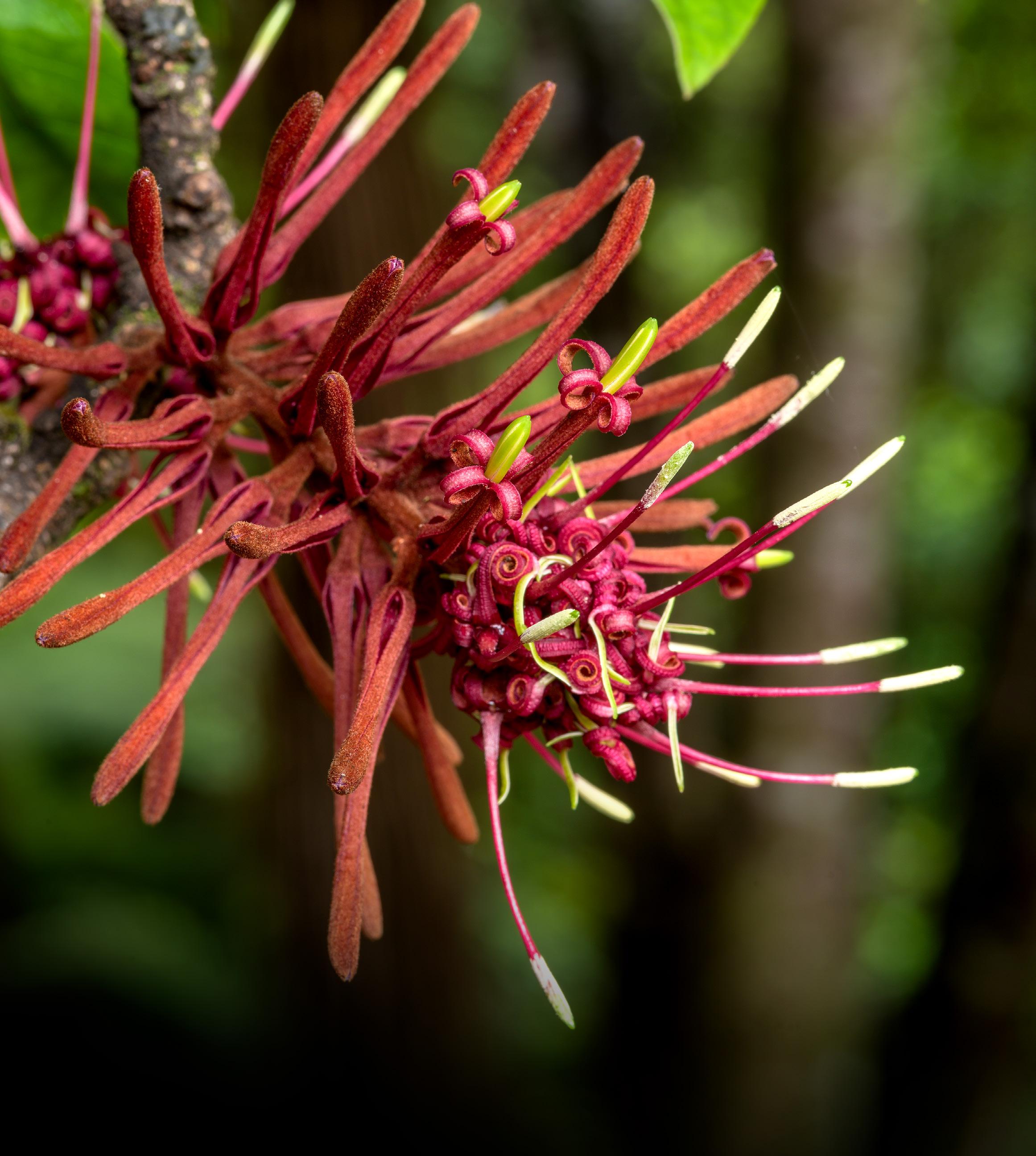

TE REO O TE TAIAO № 386 SUMMER 2022 NEW ZEALAND’S INDEPENDENT VOICE FOR NATURE • EST. 1923 PLANT POWER EXCITING eDNA DISCOVERIES GOING ON A FROG HUNT LOVE THEGulf




Forest & Bird is printed on elemental chlorine-free paper made from FSC® certified wood fibre and pulp from responsible sources. COVER SHOT Rewarewa also known as the New Zealand honeysuckle. Rob Suisted PAPER ENVELOPE Tītipounamu rifleman. Phototrip RENEWAL Kopakopa Chatham Island forget-me-not. Kyle Bland EDITOR Caroline Wood E editor@forestandbird.org.nz ART DIRECTOR/DESIGNER Rob Di Leva, Dileva Design E rob@dileva.co.nz PRINTING Webstar www.webstar.co.nz PROOFREADER David Cauchi ADVERTISING ENQUIRIES Karen Condon T 0275 420 338 E karen.condon@xtra.co.nz MEMBERSHIP & CIRCULATION T 0800 200 064 E membership@forestandbird.org.nz Thank you for supporting us! Forest & Bird is New Zealand’s largest and oldest independent conservation charity. Join today at www.forestandbird.org.nz/joinus or email membership@forestandbird.org.nz or call 0800 200 064 Every member receives four free copies of Forest & Bird magazine a year. Forest & Bird is published quarterly by the Royal Forest and Bird Protection Society of New Zealand Inc. Registered at PO Headquarters, Wellington, as a magazine. ISSN 0015-7384 (Print), ISSN 2624-1307 (Online). Copyright: All rights reserved. Opinions expressed by contributors in the magazine are not necessarily those of Forest & Bird. Contents ISSUE 386 • Summer 2022 Editorial 2 Now is the time 4 Letters + competition winners News 6 No new mines 7 Bird of the Year winner 8 We’re turning 100 10 Wanted! Wildlife artists, Room for Rivers, Oceans in Crisis 12 Helping Hands raises $1m, Papers Past boost, Stewardship land review Cover 14 Record-breaking rātā and other rare floral finds 16 Tiny Treasures Predator-free NZ 18 The road to PF2050 26 Talking about cats 38 Wallaby wipeout Biodiversity 20 The power of e-DNA 30 Saving kiwi one egg at a time 36 Gone but not forgotten Regular givers 23 Wetland warriors No new mines 24 Going on a frog hunt Marine 28 Love the gulf campaign Centennial celebrations 32 Forest & Bird’s Force of Nature concert Profile 37 Te Araroa Trail artist 24 7
Royal Forest and Bird Protection Society of New Zealand Inc. Forest & Bird is a registered charitable entity under the Charities Act 2005. Registration No CC26943.



PATRON Her Excellency The Rt Honourable Dame Cindy Kiro, GNZM, QSO Governor-General of New Zealand CHIEF EXECUTIVE Nicola Toki PRESIDENT Mark Hanger TREASURER Alan Chow BOARD MEMBERS Chris Barker, Kaya Freeman, Kate Graeme, Richard Hursthouse, Ines Stäger CONSERVATION AMBASSADORS Sir Alan Mark, Gerry McSweeney, Craig Potton DISTINGUISHED LIFE MEMBERS Graham Bellamy, Ken Catt, Linda Conning, Audrey Eagle, Philip Hart, Joan Leckie, Hon. Sandra Lee-Vercoe, Carole Long, Peter Maddison, Sir Alan Mark, Gerry McSweeney, Craig Potton, Fraser Ross,

CONTACT NATIONAL OFFICE Forest & Bird National Office Ground Floor, 205 Victoria Street Wellington 6011 PO Box 631, Wellington 6140 T 0800 200 064 or 04 385 7374 E office@forestandbird.org.nz W www.forestandbird.org.nz www.facebook.com/ ForestandBird www.youtube.com/ forestandbird @Forest_and_Bird @forestandbird CONTACT A BRANCH See www.forestandbird.org.nz/ branches for a full list of our 50 Forest & Bird branches. Freshwater 40 Restoring a remnant wetland on Aotea Great Barrier Island Education 43 Learning in nature Biosecurity 44 Is time running out for our myrtles? In the field 46 Time to sleep Year in review 48 Highlights and wins 2022 Going places 52 Family-friendly snorkelling and diving spots History 54 No bones about it BirdLife International 56 Criticals collection Urban conservation 57 Restoring the Great Swamp Books 58 Christmas reads + 20% discount Our partners 60 Spy Valley wines Community 61 Karamea calling Market place 62 Classifieds Last word 64 Counting the locals Parting shot IBC Pūweto spotless crake 46 52
Eugenie Sage, Guy Salmon, Lesley Shand
NOW IS THE TIME
This spring, Forest & Bird held in-person North and South Island Gatherings for the first time in three years. I’ve just returned from attending our Te Wai Pounamu event, and that reminded me how important it is to actually connect and meet in person.

It’s inspiring, it’s energising, it’s highly educational, and importantly it’s fun! We must never forget amid all our mahi for nature, we are humans, and joy is essential for our wellbeing and to sustain us.
As we return to our special wild places, it’s apparent pressure on the natural world did not stop during the Covid-19 lockdowns and endless Zoom meetings.
Sure, emissions dropped briefly during each lockdown, there were vastly fewer long-haul flights, and birds began to return to areas with less human disturbance. But this was but a brief hiatus, a chance for nature to catch its breath before the onslaught resumed.
As a nation, Aotearoa New Zealand lost an opportunity. With vision, we could have led the world and reset how we do things – a chance for an environmental reset, a tourism reset, a climate reset.
But our country’s leaders are resuming pre-Covid activities without pause to reflect. It’s business as usual, and the environment is the loser.

As New Zealanders united and made sacrifices to minimise the impact of the pandemic, some businesses who wish to exploit our ever-diminishing natural world were gathering forces.
We are faced with a complete about-face from the government over mining on conservation land and increasingly strong pressure to water down or scrap the Emissions Trading Scheme.
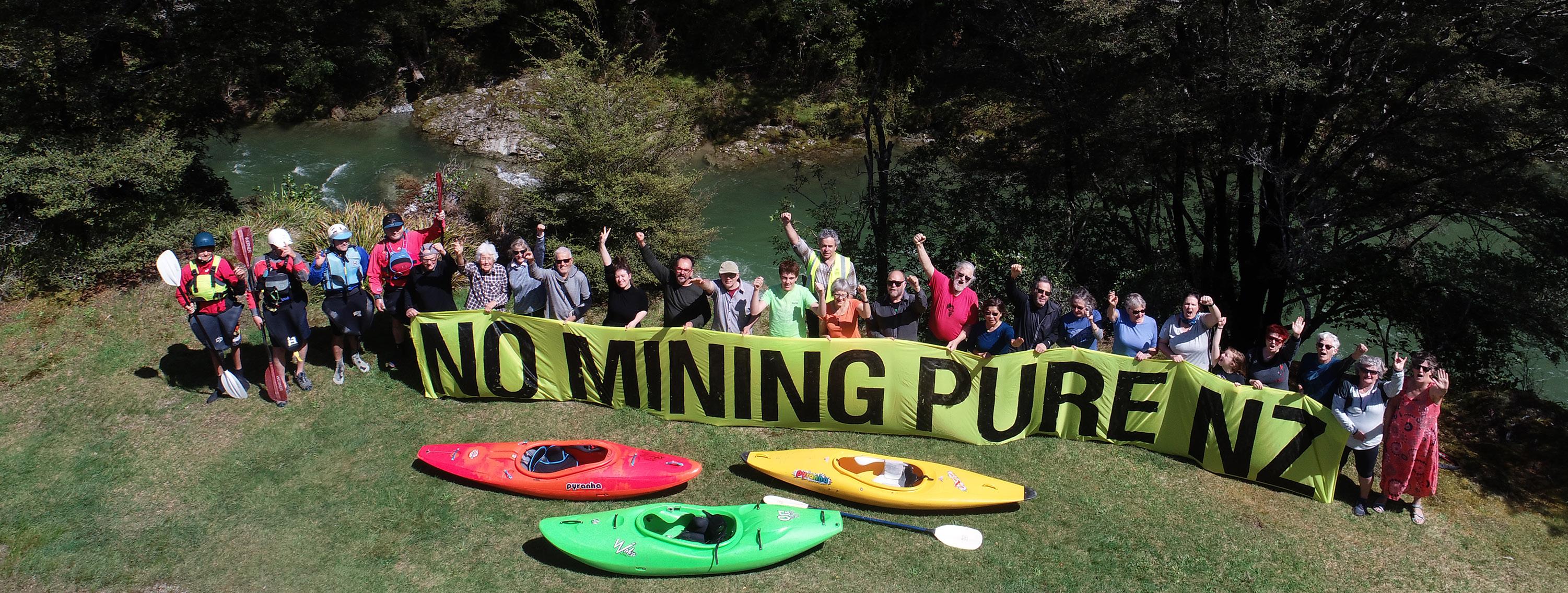
Terrible farm plans are being proposed that may not yield any improvement in the quality of our aquifers, streams, and rivers. Environmental degradation will
increase rather than decrease.
I have three young mokopuna wahine, and I worry about the world we are leaving them. Our tamariki are already angry at the mess we have made of the climate and environment.
As a society, we must not blunder on, repeating the same mistakes, leading to ever worse environmental disasters. We must leave a natural world that will allow our mokopuna to thrive.
At our in-person island gatherings, I learned about some of the incredible conservation efforts of Forest & Bird members all over the country. It gives me hope.
Rare and endangered species are thriving once again in our Forest & Bird Reserves, such as Bushy Park Tarapuruhi, near Whanganui, and Tautuku Ecological Sanctuary, in the Catlins (see page 14).
Our volunteer-led restoration work shows how nature can regenerate and recover – if given the chance.
Forest & Bird is leading the fight to stop the exploitation of nature, and we need your help more than ever.
Please write or speak to politicians and ask them to do more to protect and restore our climate and environment. All of us need to speak up for nature as loudly as we can. Now is the time.
Ngā manaakitanga Mark Hanger Forest & Bird President Perehitini, Te Reo o te Taiao
EDITORIAL
| Forest & Bird Te Reo o te Taiao 2
Forest & Bird’s banner tour reaches the top of the South Island (see page 6).
Heritage Expeditions are pioneers in environmentally-responsible small ship expedition cruising and industry leaders in sharing stunning natural wonders, incredible cultural exchanges, unforgettable wildlife encounters and wilderness adventures, and exploring historic sites with intrepid travellers. Travel is aboard our purpose-built, luxurious 140-guest expedition flagship Heritage Adventurer and 18-guest expedition yacht Heritage Explorer where guests enjoy sophisticated accommodation, gourmet fare and carefully crafted, unique itineraries led by a renowned team of botanists, ornithologists, naturalists, geologists, historians and experts.
• Primordial majesty of Fiordland

• Golden beaches & conservation sanctuaries
• Unforgettable wildlife encounters
• Includes excursions & house drinks with lunch & dinner 15 days, 6 Mar 2023 & 7 Mar 2024 NZ$13,725pp*

• Snares, Auckland & Campbell Islands
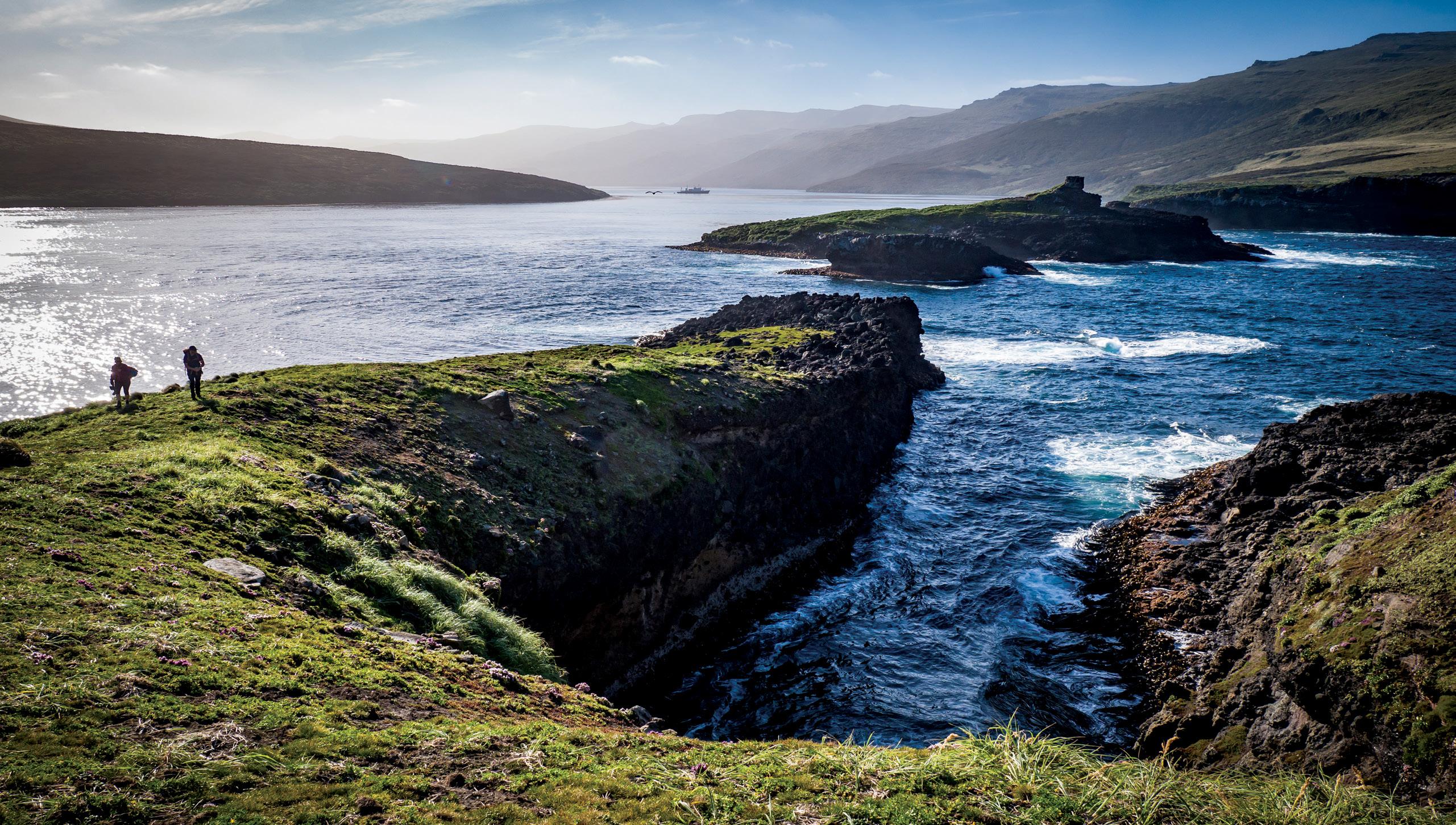
• 3 days exploring Fiordland
• Forest & Bird members save 5% AND support F&B’s initiatives

• Includes excursions & house drinks with lunch & dinner 12 days, 28 Dec 2022 & 20 Dec 2023 US$9,975pp*
• Learn firsthand about his world-leading work creating island sanctuaries on Little Barrier, Rangitoto and Motutapu Islands




• Photography masterclass
• Includes excursions & house drinks 8 days, 12-19 Feb 2023 NZ$7,225pp**
See our website for more incredible Kiwi adventures! WWW.HERITAGE–EXPEDITIONS.COM Freephone
info@heritage-expeditions.com
0800 262 8873
JOIN EXPEDITION CRUISE’S PIONEERS EXPLORING THE FURTHEST REACHES OF NEW ZEALAND ON A BUCKET LIST VOYAGE OF A LIFETIME © T.K raakman THE BEST OF NEW ZEALAND BEYOND FIORDLAND – F&B VOYAGE AWE-INSPIRING WILDERNESS
© L.Carlson © C.Todd
Queenstown Macquarie Island Queenstown Bluff Fiordland Stewart Island Dunedin Lyttelton Marlborough Sounds Nelson Wellington Napier Gisborne Great Barrier Island Bay of Islands Auckland Based on Deck 4 Superior twin share aboard Heritage Adventurer, 2022-23 pricing where applicable. Based on Salvin’s twin share aboard Heritage Explorer. Auckland Paihia Cavalli Islands Wangamumu Mokohinau Islands Great Barrier Island Whangaroa Harbour Helena Bay Poor Knights Islands Tiritiri Matangi Island
ADVENTURES
HAURAKI GULF WITH RICHARD GRIFFITHS
• Join Island Conservation’s Richard Griffiths
LETTERS
YOUR FEEDBACK
Forest & Bird welcomes your thoughts on conservation topics. Please email letters up to 200 words, with your name, home address, and phone number, to editor@forestandbird.org.nz, or by post to the Editor, Forest & Bird magazine, 205 Victoria Street, Wellington 6011, by 1 February 2023. We don’t always have space to publish all letters or use them in full.
Purple is the colour
“Dull and drab?” What can Ann Graeme be thinking of to describe our fungi, other than the peacock of the bunch Entaloma Hochstetteri in such a way (“Blue is the colour”, Spring 2022)? What could be more delightful than the olive and brown of the little “custard tart” or the “bird’s nest” fungi? Surely the striking yellow finger fungi gives even Entaloma a run for its money?
Marilyn Head, Wellington
Editor’s note: We agree! The writer was referring to a “family” of drab relations – the Entolmas, not the entire fungus kingdom, which is full of colour like this fabulous purple Cortinarius “small purple pouch”.

Weasly words
My hearts sings a sigh of relief when I read the Forest & Bird magazine – not because all is well but because Forest & Bird members are so dedicated. My New Year resolution was to read, really read, all the articles (two hours), and the breadth of knowledge and activities was staggering. Thank you. But Teall Crossen points out that New Zealand is using weasly words in the environmental arena where leadership is needed. Our country did not join the call for a seabed mining moratorium. We are instead going to have a “robust mining code, with high environmental standards”. Weasly words indeed. We also didn’t adopt a UN resolution to develop legally binding reductions in plastic production. Is it easier to be nice to people than to be true to the environment?
Bev Woods, Waipu
Model restoration project
Plastic action possible
Teall Crossen’s call for reducing plastic waste in our oceans through international treaties (Spring 2022) will take decades. But it’s easy to do something now. For several years I have offset my plastic footprint by supporting Plastic Bank (www.plasticbank.com). For US$50/year someone in a developing country is paid to collect the equivalent of my estimated 90.9kg plastic footprint, thereby giving them an income. If 80,000 Forest & Bird supporters did the same, it would stop the equivalent of 363 million plastic bottles being thrown into the sea. Now we are talking about making a difference.
Christopher Bennett, Takaka
I enjoyed reading the article on the L Anson Reserve at Te Puna (Winter issue). I am a frequent visitor to this reserve, and what has been achieved here is really outstanding. There has been concentrated weed and pest control, extensive planting of native trees, and construction of a new walking track. The lake and wetland are potentially a very significant habitat for fernbird and spotless crake, and other native birds, such as the North Island robin and kererū, are becoming established. All this has been achieved within 250m of one of the busiest state highways in the country. The work done to restore this area of lowland forest, and the high level of co-operation which has been achieved here should be a model for the restoration of other natural areas in the Bay of Plenty.
Peter Nixon, Tauranga
Why hunt ducks?
In my opinion, duck hunting is bad for our birds as it kills more than 200,000 native ducks a year. Most of these ducks are paradise shelducks, with more than 30% of the population killed each year. Then there are the Australasian shovelers that are declining because of duck hunting. Duck hunters claim that paradise shelducks are pests because they destroy farmland. The reason they go to farmland is because the wetlands are
Noah Siegel
| Forest & Bird Te Reo o te Taiao 4
being destroyed. They say they need to kill ducks to eat, which makes no sense because many ducks are left where they were killed. This proves duck hunters kill for fun. They also want the grey teal to be unprotected, and a lot of duck hunters also oppose the use of 1080.
Christian Cosgrove, Canterbury
Museum finds
I wanted to thank you for the article by Brian Gill in Issue 383. It alerted me to his book The Owl Who Fell from the Sky, which is delightful reading and very interesting indeed. An eye opener to what happens behind the scenes in a museum as well as the incredible journeys made by the specimens to end up in Aotearoa. There are many stories in there that I’m sure readers of the magazine would enjoy – particularly the ones relating to New Zealand species. Maybe you can include some in future issues with Brian’s permission. I’m now looking forward to getting hold of his next book The Unburnt Egg, to enjoy reading of more unusual stories behind the exhibits.
Jenny Studd, Wellington
Editor’s note: Check out page 54 of this issue for Brian Gill’s article about early taxidermists in Aotearoa.
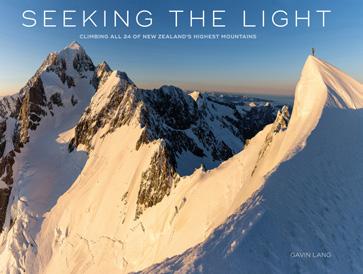


BUMPER BOOK GIVEAWAY
One lucky reader will win a holiday prize pack made up of these 10 newly released books (value $489), donated by New Zealand’s leading nature publishers Potton & Burton. For details of each book and how to get 20% off each title, see page 58.

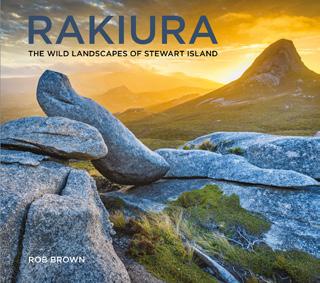



HOW TO ENTER
Email your entry to draw@forestandbird.org.nz and put BUMPER in the subject line. Please include your name and address in the email. Or write your name and address on the back of an envelope and post to the BUMPER draw, Forest & Bird, PO Box 631, Wellington 6140. Entries close 1 February 2023.
Dogs on beaches
My local beach Cheltenham is a heavily used tidal beach and attracts wading birds who rest and feed when the tide is low. It is also a beach which has increasing numbers of dogs using it. The bylaws regarding dogs on the beach have recently been changed to increase the amount of time dogs are allowed to roam unleashed on the beach. As is common in this city, dog ownership has skyrocketed, with subsequent higher numbers using this area. It appears many owners don’t know/don’t care about the rules, and my approaches to dog owners have been met with disbelief or downright hostility. Even when expressing my reasoning that the birds need time to rest and feed, the responses have been along the lines that “birds can fly”. I have approached the council about this matter and been referred to the local board, which I shall follow up. I guess my point is that just because a beach is there, it does not mean we necessarily have a right to use it whenever we want, or indeed at all in some cases. The environment is for us to share respectfully with all life that depends on it.
Judith Ashton, Auckland
CATS CATS CATS: Check out what Forest & Bird readers think about about the cat management act article in the last issue on page 26.
The lucky winner of a two-night stay at Bayview Treehouse, Christchurch, was

of Nelson. The winners of Life in the Shallows by Karen Denyer and Monica

were Valerie Wackrow, of
North, and Dan Farnham, of Kerikeri.
20% READER DISCOUNT
Linda Ballard,
Peters
Palmerston
5 Summer 2022 |
NO NEW MINES
Just over a decade ago, 40,000 New Zealanders marched down Auckland’s Queen Street to protest the then government’s plans to open up more public conservation land for mining.
In the throng of New Zealanders, a young Labour MP called Jacinda Ardern brandished a giant red placard emblazoned with the slogan “Ours. Not mines”.

Ardern became Prime Minister, and in 2017 she promised to ban mining. In the Speech from the Throne – a declaration of the government’s vision and intent for Aotearoa – nine words stood out: “There will be no new mines on conservation land.”
Five years on, and that promise remains unfulfilled. Mining activities on conservation land continue to be approved, including exploratory drilling for tungsten near Glenorchy, gold exploration in the Coromandel, and permits granted across Northland, Rotorua, and the West Coast to a billionaire Aussie mining magnate.
Without legislative change, more is set to come, including a proposed mining expansion on conservation land near Reefton that would lock us into coal mining right into the 2040s.
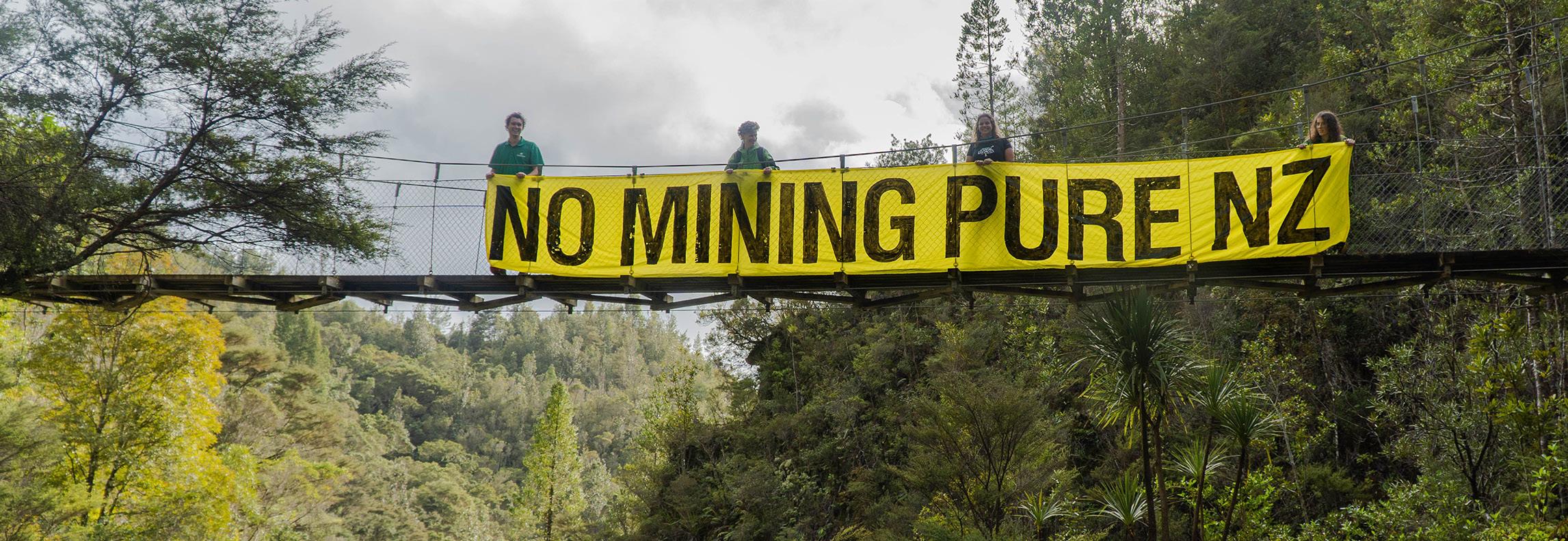
Fortunately, the government now
has a chance to fulfil its promise. In September, the Crown Minerals (Prohibition of Mining) Amendment Bill was drawn from the members’ Bill biscuit tin ballot.
Proposed by Eugenie Sage MP, the Bill would ban new mines on conservation land and prevent new coal mining permits on any land from 2025.
As soon as the Bill was drawn, Forest & Bird launched into action to support its passage through Parliament. With Greenpeace’s help, we recreated the enormous No Mines banner that led that march down Queen Street.
We took the banner on a national tour of sites at risk from mining, including parts of the Coromandel and the Denniston Plateau.
In October, Forest & Bird met with Conservation Minister Poto Williams on the West Coast to brief her about some of the precious taonga that would be lost if mining continues to be allowed on conservation land.
And we created a series of billboards asking New Zealanders to support our No New Mines campaign.
The success or failure of this Bill is an important test of Minsters’ commitment to meet our country’s climate change targets.
Allowing mining on public conservation land – often carbonstoring forests or wetlands – is inconsistent with the government’s Emissions Reduction Plan and the National Adaptation Plan.
If we want a liveable future for our tamariki and mokopuna, the transition from mining needs to start now.
The Prime Minister has been saying “no new mines on conservation land” for years.
Banners, billboards, and Ministerial meetings, it’s all go for our campaign to ban new mines on conservation land. ☛
Today, you can tell her it’s time for action! Please give generously to help protect the conservation land you love from destruction at https://www.forestandbird.org. nz/no-new-mines
We’re going on a frog hunt in goldmining country – see page 24.
NATURE NEWS
Jacinda Ardern at the 2010 march Greg Presland
The Forest & Bird team, in Coromandel Forest Park, October 2022. George Hobson
| Forest & Bird Te Reo o te Taiao 6
IT’S A WRENAISSANCE
It’s official, New Zealanders love an underbird! The tiny pīwauwau rock wren has been crowned supreme winner of Te Manu Rongonui o te Tau 2022.

The two-week Bird of the Year competition was filled with creative campaigning, kākāpō controversy, and even a threat of legal action to let an extinct bird join the line-up. A total of 51,856 votes were cast.
But the wren reigned supreme – with pīwauwau receiving 2894 number 1 votes – about 450 fewer than the kororā. But, once the transferable votes were applied, the pīwauwau ultimately rocked the top spot.
“It proves New Zealanders love an underbird. It’s been awesome to see Kiwis get to know some of their lesser-known feathered neighbours,” says Forest & Bird chief executive Nicola Toki.
Rock wrens live above the bushline in the Southern Alps, bobbing and hopping between rocks rather than flying. Like many range-restricted species, they’re threatened by pests and climate change.
“A vote for pīwauwau is a vote for climate action,” added Nicola. “As Aotearoa’s only true alpine bird, these tiny wrens are already feeling the impacts of warmer temperatures, which allow predators like rats and stoats to climb higher and invade their mountaintop homes.”
Stephen Day led the pīwauwau campaign with Lauren Schaer and the team at Herenga ā Nuku, the Outdoor Access Commission.
"Unless you’d spent some time in the mountains, you’d probably never heard of a rock wren until two weeks ago. It’s a true underbird,” said Stephen.
THE TOP 10 FINISHERS
(with number 1 vote count in brackets)
1 Pīwauwau | rock wren (2894)
2 Kororā | little penguin (3351)
3 Kea (1852)
4 Karure/kakaruia | Chatham Island black robin (1594)
5 Tawaki piki toka | rockhopper penguin (1468)
6 Pīwakawaka | fantail (1228)
7 Hihi | stitchbird (1302)
8 Kārearea | New Zealand falcon (1260)

9 Pūteketeke | Australasian crested grebe (1184)
10 Titipounamu | rifleman (1477)
“We’re so happy pīwauwau are finally having their time in the spotlight. The team here have enjoyed getting a bit silly with the memes and, of course, the rap video Wrenegade!”
Nationally endangered, rock wrens are one of two surviving species, along with titipounamu riflemen, from an ancient wren lineage unique to New Zealand.
Forest & Bird thanks our volunteer campaign managers and everyone who got behind in the Bird of the Year fun. And a big shout out to our corporate supporters: Allbirds, Blunt Umbrellas, Bennetto Chocolate, Honeywrap, Metalbird, and Thunderpants.
 TOP OF THE ROCKS: Bird of the Year 2022 winner pīwauwau rock wren is king of the Southern Alps.
Craig McKenzie
TOP OF THE ROCKS: Bird of the Year 2022 winner pīwauwau rock wren is king of the Southern Alps.
Craig McKenzie
7 Summer 2022 |
WE’RE TURNING 100!
A year of Forest & Bird celebrations will kick off in March 2023. Here’s a sneak preview of the theme and some of the events already under way.
The theme for the upcoming Centennial Celebrations is “What is your legacy?”, and we can’t wait to start sharing stories and connecting with each other.
Most New Zealanders love nature – it’s part of who we are.
During 2023, we hope to encourage thousands of small actions to help protect and restore our environment.
There are lots of ways people can leave a legacy for nature, including volunteering at a local conservation project, signing a petition, or making a donation or bequest.
They could also encourage their friends and family to join Forest & Bird or KCC and create thousands of new voices for nature during 2023, a critical election year!
In March 2023, we will launch a varied and exciting 12-month centennial programme for members and supporters of all ages to enjoy, including national, local, and online events.
As well as reflecting on Forest & Bird’s history and impact, there will also be plenty of opportunity to think about the future of conservation and what that might look like.
Forest & Bird’s chief executive Nicola Toki says she can’t wait for the centennial celebrations to kick off. She is looking forward to a series of thought-provoking, fun, and family-friendly activities.
“Being an independent voice for nature and coming up with worldleading ideas and solutions is in our Society’s whakapapa,” she said. “That’s the legacy our founder Val Sanderson left New Zealanders, and it’s one reason why I wanted
to join Forest & Bird.
“Sanderson was passionate about saving the birds and the bush for future generations, especially children, to enjoy. In the 1920s and 30s, he and his fellow volunteers promoted science-based ideas and solutions that were well ahead of their time.
“This included campaigning to stop deer devastating New Zealand’s ancient forests, warning that bush clearances would lead to land erosion and river pollution, and educating his membership about the need to understand how Māori viewed nature and their role in conservation of our special wildlife and wild places.”

As well as celebrating the contribution volunteers have made to nature protection over the past 100 years, we plan to use our 100th birthday to help raising awareness of Forest & Bird’s work, strengthen existing relationships, and make new ones.
In March, the premiere of the Force of Nature concert will be held in Auckland Town Hall. This unique musical celebration of Forest & Bird’s conservation mahi is

NATURE NEWS
| Forest & Bird Te Reo o te Taiao 8
Forest & Bird founder Captain Val Sanderson planting trees, Kāpiti Island. John Barrett collection
being staged at the Auckland Arts Festival (see page 32 for details).
We are working with New Zealand Post and wildlife artist Rachel Walker on a series of Forest & Bird centennial stamps and memorabilia. The stamps will feature four original artworks celebrating the natural landscapes and wildlife of Aotearoa. These will be launched on 1 April 2023.
The following month, we will be paying tribute to Val Sanderson as a founding father of modernday conservation. Volunteers from Ngā Uruora Kāpiti Project are organising the official opening of Sanderson’s Way in the restored Waikākāriki Wetland, Paekakariki. The weekend’s events will include an exhibition celebrating local conservation in the village where Sanderson lived and worked while running Forest & Bird.
During 2023, New Zealand writers and artists will be visiting Forest & Bird reserves and projects

up and down the country for the 26 Centennial Writers’ Project (see overleaf).
Our history project team has been documenting Forest & Bird’s whakapapa over the past three years, and we will feature a series of articles focusing on the Society’s work and impact in this magazine during 2023. The highlights of our history are due to be published in a legacy book in March 2024, ending a year of centennial celebrations. As well as celebrating 100 years of being the voice of nature for Aotearoa, it will pay tribute to many unsung environmental heroes and look forward to the future of conservation.
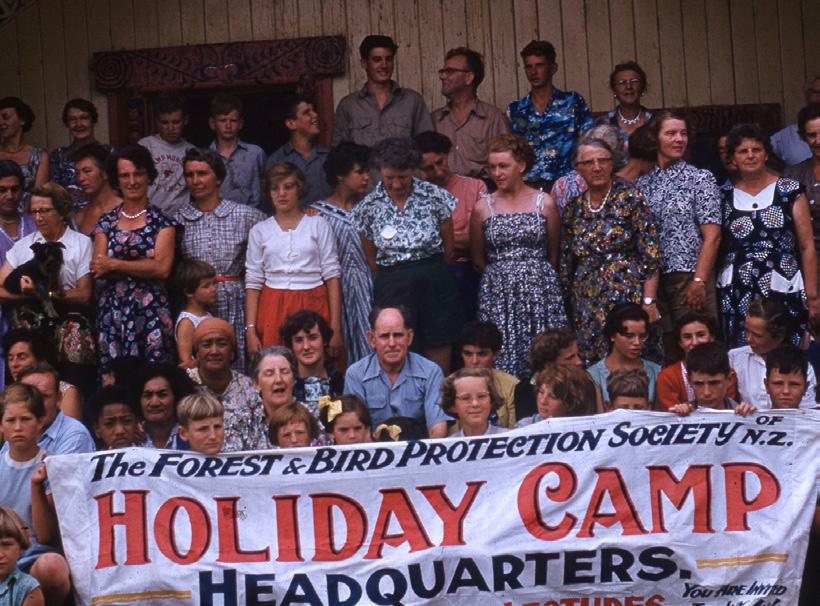
“This is a pivotal time for Aotearoa as we have a national conversation about who we are as a nation and why it matters,” added Nicola.
“Our natural heritage is a key part of our national identity. Even today, when most of us live in towns and cities, we still deeply define ourselves by our wild places
and wildlife. That’s unusual and very powerful.
“The country is wrestling with the twin impacts of climate change and the loss of biodiversity, and how to respond. Forest & Bird needs to be at the table for this conversation because the naturebased solutions we champion are key to our country’s future.”
There are many other exciting centennial events in the pipeline. Keep an eye on your email and future issues of Forest & Bird and Wild Things for details of what’s coming up and how you can get involved.
Find a path to ethical investing You want expert advice to help you reach your financial goals. You also want to invest ethically – supporting industries that enhance sustainability while avoiding those that damage the environment or society. At Ethical Investing NZ, we offer ongoing financial guidance from advisers who share your values. We’ve been recognised as the 2022 Mindful Money Best Ethical Financial Adviser. Now, let’s see what we can do for you. Call 09 337 0997 or find out more at ethicalinvesting.nz
A Forest & Bird family camp, Rewarewa Marae, Te Urewera, January 1959.
Carew Falls track, Lake Brunner, South Island, Aotearoa
WANTED! WILDLIFE ARTISTS
Are you a talented artist, illustrator, cartoonist, or nature photographer?
We need 13 creative conservationists to help mark Forest & Bird’s 100th birthday next year.
We are teaming up with our friends from the 26 NZ writers group for an exciting Centennial Celebrations project. The aim is to pay tribute to 100 years of Forest & Bird’s conservation volunteers and the special landscapes and species they help look after.
Thirteen professional New Zealand writers will be matched with artistic partners for the project. Each pair will be invited to visit a Forest & Bird conservation project or reserve and use this as the inspiration for their writing/artwork.
The locations are being kept under wraps for now, but they will feature a diversity of landscapes, habitats, history, and of course be home to many native birds, lizards, and bats.
Through the power of words, the 13 writers will bring these conservation efforts to life by creating a 100-word “centena” that must start and finish with the same three words. They will also write a short essay inspired by the landscape and/or the people caring for it.
Each centena will be accompanied by an artwork like the beautiful poster (above) that was created by Roz Paterson for last year’s 26 NZ Habitats writing project.

“Our writers are part of a vibrant international writing community that uses the power of words to advocate for change,” says Paul White, of 26 NZ, who, with Jayne Workman and Jane Berney, will lead the project.
“We loved working with Forest & Bird on 26 NZ Habitats last year and sharing the writers’ powerful works during the COP26 climate conference.
“New Zealand has some incredible wildlife artists, and we’d love to collaborate with some of them on this exciting national writing project.”
Each centena, artwork, and essay will be published in Forest & Bird magazine from next September. An in-person event, where the writers and artists will share their centenas and artworks with a specially invited audience, is also being planned. And all the work will be published on a dedicated 26NZ website.
What will your nature legacy be in 2023? Join our 26 NZ centennial project and find out! To volunteer, please email c.wood@forestandbird.org.nz by 15 December 2022. For more about 26 Habitats, see https://26project.org. uk/26habitats/
ROOM FOR RIVERS
Thank you to everyone who shared their stories for our new report Tukua ngā Awa kia Rere | Making Room for Rivers
In November, Forest & Bird launched a campaign calling on the government to include Making Room for Rivers in its climate and resource management legislation.
This modern nature-based solution has been successfully used overseas to reduce flood risk, return rivers to health, restore carbon-capturing wetlands, and provide more habitat for nature and recreation.

Our campaign is supported by Aki Paipper (Ngāti Hori), who talks about how her local river, the Ngaruroro, in Hawke’s Bay, fell silent after it was diverted away from Kohupātiki Marae.
The original waterway suffered a catastrophic decline in health, and the river’s once abundant pātiki black flounder and tuna longfin eel disappeared.
“We don’t take our children to swim and connect with the river in the same way. For me, it’s a cultural disconnect,” said Aki.
More than 100 towns and cities across New Zealand have communities living alongside rivers or on flood plains protected by flood protection schemes.
Many stopbanks need expensive multi-million-dollar upgrades to cope with more frequent and intense
NATURE NEWS
Aki Paipper remembers how the Ngaruroro River was full of kai before it was modified and diverted away from her marae. Iain McGregor/Stuff
| Forest & Bird Te Reo o te Taiao 10
rainfall events. And, as the planet warms, more parts of Aotearoa will become susceptible to flooding.
But there is another way of mitigating risk, a cheaper alternative to the current hard-engineered solutions that straighten and deepen our rivers, making them more dangerous when they do flood.
Room for Rivers has been successfully used overseas, and Forest & Bird has put together a special report explaining what it is and how it works.
“We’re hoping to spark a national conversation about the benefits of making room for rivers,” explained Forest & Bird’s freshwater advocate Tom Kay.
“Forest & Bird would like to see the government establish a national Room for Rivers plan and a contestable $500m fund to support councils to undertake suitable projects.”
A free copy of the report is included with your printed Summer magazine. For more information or to download a digital version, go to www.forestandbird.org.nz/ roomforrivers
OCEANS IN CRISIS
Anew report on the state of our seas makes sobering reading. Our Marine Environment 2022, compiled by Statistics New Zealand and the Ministry for the Environment, reveals that pollution, fishing, and plastics continue to harm the seas around Aotearoa.
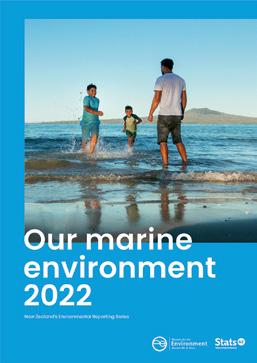

According to the report, 90% of indigenous seabirds, 82% of shorebirds, 81% of assessed marine invertebrate species, and 22% of marine mammal species are classified as threatened or at risk of extinction. The 2019 version of the report painted a similarly depressing picture.
“As an island nation, we depend on the health of our ocean ecosystems,” said Forest & Bird chief executive Nicola Toki.
“The fishing industry is already suffering the effects of our sick oceans, with dying salmon stocks and collapsed hoki and crayfish populations.
“This is urgent. All political parties and Ministries need to take decisive action to give all marine life the protection it deserves.”
Adding to the pressure, seas are warming and becoming more acidic because of greenhouse gases, and sea-level rise is happening faster than expected.
Lack of research means the true scale of the crisis could be worse.
There has been some recent progress, thanks to advocacy by Forest & Bird and other eNGOs, including the National Plan of Action on Seabirds, a Threat Management Plan for Māui and Hector’s dolphins, and the launch of Te Mana o te Taiao, New Zealand’s biodiversity strategy.
“Nature-based solutions, such as dune and mangrove restoration, will help coastal communities combat sea-level rise,” added Nicola.
Here are six other priorities Forest & Bird believes the government and councils should be focusing on:
n Ending seabed mining and bottom trawling.
n Cutting greenhouse gas emissions by stopping new coal mines and pricing agricultural emissions.
n Reforming fisheries management, focusing on ecosystem-based management and zero bycatch.

n Developing a programme to stop plastics from reaching the ocean.
n Cleaning up rivers, and stormwater and sewage systems, to stop coastal pollution.

n Managing nutrient, sediment, and pathogen pollution from agriculture.
See page 28 for how you can help heal the Hauraki Gulf.
Illustration 1870 by Frank Edward Clark
☛
11 Summer 2022 |
HELPING HANDS HITS $1M
Home entertainment specialist JB Hi-Fi has reached a huge landmark with its Helping Hands staff payroll-giving programme – raising an incredible $1 million a decade after it launched.
Since 2012, JB Hi-Fi’s generous employees have donated more than $200,000 to Forest & Bird through payroll giving, as we are one of six charities the company has chosen to work with.
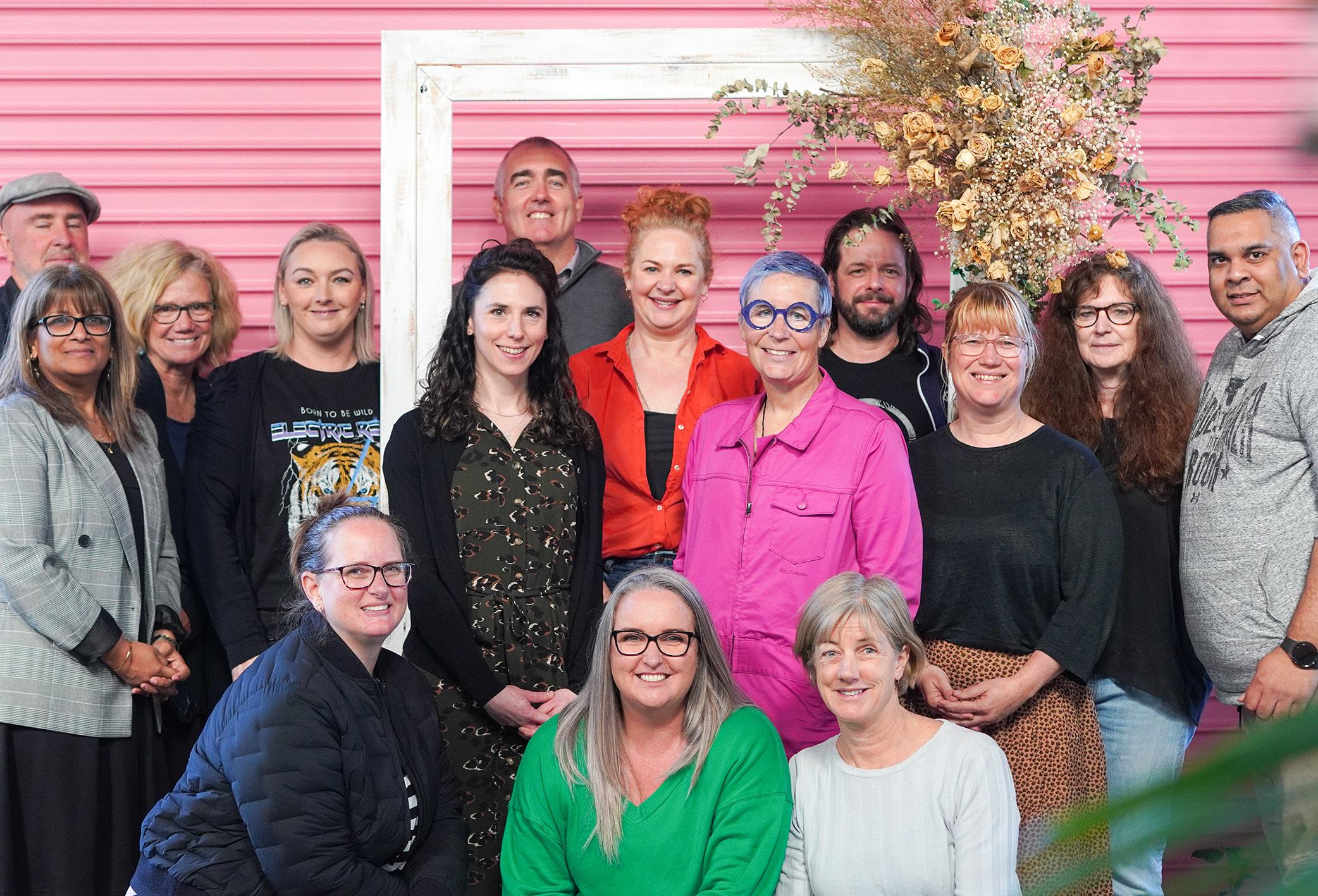
To mark the milestone, managing director Tim Edwards and national support manager Christine Gallagher hosted a breakfast event in Auckland for the six charity partners. Forest & Bird was represented by Jo Prestwood and Alexandra Moyes from our fundraising team.
“We’re delighted to have donated $1m to the causes we love, including Forest & Bird,” said Christine Gallagher. “Payroll giving allows our employees and our business to contribute to our chosen charity partners and make a positive impact in our community.”
Have you thought about making payroll giving available to your staff? With our 100th birthday coming up next year, it could be a timely way to help protect and restore New Zealand’s unique wildlife.
To find out more about payroll giving and Forest & Bird, contact our corporate fundraiser Alexandra Moyes at a.moyes@forestandbird.org.nz
The trust provides financial support for projects advancing the conservation and protection of New Zealand’s natural resources, particularly flora and fauna, marine life, geology, atmosphere, and waters.

More information is available from the Trust at PO Box 10-359, Wellington.
DIGITISING 100 YEARS OF MAGAZINES
Afurther 30 years of Forest & Bird’s magazines have been added to the National Library’s Papers Past website – covering the years 1946 to 1975.
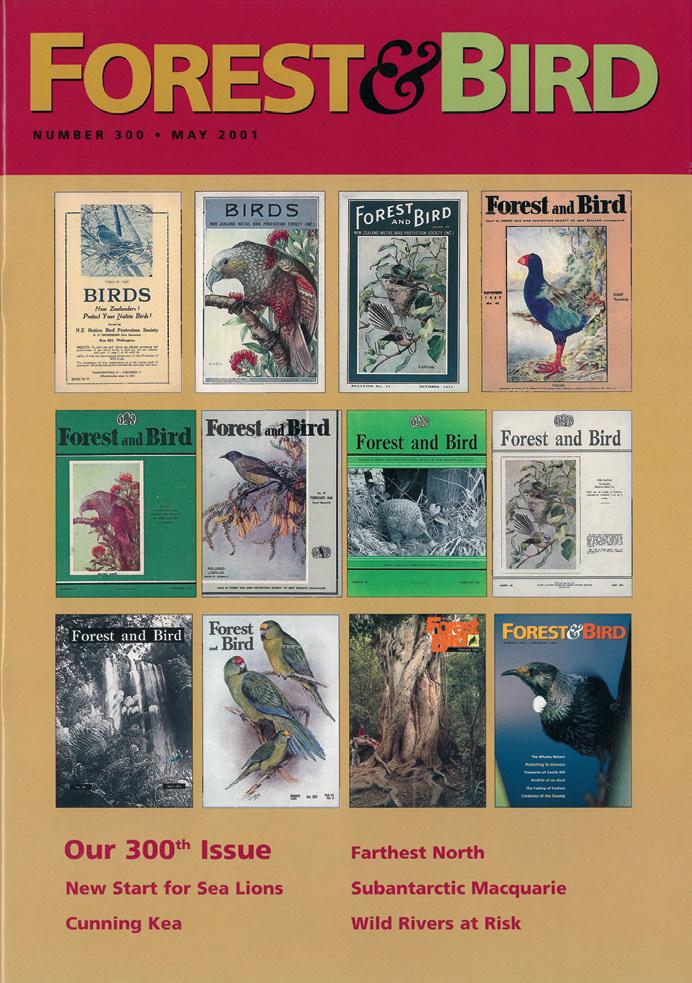
The first 50 years of our magazine are now freely available on Papers Past to anyone interested in 20th century environmental history, including historians, students, genealogists, and schools.
Founder Captain Val Sanderson established a quarterly “journal” in 1924 so he could campaign on the issues of the day and communicate with his fledgling society’s membership.
He edited more than 70 issues of the magazine, which grew in size and mana over the decades. Today, it is one of the oldest magazines in the country – and the longest-running conservation title.
“We really appreciate the support of Te Puna Mātauranga o Aotearoa the National Library of New Zealand
NATURE NEWS
Ron and Edna Greenwood
Environmental TRUST
| Forest & Bird Te Reo o te Taiao 12
in securing this important historical resource for future generations,” said Forest & Bird chief executive Nicola Toki.
“This has been a huge labour of love for our Force of Nature project team, supported by two volunteers, to seek copyright approval from the authors of every article and image so these wonderful magazines could be digitised.
“Together, they tell the rich whakapapa of our organisation, its supporters, and the wider environmental history of Aotearoa New Zealand.”
You can search for specific people, places, or species or click on an issue and read each page as it was originally laid out. A big Forest & Bird thank you to the National Library’s Melanie Lovell-Smith and Charlotte McGillen, and also our history project volunteers Gyle Bascon and Rosa Pillay.
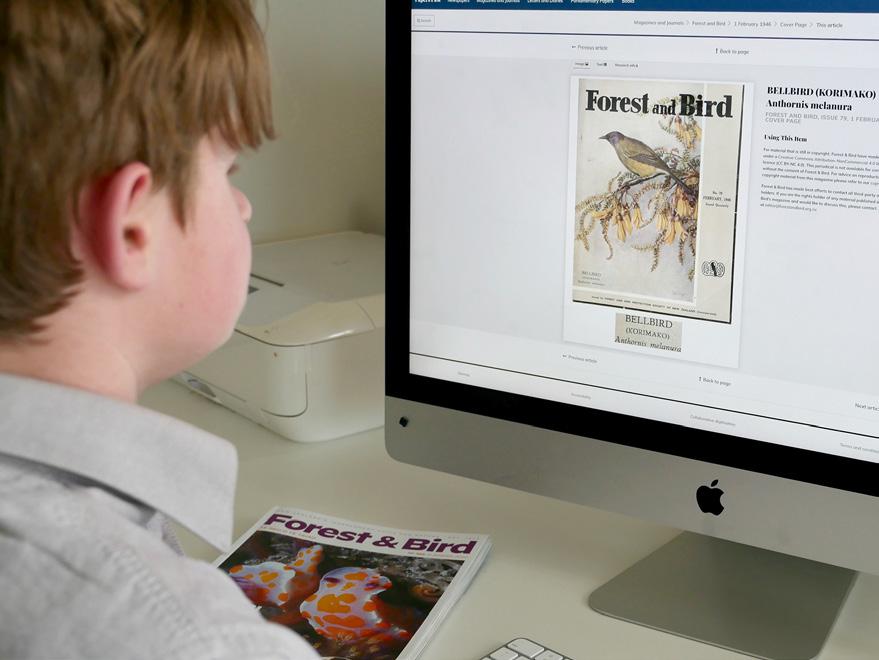
This is part of an ongoing project to digitise all 100 years of Forest & Bird’s magazines. So far nearly 70 years are available online. Just another 30 years to go!
Check out Papers Past at https:// paperspast.natlib.govt.nz/ periodicals/forest-and-bird/1946
The most recent issues of Forest & Bird, from 2005 on, are available at www.issuu.com/forestandbird.
STEWARDSHIP LAND REVIEW
In our last issue, we reported how Forest & Bird’s staff, branches, and supporters were busy responding to the government’s proposed reclassification of nearly 645,000ha of West Coast stewardship land.
After the Spring issue went to print, Forest & Bird provided comprehensive written feedback on the proposed changes and travelled to the West Coast to give an oral submission at a special panel hearing.
In October, Forest & Bird met with Minister of Conservation Poto Williams and West Coast MP Damien O’Connor to express concerns with the stewardship land review.
Sadly, in our view, the proposals give limited legal protection to the vast tracts of conservation stewardship land under review. For example, contrary to popular belief, the proposed changes will not protect this West Coast land from future mining – in fact, only 12% will be covered.
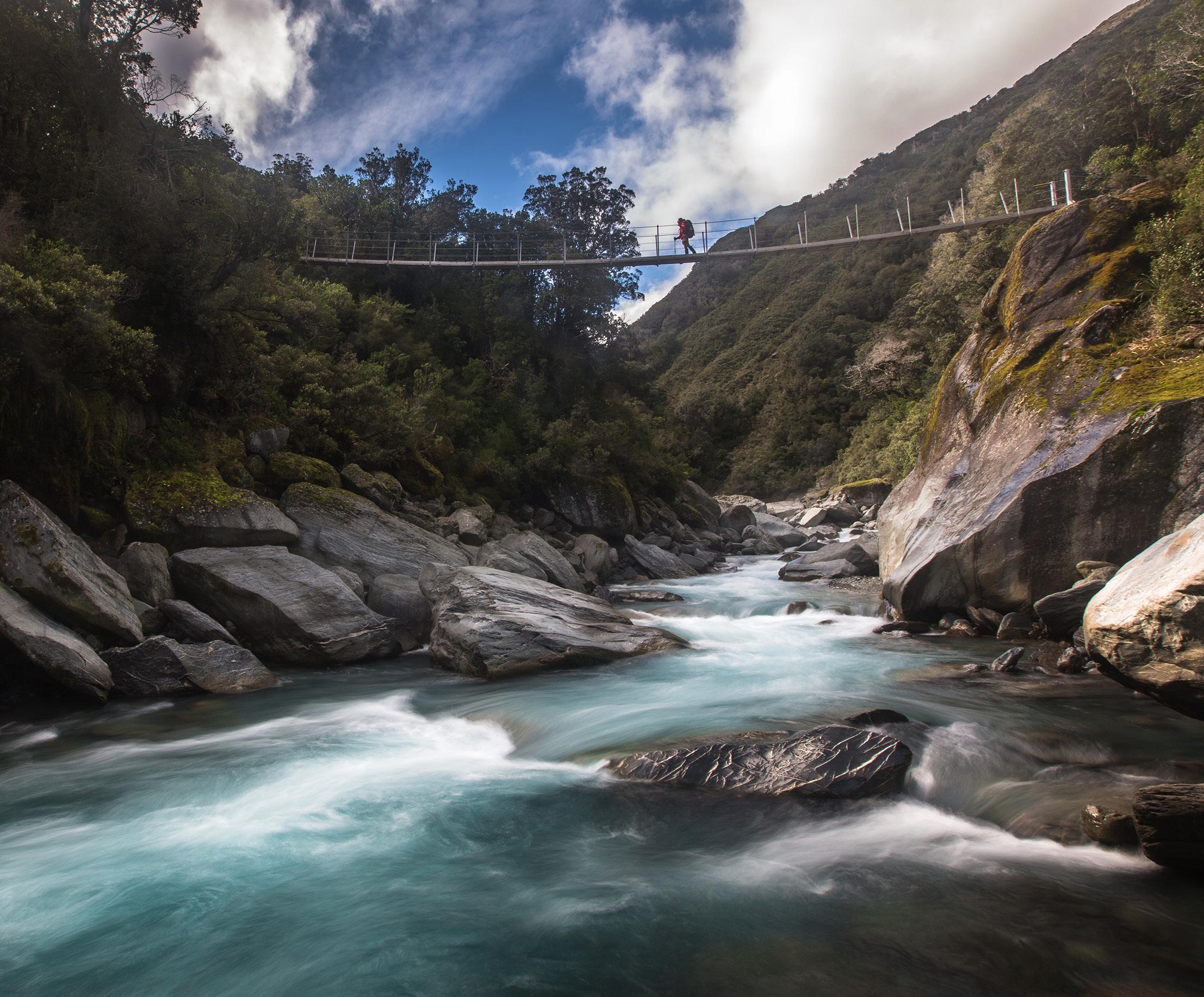
The whole project has been a mammoth task for those who wanted to give detailed, considered feedback, given the 500+ land parcels under consideration and the tight time frames imposed by the government.
From the outset, Forest & Bird was concerned about the process, including an extremely short time frame for lodging submissions, which was extended at the 11th hour following criticism from the Society and others.
The government also failed to provide critical information to the public so they could make an informed decision on the proposals, including the purpose of the reserves and the criteria the panel used to make its recommendations.
“The indecent haste associated with the submission and hearing process gives the impression that the main concern is to get the review done as quickly as possible,” wrote Forest & Bird’s lawyer Peter Anderson in our submission.
“It also gives the impression that the opinions of submitters are of little consequence. A consequence of this is that Forest & Bird seeks that the process is reset.”
Our feedback was well received by the panel, and we look forward to hearing their response to our concerns.
13 Summer 2022 |
Crossing the Mungo River, Wanganui Otira catchment, West Coast. Neil Silverwood
GIANT DISCOVERY
A mammoth tree was recently found in Forest & Bird’s Tautuku Ecological Restoration Project area. Could this southern rātā be a record-breaker?
Caroline Wood
You can’t protect something if you don’t know it’s there,” is one of conservation’s truisms. It’s also the case that scientists are regularly discovering new species of flora and fauna in Aotearoa. In some remote areas, it’s a question of “seek and ye may find”.
Down in the Catlins, Forest & Bird’s Tautuku Ecological Restoration team has been taking a closer look at some of the botanical delights located in their huge 6600ha project area that runs from the forested hilltops near Papatowai to the Southern Ocean.
And, goodness, have they come up with some wonderful floral finds recently, including a tiny Nationally Critical creeping foxglove (see overleaf).
Let’s start with the discovery of a giant southern rātā, thought to be 700 years old. With a trunk diameter of just over four metres, our experts believe this could be the largest southern rātā in in the South Island and therefore the world!
This possibly record-breaking Tautuku tree came to the project team’s attention in 2020 at the height of the Covid pandemic.
During a winter gecko survey in the Tautuku River valley, Forest & Bird’s pest control officer Gavin White and herpetologist Carey Knox stumbled across an extremely large southern rātā (Metrosideros umbellata).
It is located on conservation land in a remote part of the project area, far from any formed tracks. The forest in the immediate area contains a large number of huge rātā trees; however, this one was significantly bigger.
Photos and a description were sent to botanist and Forest & Bird Southland Branch stalwart Brian Rance, who works for the Department of Conservation at
Murihiku. He expressed interest in viewing the huge tree and confirmed it was worth measuring.
Gavin and Forest & Bird’s Tautuku project manager Francesca Cunninghame returned to the site, on a wet and cold low ridge, with a suitably long measuring tape.
“The whole ridgeline is full of large rātā of all angles, shapes, and sizes. They are part of the landscape,” said Francesca. “But this tree appears through the undergrowth and makes people stop in their tracks and take a second look.
“We arrived at the site and saw this wizened gnarled old tree at an angle, and there was no question about it – it was much larger than all the other huge rātā we had passed.”
Their initial measurements suggested it was comparable to two recognised giant northern rātā (M. robusta) – Rātānui, in Forest & Bird’s Tarapuruhi Bushy Park Sanctuary, near Whanganui, and the Karapoti rātā in the Tararua Ranges, north of Wellington.

Francesca called in the experts to help figure out just how big the tree is and whether it could be a recordbreaker.
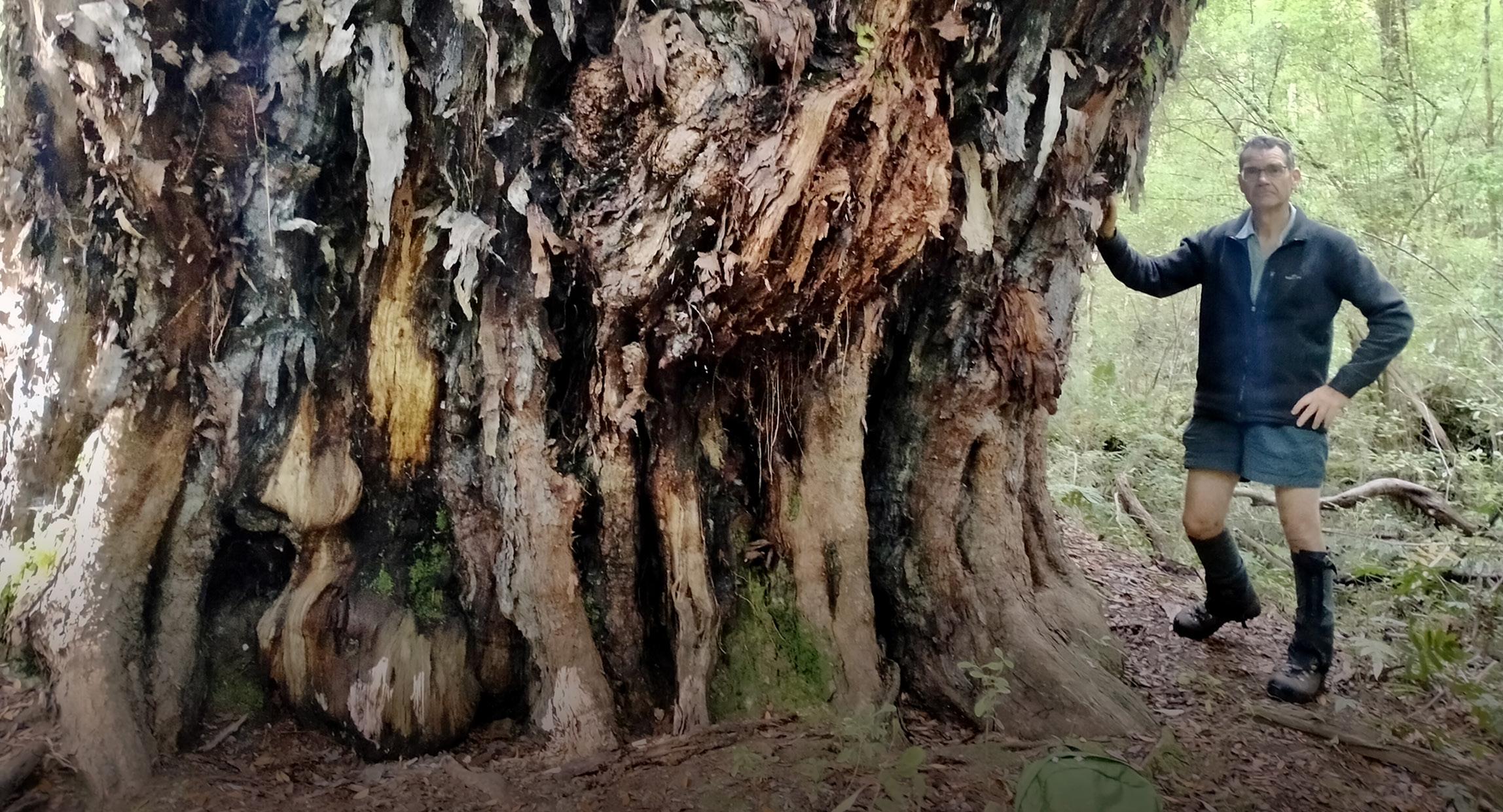
COVER
Brian Rance dwarfed by the southern rātā estimated to be 700 years old. John Barkla
“
| Forest & Bird Te Reo o te Taiao 14
Gavin White admires the massive Tautuku southern rātā. Francesca Cunninghame
Earlier this year, botanists Brian Rance and John Barkla, together with Gavin White, carried out two plant surveys of the mid-Tautuku catchment, including a close inspection of the giant rātā.
The pair measured its diameter at breast height (dbh) of 4.036m and estimated it to be more than 30m tall, with the top of the tree emergent above the kāmahi canopy.


Rātā are recorded to live up to 500 years. However, this massive tree is almost certainly older. In fact, Brian thinks it may more than 700 years old!
“This tree is larger than any southern rātā in the New Zealand Tree Register. Is it the largest southern rātā in the Catlins, Southland, or possibly New Zealand?” John and Brian concluded in a summary of their survey report.
The giant rātā had 22 different plants growing on it, including nine shrubs and trees – kāmahi, rimu, miro, broadleaf, three finger, haumakoroa, matipo, stinkwood and Coprosma colensoi, 11 different ferns, bush flax (Astelia fragrans), and Easter orchid.

What now for Tautuku’s giant rātā? We’ve thrown down the gauntlet and asked the question: Could this be the largest southern rātā on the planet? Write to us if you know of any bigger – email editor@ forestandbird.org.nz
TURNING THE TRAMWAY



There is another special rātā in Forest & Bird’s project area, on Department of Conservation land about 170m outside the Lenz Reserve boundary. It has creamy white flowers and is known locally as the “white rātā”. It survived being chopped down in 1935, when a tramline was being built deep into the forest to allow woodcutters access. The men building the tramway noticed the white rātā and decided to build the tram tracks around it so it wouldn’t have to be cut down. You can still see the lean in the old sleepers at that exact spot today. ☛More exciting floral finds – see overleaf.

Australia’s Northern Territory & Kimberley 2023 TOURS 2024 TOURS Spaces limited. Please book early & join wait lists. MAY JUN JUL JUL JUL AUG AUG Kimberley Nature Photography Workshop 9 Days Photo Workshops: Wild Kakadu, Top End 5-6 Days Birds & Wildlife, Untamed Arnhem Land Tropical Bird Photography Tour 8 Days Top End Finch Frenzy Ex. Darwin 7 Days Ultimate Top End Birding Adventure 10 Days Top End Finch Frenzy Ex. Darwin 7 Days North Australian Outback Birding 8 Days World-Class Birding Experiences, Local Expertise NT Bird Specialists Birding & Photographic Safaris Specialist Team • 5 Star Reviews • Small Groups & Private Charters •Luxury Touring Vehicles • 36 years Professional Experience •Target Species Missions • Private Cruises & Access •Fully accredited & permitted operators Join renowned specialist guide Luke Paterson on award-winning birding & photographic tours in northern Australia. tours@NTBirdSpecialists.com.au / 0421 651 122 Full calendar & tailored itineraries at www.NTBirdSpecialists.com.au Kimberley Birding Adventure 12 Days Ultimate Top End Birding Adventure 10 Days Top End Finch Frenzy Ex. Darwin 7 Days Australia’s Red Centre to Top End 10 Days MAY JUL JUL AUG
iStock
Gouldian Finch
TINY TREASURES
The discovery of a new population of critically endangered New Zealand creeping foxglove shows the importance of the Catlins as a floral hotspot.
The mid-catchment of the Tautuku River has been seldom botanised or described despite its relative accessibility. The naturally rare forest clearings in the catchment are a distinct feature that add ecological diversity, interest, and importance to the catchment’s vegetation.
Botanist John Barkla first visited this area in September 2021 and briefly explored the forest clearings. Clearing 1 is a 4ha “frost flat” consisting of shrubland and red tussockland with a rich diversity of herbs as ground cover. It was here that John made a nationally important discovery.
He spotted the tiny Ourisia modesta, a creeping foxglove with white flowers. It’s the first time this Nationally Critical species has been documented in the Catlins and is one of just six wild populations known in Aotearoa.

“This site is of high ecological significance, as it represents only the sixth New Zealand population of O. modesta,” said John. “Its association with several other rare plants adds to the site’s importance, and a more comprehensive survey for this species in the Catlins is desirable.”
The significant discovery was a major prompt for further botanical exploration of the area.
During this subsequent survey, 17 Nationally Threatened and rare plants were recorded. John and Brian also re-found the rare Ourisia modesta, which appears to be restricted to a single very small site.
The pair also identified a small creeping herb called Tetrachondra hamiltonii at several sites in both clearings. These sites are of high ecological significance, as they represent the only Catlins population – and the number of plants suggests this is a national stronghold for this species.

All up, the team recorded a total of 214 indigenous plants in the mid-Tautuku catchment, including the
Nationally Critical rōhutu (Neomyrtus pedunculatus).
A flora of greater than 200 indigenous species in a lowland forest is considered very rich. The diversity of herbs (60 different taxa) was particularly notable, along with the 15 species of Coprosma and four species of Olearia.
The rōhutu, along with southern rātā, white climbing rātā (Metrosideros diffusa), and mānuka (Leptospermum scoparium), are all members of the myrtle family and so could be impacted by myrtle rust should it arrive in the Catlins.
“The Tautuku catchment is one of the largest, most intact, and diverse in the Catlins, and we consider the catchment is of national importance,” concluded John and Brian in their summary report.
“We expect the vegetation will benefit from the control of browsers being undertaken as part of the Tautuku Ecological Restoration project. Some threatened species would benefit from conservation management, including enhancement planting.”
The 6600ha Tautuku Ecological Restoration project extends from Tautuku Bay inland to the heads of the Tautuku and Fleming catchments at about 500m above sea level and is centred around Forest & Bird’s 550ha Lenz Reserve.
This large area supports a wide range of ecosystems, habitats, and species that characterise the Catlins. Three Forest & Bird branches are working together on
COVER
One of only six wild populations of New Zealand’s creeping foxglove Ourisia modesta. This endemic species was discovered at Tautuku last year. John Barkla
| Forest & Bird Te Reo o te Taiao 16
One of two “clearings” in the project area. John Barkla
this flagship Forest & Bird restoration project.
Last year, the project received a $577,000 Mahi mō te Taiao Jobs for Nature grant, which includes funding for browsing mammal control, most notably removing the deer, goats, and pigs that are devastating the area’s rare flora.

At the time of writing, some of the grant money was being used to cut new traplines in the mid-Tautuku Valley that will enable improved access to protect some of the plant species featured in this story.

This funding is also supporting feral cat and possum control, increased mustelid and rodent control, and monitoring key native species, including a newly discovered long-tailed bat colony.
“We’ve always known the habitat is pretty unique, being the last lowland mixed forest left on the southeast coast,” says project manager Francesca Cunninghame. “It’s very exciting having these two highly skilled botanical experts confirm how special the area is for flora. We will be using some of the Jobs for Nature funding to protect these clearings and their important plant populations.”
The Tautuku team is looking forward to discovering more rare species in its project area. Since the project began in 2016, new populations of Gollum galaxias native fish and Tautuku forest gecko have been discovered. The team is also awaiting confirmation of a potentially undescribed species of spider!
MORE BOTANICAL DISCOVERIES
n Coprosma obconica: Tautuku is one of only three known locations in the Catlins for this species.

n Melicytus flexuosus: The total population consists of at least 100 plants and may be the largest in the Catlins.
n Pittosporum obcordatum: Three plants were discovered. This is one of only two sites in the Catlins
n Ranunculus ternatifolius: This small buttercup was observed in two clearings and may represent only the second Catlins population.
n Carex tenuiculmis: A small population (about 50 plants) was found. This site may be the only population in the Catlins.
n Epilobium insulare: This may be the only known population in the Catlins.
n Olearia lineata: This tree daisy occurs in several sites at Tautuku. With a few hundred plants, this may be the largest population in the Catlins
John Barkla and Brian Rance’s Tautuku botanical survey report was published in Trilepidea, the New Zealand Plant Conservation Network’s newsletter, in June 2022.
Gavin White (top) and John Barkla in the Shute, Tautuku River Brian Rance
17 Summer 2022 |
Tetrachondra hamiltonii John Barkla
THE ROAD TO PF 2050
To mark the 10th anniversary of the “moonshot” idea that Aotearoa could become predator free, we look back to how it all started.
It was a ground-breaking idea back in 2012 – that it might be possible to eradicate introduced predators such as rats, stoats, and possums from the mainland and allow native wildlife to reclaim the bush.
Forest & Bird played a key role in developing the hugely ambitious Predator-free NZ idea in 2012, and we have been delighted to see it galvanise communities into action over the past decade.
Ten years ago, chief executive Nicola Toki helped develop the Predator-free NZ vision, first with Forest & Bird and later with the Predator-Free New Zealand Trust.

She recalls Les Kelly, a New Zealander who worked in the mining industry in Perth, contacting her out of the blue and asking for a meeting.
“He’d returned to New Zealand and gone bush, but he couldn’t hear any birds and was upset about it. He connected with Paul ‘Scratch’ Jansen at DOC, who told him it was the predators.
“At the time, ‘control to suppress’ was DOC’s policy for introduced predators. No-one had ever suggested that it might be possible to get rid of them all on the mainland.
“But Les pointed out: ‘Why pay money year-on-year to control predators? Why not just get rid of them altogether?’”
And that got everyone thinking. Would it be possible? Could it be done?
Forest & Bird stepped up to help test the idea, with Nicola and the then chief conservation advocate Kevin Hackwell organising a hui of 20 predator-control experts at our Ruapehu Lodge, in February 2012.
At this point, New Zealand was home to scientists who were leading the world in island restoration, each with specific expertise in the removal of introduced species.
Kevin Hackwell remembers the hush in the room as, one by one, each expert agreed it was possible to eradicate introduced predators on the mainland.

“There was a collective pause at that point as the huge significance of this sank in,” he said.
By the end of the weekend’s discussions, the group concluded that, with the expected advances in technology, becoming predator free by 2040 was both urgent and possible.
Around the same time, Nicola met Sir Paul Callaghan, the renowned physicist and New Zealander of the Year, at an event.
The pair hit it off and talked at length about whether the whole country could become predator free and not just fenced nature sanctuaries like Zealandia.
Sir Paul went on to call for an “Apollo programme” to rid the country of introduced predators. It was his last public speech before he died in 2012.
Before Sir Paul passed away, he asked Nicola to give a speech on the idea of a Predator-free New Zealand at the landmark Transit of Venus forum in Gisborne. After this, the Department of Conservation’s DirectorGeneral Al Morrison asked if she really thought Predator-free New Zealand could become a reality.
If she did, he said, she should work with DOC’s Kevin O’Connor and philanthropists Gareth Morgan and Rob Fenwick to figure out what the concept might look like. Nicola worked with all three to create the Predator Free New Zealand Trust.
She ended up becoming the first project manager of the PFNZ Trust, where
PREDATOR-FREE NZ
Pestilential by Bruce Mahalski. This artwork is made from the skulls and bones of some of the animals regarded as pests in Aotearoa (possum, wild cat, rat, rabbit, and hare).
| Forest & Bird Te Reo o te Taiao 18
Nicola Toki in 2011, when she was working for Forest & Bird as a conservation advocate.
Technological advances such as this battery-powered trap invented by New Zealand Auto Traps are allowing for the removal of introduced predators in larger areas. Bay Bush Action is working to restore the mauri of Ōpua Forest, in the Bay of Islands. They have managed to get possums and rats down to nearly undetectable levels across a 260ha area.
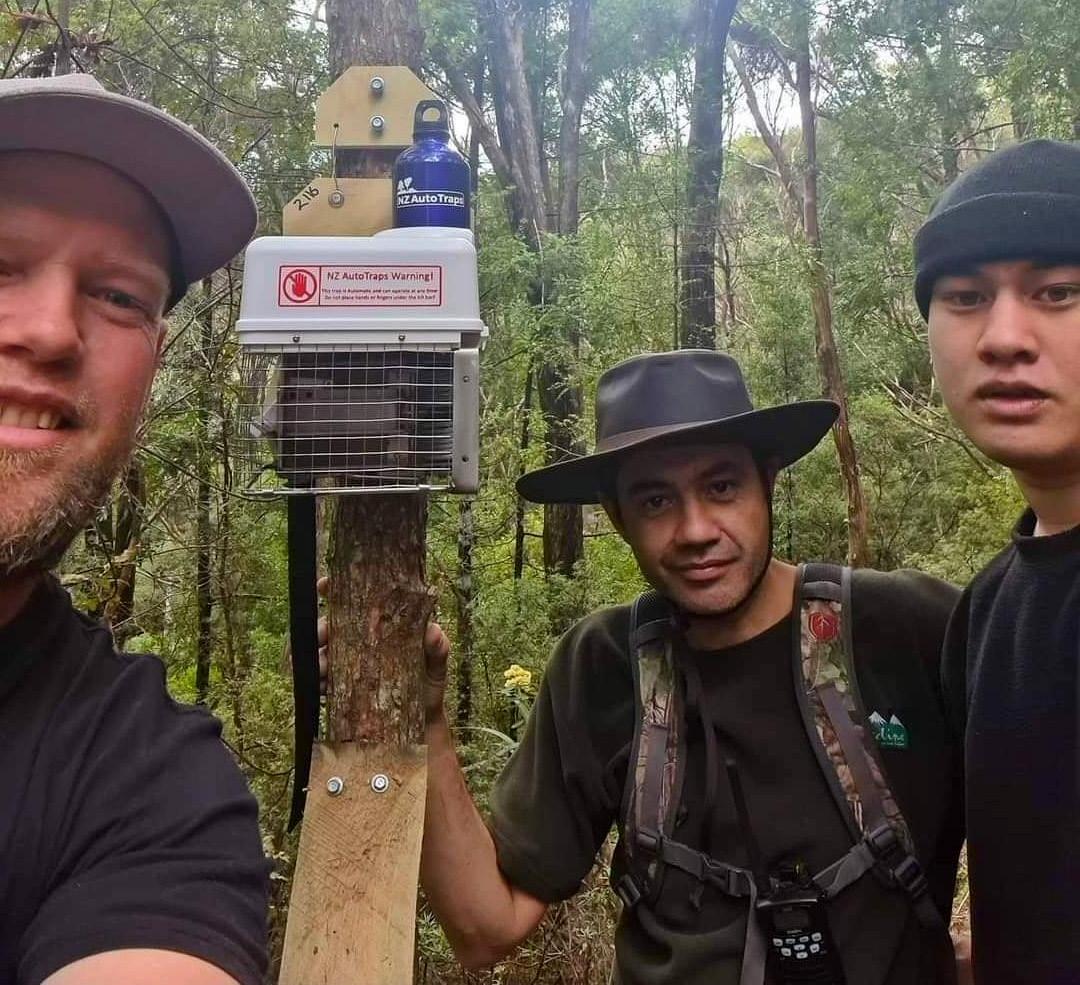 Brad Windust
Brad Windust
she worked with many people, including high-profile stakeholders, to build a social licence for change.

In 2016, the then National Prime Minister John Key announced the PFNZ 2050 vision, and successive governments have backed the idea, seeing it as important mahi for the country’s future.
“The beauty of predator free is that it’s very different from other wicked problems. It unites people rather than divides them, and it defines us as a nation,” says Nicola.
“I’m incredibly proud of having played a part in that and connecting with the many others who also played a role.”
The current species on the PF 2050 eradication list are rats, stoats, ferrets, weasels, and possums. Forest & Bird wants to see feral cats added because of the devastating impact they have on native birds, lizards, and insects.
We have been campaigning for a National Cat Management Act to help stop unwanted companion cats becoming stray or feral animals. This important step would help support the reduction and then eradication of feral cats in the wild.
“One feral cat can travel 20km along a braided river bed killing and eating vulnerable native birds and their chicks, as well as lizards and invertebrates,” added
We absolutely love Bird of The Year and supporting the incredible work that Forest & Bird does to raise awareness of our native birds, their habitats, and the threats they face.

Each year Honeywrap releases limited-edition beeswax wraps featuring endangered birds. Handcrafted in New Zealand from certified organic cotton and natural ingredients. Our amazing beeswax wraps are a sustainable, natural, reusable alternative to plastic for food storage.

Our 2022 Bird of The Year wrap is designed by the talented Elaine Bozza, and showcases many of our native birds and their Maori names. Making a difference is in our ethos and what we are all about.
“We are proud to use our voice to support Forest & Bird, and to inspire people to care about our environment and amazing New Zealand birds.” PROUD TO SUPPORT FOREST & BIRD FOR THE FIFTH YEAR.


$1.00 from every limited edition Honeywrap sold is donated to Forest & Bird.
THE POWER OF eDNA
Meet the man determined to change the face of conservation in Aotearoa one genetic “barcode” at a time Jazmine Ropner
Hidden away among the beige warehouses where movies are made on Wellington’s Miramar Peninsula, Wilderlab scientists are testing an environmental DNA sample sent in from college students who sampled water from two streams in Fiordland National Park.

The results are exciting – the Fiordland College students have discovered a previously unknown population of a rare native fish – the Gollum galaxias! This information will help local efforts to protect and restore the population’s habitat (see right).
Environmental DNA is genetic material shed from living things into water, air, or soil. Samples can be taken from a local river, beach, or reserve and sent to a lab for analysis.
Over the past three years, eDNA has been quietly sparking a change in conservation – and Wilderlab has been at the forefront of making the technology more accessible to New Zealanders.
The company’s easy-to-use eDNA sampling kits and lab-testing service are allowing more New Zealanders to discover the full range of species living in their backyards.
At the helm of the operation is founder and principal scientist Shaun Wilkinson. He started his working career as a chef in Palmerston North before moving to Wellington and discovering a passion for biology while studying marine science at University of Victoria.

He says he felt like a “fish in water” and loved learning about molecular biology, statistics, and bioinformatics. He decided to hang up his chef’s apron and pursue a new career in biological sciences.
In 2016, Shaun was awarded a Rutherford Foundation Postdoctoral Fellowship to conduct eDNA surveys on
coral reefs in Timor-Leste.
“On returning home, I saw a lack of easily accessible eDNA testing options in New Zealand and decided to start my own eDNA laboratory in 2019,” said Shaun.
“Easy to use, consistent eDNA sampling techniques weren’t available in New Zealand, and this caused a lack of motivation to use eDNA.”
The name Wilderlab comes from Shaun’s vision to develop compact eDNA kits that could be taken into the wilderness to gather samples.
The first concepts were developed in Shaun’s garage. His dream was to create an eDNA service that could be customised to suit the environmental challenges facing Aotearoa.
“I wanted an eDNA sampling kit that would easily fit in a backpack, instead of the old methods with bulky equipment that require more manpower,” added Shaun.
“The idea was to create an easy, simple, and accessible way of eDNA testing that would encourage people to get involved and interested in their local environment.”
Wilderlab’s scientists analyse short sections of genetic code as “barcodes” and match eDNA found in the samples to a reference database, which allows them to identify any species in the area.
Being able to test eDNA quickly and cheaply is an invaluable tool for conservationists because it gives information about species living in a habitat without having to locate them. It is also nonintrusive and can be used in remote locations.
Wilderlab works with other scientific organisations to create new eDNA tools that are constantly evolving in response to customer needs.
BIODIVERSITY
Wilderlab founder Shaun Wilkinson
| Forest & Bird Te Reo o te Taiao 20
Shaun Wilkinson, founder of Wilderlab. Supplied
Its customers include universities, regional and district councils, government agencies, primary sector businesses, environmental consultants, and community groups and individuals who want to protect and monitor their local environments.
Testing for eDNA is useful for decision-makers as it can give supporting evidence to help regional councils make planning decisions. It can also help them figure out which areas to prioritise for nature restoration or predator-free projects.
As the New Zealand database expands, so does our knowledge of the unique habitats and interesting species living in our neighbourhoods.
EDNA can also be used to differentiate species that look similar to each other because it can pinpoint tiny inconsistencies between the DNA.
Shaun Wilkinson is delighted to see more New Zealanders getting out into nature and testing for eDNA.
“We want people to care about what is in their local environment. What you can’t see you can’t save,” he added.
“The gravel maggot has a similar lifestyle to Tolkien’s Gollum, living up to 30cm deep under the beach’s surface,” said Don Neale, a Department of Conservation ranger. “This makes it very hard to find and study, but eDNA is one way to do that.”
The students from Fiordland College who used Wilderlab’s eDNA kits and discovered a new population of Gollum galaxias were part of an educational programme called Kids Restore the Kepler.
In 2021, they headed out to collect eDNA in two streams in Fiordland National Park: Ewe Burn, a stream draining farmland, and the Taiaroa Stream, which drains native bush. The samples were sent to Wilderlab for analysis.
The results showed there was Galaxias gollumoides e-DNA present in the habitat. This species is range restricted and is only found in swampy wetlands of Southland and Otago, so the detection of this new population is important for conservation of the species.
“We knew about kōaro and tuna longfin eels living there, but we didn’t know this species could be found so close to Te Anau,” said Alessandra Menegatti, the programme’s education coordinator.
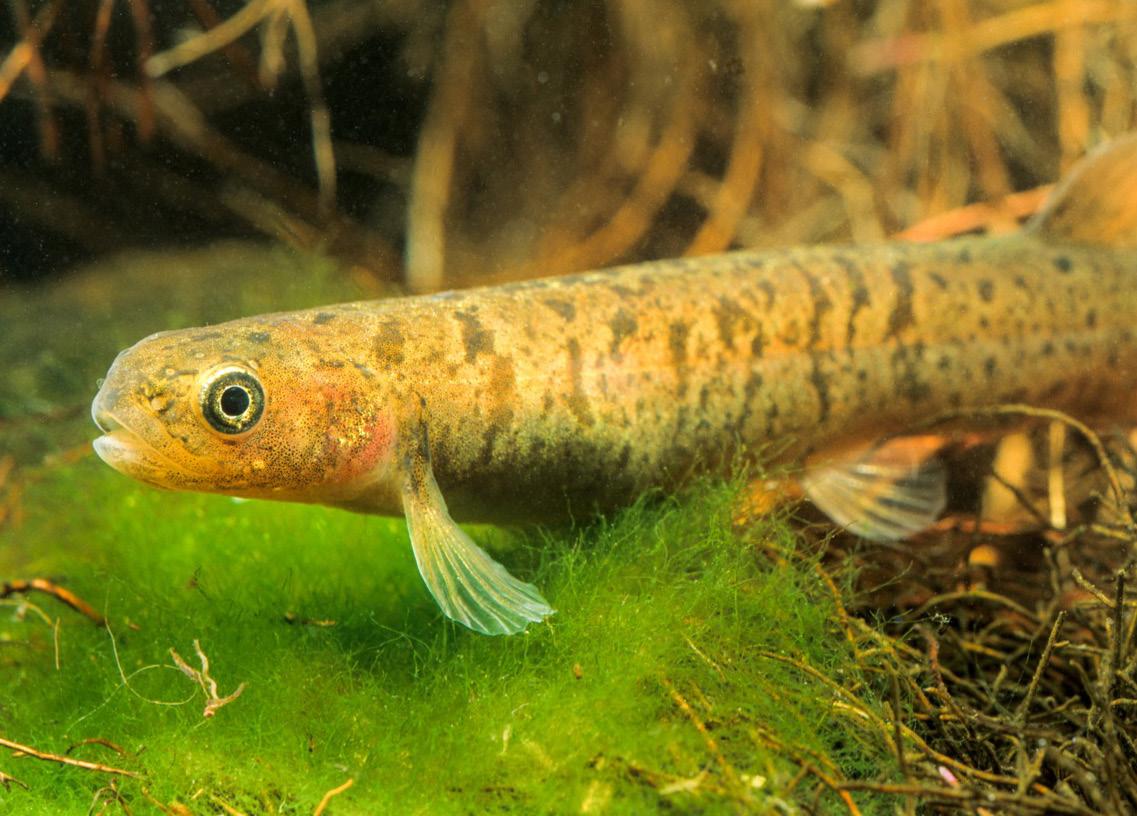
The testing kits are easy to use and portable.
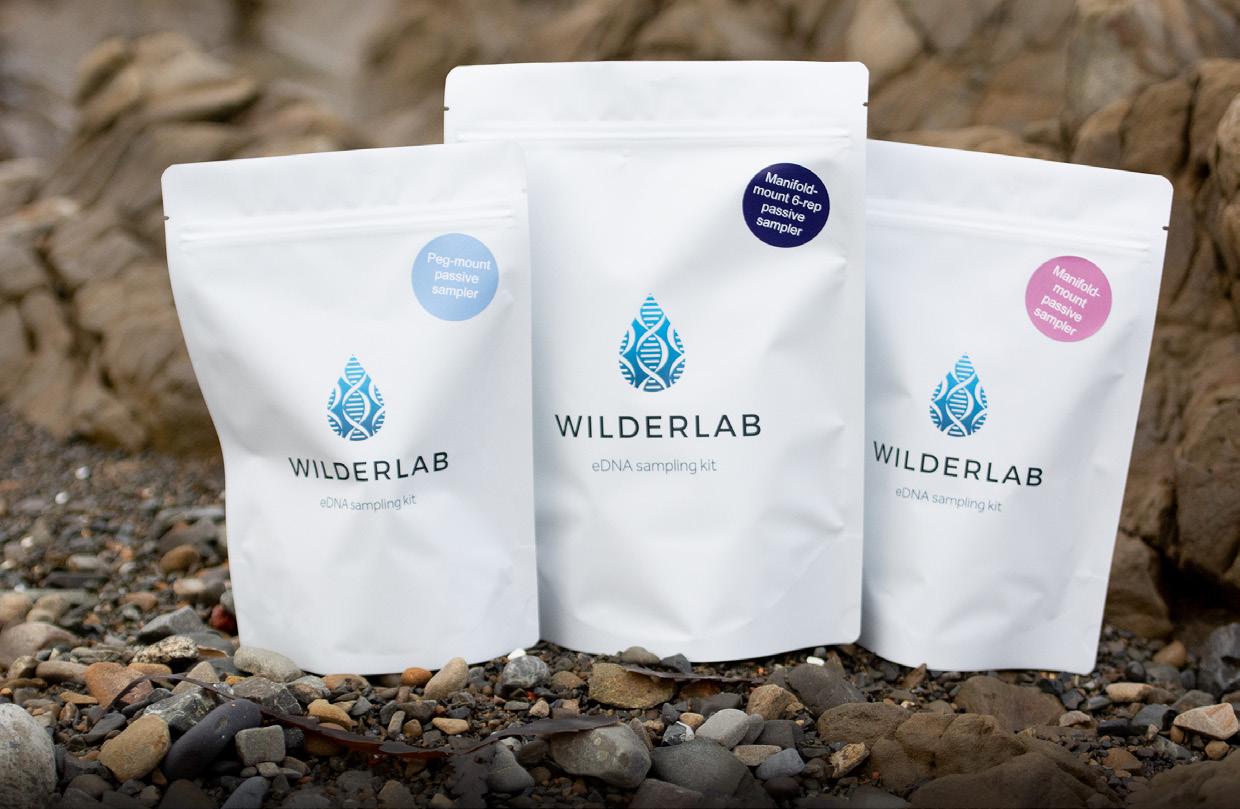
FANTASTIC FINDS
In mid-2022, a team of scientists from the University of Canterbury and two Māhaki ki Taiao rangers made an unexpected discovery.
Samples of seawater were taken during a routine monitoring check at Hautai Marine Reserve, to see which species had been in the area recently.
This is known as the most remote mainland marine reserve in Aotearoa because it is two days’ walk from the nearest road!
The Wilderlab team analysed the eDNA samples and reported the sampling showed the presence of a rare species named after JRR Tolkien.
The endangered Smeagol slug, a small maggot-like creature that lives in gravel, was detected in the area.
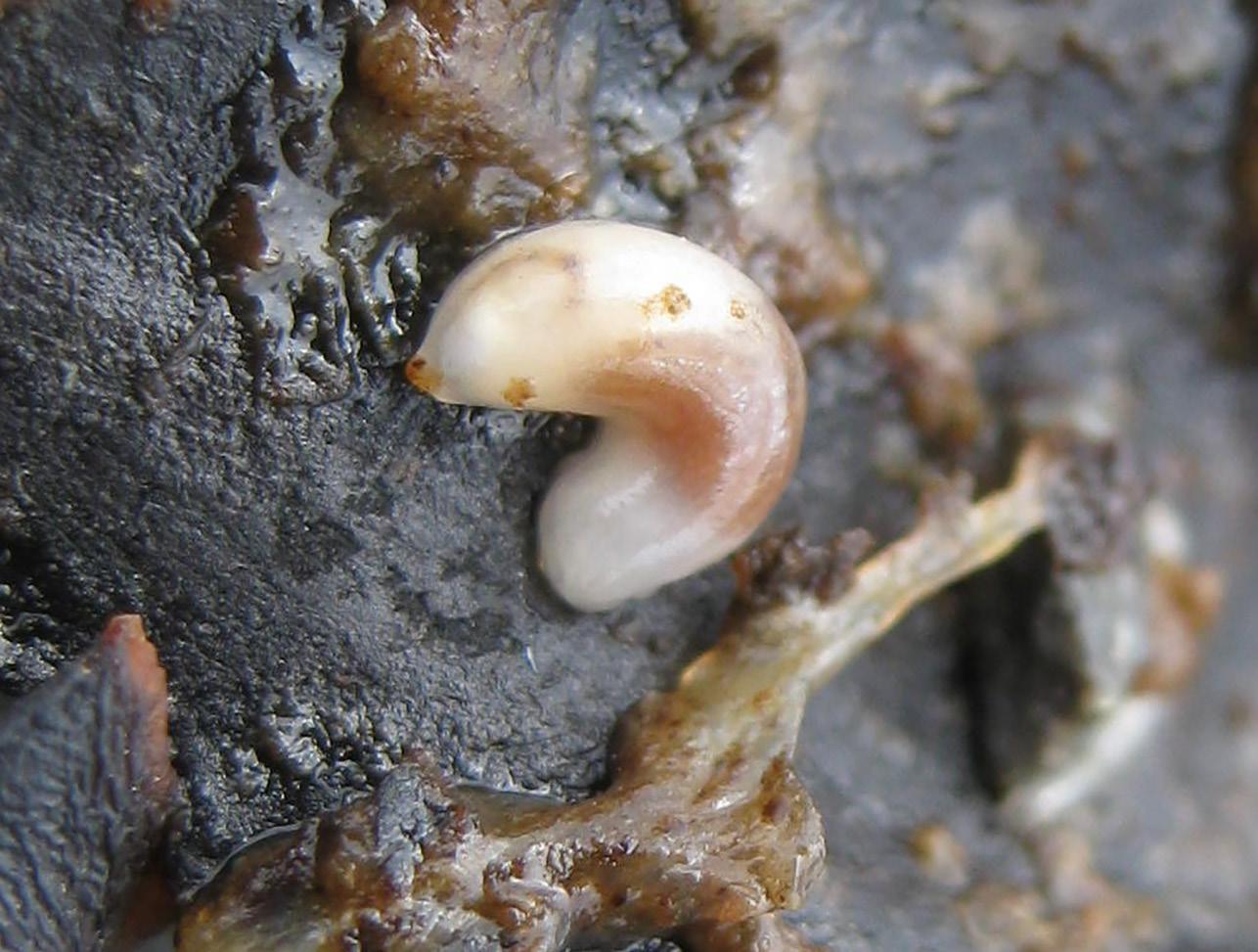
Its presence may have gone unnoticed without the use of eDNA sampling.
“The eDNA data analysis provides a wonderful example of contextual learning, where students are able to construct meaning based on their own experiences. All of a sudden DNA sequencing comes to life for them.”
→
Fiordland students discovered a new population of Gollum galaxias using eDNA. Rod Morris
21 Summer 2022 |
The Smeagol slug. Wildwind/iNaturalist
Biosecurity is another area where eDNA can be a powerful tool – helping to detect invasive species.
The landscape-scale Taranaki Maunga restoration project is using Wilderlab’s eDNA sampling kits to track mammalian pests.

One of their goals is to eradicate the goats that are threatening native plants in Te Papakura o Taranaki Egmont National Park and on Ngā Motu Sugar Loaf Islands, near Port Taranaki.
The team has found the eDNA meta-barcoding service at Wilderlab to be a reliable, cost-effective way to detect the presence of the pests.
Wilderlab’s eDNA database is constantly evolving as more species are added. For example, sampling can now detect the presence of land-based pekapeka-tou-roa long-tailed bats in a habitat.
In August 2022, the presence of native bats was unexpectedly found in eDNA samples taken from the Styx River catchment in northern Christchurch. The last recorded observation of bats in Christchurch was in 1885.
“The long-tailed bat is a nationally critical species and was not known to have been in the area, so its discovery was very exciting,” said Bethany Baker, conservation projects coordinator at Pūharakekenui Styx Living Laboratory Trust.
The discovery also highlighted how eDNA results can also occasionally be puzzling.
The Styx River sample also included the presence of capybara Hydrochoerus hydrochaeris DNA, a giant rodent native to South America. After some detective work, the DNA was traced to a nearby exotic animal wildlife reserve!
As a relatively new scientific tool with exciting and diverse capabilities, eDNA is already changing the face of conservation. What future extraordinary discoveries will be made using the power of eDNA?
For more information, go to www.wilderlab.co.nz.

RECHARGE IN THE WILD
Escape the hustle of modern life and sail into the serene on a remote, bespoke adventure into Fiordland. The Breaksea Girl your home in the wild, has all the creature comforts, a small family of expert guides and hosts a collection of multi-day adventures customised to get you closer than ever before.
wildfiordland.co.nz

BIODIVERSITY
→
| Forest & Bird Te Reo o te Taiao 22
Sampling for pests at Taranaki Maunga.
KAYAK . SAIL. SNORKEL.
FREE DIVE HIKE. WINE. DINE. UNWIND.
WETLAND WARRIORS
Leaving a bustling city for life in the country, a former Wellington couple is busy restoring the bush in their new backyard. David Brooks
Andrea and Kevin Maloney want to see nature restored throughout Aotearoa and are demonstrating their commitment by donating monthly to Forest & Bird while also restoring their own little corner of the country at Otatara, near Invercargill.

Andrea first joined Forest & Bird as a teenager, determined to join the fight to save the kōkako. Her own mother, Mary Broughton-Webb, was also a young conservationist, winning a Forest & Bird national award in 1954 at the age of 17 for an essay on why forests and birds need to be protected.
About five years ago, the Maloneys bought 3ha of land, about half of which was remnant bush and the rest in pasture, on a Southland peninsula dotted with housing, dairy farms, and patches of bush.
Most of their property is covenanted under the QEII National Trust, which helped them draw up a plan to ensure the health of the bush and restore most of the pasture into ephemeral wetlands.

The remnant bush includes tōtara, kahikatea, rimu, miro, climbing fuschia, muehlenbeckia,
and a diverse understorey, attracting many native birds.
They started by landscaping to restore wetlands, trapping, and establishing a shelter belt. All this work was made harder by having to make flying visits to their land from their Wellington home.
Last summer, the Maloneys took the plunge and moved to their newly built home on the property with their two children Nicholas and Lee.
Andrea is a hydrogeologist and Kevin is an IT architect, and they are able to work remotely from their new home.
“We count ourselves very lucky we could move out of Wellington to a place with a chunk of land to look after and take our jobs with us. We’re at least as productive here, and healthier and happier,” says Kevin.
Andrea had to give up her second job as a landscape designer to focus on the restoration. “I don’t miss the landscaping because I’m doing so much work here. I want to use my energy here,” she says.
They plan to put in another 3000 plants on the property, many of which are sourced from the nearby Southland Community Nursery,
run by Forest & Bird members Chris and Brian Rance. Andrea volunteers at the nursery on Friday mornings when work commitments allow.
“I think the kids would say I’m crazy about birds. But it’s biodiversity in general really. That’s why we support Forest & Bird. We just want to help, along with so many other people, to right the balance,” Andrea says.
A couple of years ago, Andrea told Kevin her dream was to one day see a heron in their wetland pond.
Earlier this year, she saw a white heron, probably a little egret, foraging in the pond. It was then Andrea knew their hard work was paying off.
Suppor ter Nature’s Future
Making a regular gift for nature each month gives our natural world a fighting chance. It allows Forest & Bird to respond quickly, and with maximum impact, to issues that threaten our natural treasures. For more information, go to https://www. forestandbird.org.nz/supportus/become-regular-giver.
REGULAR GIVING
The Maloneys have been restoring this natural wetland on their land in Southland. Supplied
23 Summer 2022 |
Andrea and Kevin Maloney
GOING ON A FROG HUNT
The Coromandel Peninsula is apparently home to 50 million Archey’s frogs. Stuart Attwood set out to see how many he could find over a weekend.
The news that there could be 54.8 million critically endangered Archey’s frogs present on the Coromandel Peninsula, instead of the previously thought 5000-20,000, raised conservationists’ eyebrows earlier this year.

The figure was contained in an environmental report provided by OceanaGold to the Hauraki District Council in support of its consent application to mine under conservation land at Coromandel Forest Park.
The mining company’s 50 million estimate would see us wading through frogs at various places around the Peninsula, so I decided to venture forth with Forest & Bird’s communications adviser Ellen Rykers and see how many of these elusive critters we could find over a weekend.

We started our frog hunt at Tim and Jude Hooson’s place at the Mahakirau Forest Estate, near Coromandel Town. This 600ha private nature sanctuary is divided into individual blocks, with each landowner putting money into a
fund that sees the whole estate heavily trapped, baited, and monitored.
The trapping system, Tim explained, was set up to protect birds as well as ground-dwelling species such as frogs and geckos. In fact, the Mahakirau Estate is a sanctuary for many critically endangered species, including Archey’s frogs and the rare Helms or forest ringlet butterfly.
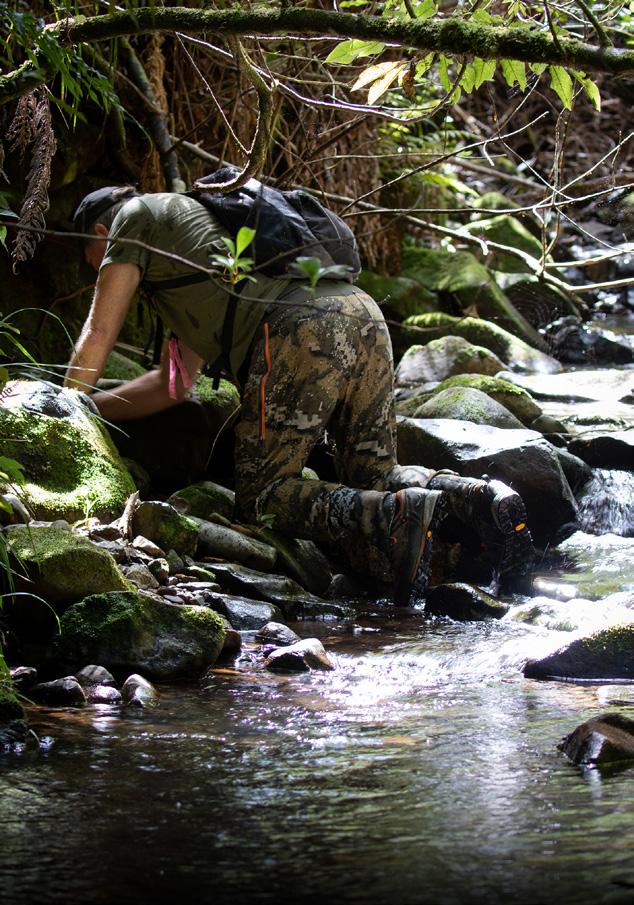
The Hoosons are both heavily involved in various conservation projects around the Coromandel Peninsula and as far down as the Kaimai Mamaku ranges. Jude is the chief executive of the PredatorFree Hauraki Coromandel Community Trust. Mahakirau is often visited by botanists and other scientists looking to research or view various species living in the area. Sara Smerdon, one of the residents and our guide, has been consulted for her Archey’s frog knowledge by DOC and Auckland Zoo, which runs an Archey’s frog breeding programme.
It was a reasonably cool evening with very light rain. Setting off at around 10pm, we were taken to an area where frogs were known to be present. It didn’t take long until we were rewarded with finding an Archey’s frog comfortably nestled in a fern. We were delighted, and
NO NEW MINES
The solitary Archey’s frog discovered during two days of hunting in frog country, Coromandel Peninsula Stuart Attwood
Tim and Jude Hooson
| Forest & Bird Te Reo o te Taiao 24
Tim Hooson hunts for Archey’s frogs at Mahakirau.
for about two minutes we got to observe this lovely individual.
We were happy to see at least one frog on our expedition. We also caught sight of wētā, a northern striped gecko, a forest ringlet caterpillar, and various other invertebrates.
The following day, we met up with Tim and Jude and spent a further few hours searching over tracks and around a stream, poking around any place that looked like it could be potential frog habitat.
On this search, Tim checked traps and bait stations as we went. He also pointed out the Gahnia or type of “cutty grass” that is host to the forest ringlet butterfly. We were

including four 8mx8m ventilation shafts and structures above ground.
It says its mining activities at Wharekirauponga will be beneficial to frogs as well as other species via investment into predator control and general care for the area in which they are working.
Clive has been working in and around the Wharekirauponga Track for more than 30 years, and Suzanne is a former DOC botanist. Both have seen frogs in the area, including Archey’s and another ancient endemic species Hochstetter’s frog.
During our searches, there was a lot of discussion around the effect of ground vibration on Archey’s frogs and how the proposed gold mining could affect the water table. This is a beautiful area, with hundreds of regrowth kauri that, along with the frogs, could be put in jeopardy by the mining activities.

turned to see a frog looking at him.
He could not verify the species, but from the description it would have been either an Archey’s or Hochstetter’s. We looked in the area where the sighting had taken place to no avail. In fact, over two days of searching, assisted by experts, we found only one Archey’s frog.
There was nothing scientific about our exercise. The variables for searching are complex. The weather, terrain, and altitude play a part, as does the fact that Archey’s are shy and nocturnal.
unsuccessful in our attempts to find further frogs, but it was a very informative walk in a particularly beautiful part of the Coromandel.
The next day, we travelled to Coromandel Forest Park and met up with Suzanne Clegg and Clive Duxfield, both from Earthwatch Whangamata, a group aligned with the anti-mining group Coromandel Watchdog.
OceanaGold wants to expand its gold-mining operations at Waihī by digging under the Wharekirauponga Track area. It is planning to build a 7km double tunnel to carry gold to its processing plant at Waihī,
The track is a loop that has been closed off by the mining company, who have attempted to block access to a swing bridge that overlooks a lovely waterfall and the Wharekirauponga Stream. In quiet protest, locals have been removing the timber nailed across the entrances to the bridge.
OceanaGold has sponsored a boot-washing station at the beginning of the track to prevent kauri dieback. I hope any mining equipment used to drill and create ventilation shafts will be thoroughly cleaned before being shifted to each new site.
A frog had been spotted beside a creek within the previous week or so. A tramper had injured his ankle and had sat down with his foot in the stream to ease the injury and
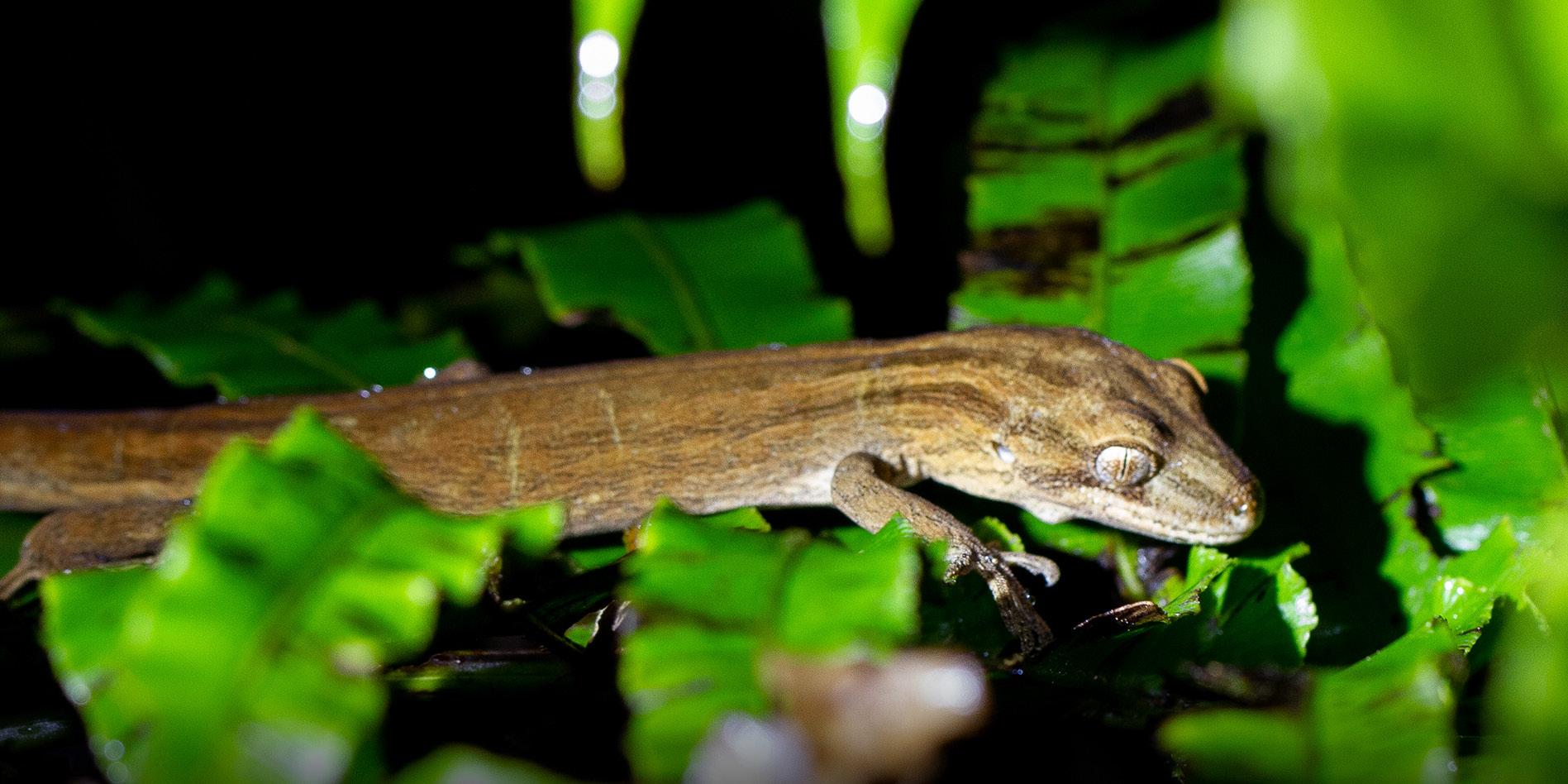
This article was never intended to be a deep dive into the mining operations and potential environmental damage. It was purely an exercise to see whether there was any credence to the 50 million frogs claim. From our time searching, to put it lightly, I am sceptical about OceanaGold’s estimate.
Thank you to Jude and Tim Hoosen, Sara Smerdon, Suzanne Clegg, and Clive Duxfield for your time, knowledge, and hospitality.
A spider orchid in the Wharekirauponga Valley Stuart Attwood
A northern striped gecko at Mahakirau. Stuart Attwood
25 Summer 2022 |
Clive Duxfield, Ellen Rykers, and Suzanne Clegg search for frogs near the Wharekirauponga Track, Coromandel Forest Park.
TALKING ABOUT CATS
We had an avalanche of responses to Amelia Geary’s “Time to Talk about Cats” article in our Spring issue. Here is an edited selection of some of your letters and emails.


Your responses were overwhelmingly in favour of introducing a national Cat Management Act – even among Fluffy-owning readers, who asked for ideas on how to control their much-loved companion cats. Many of you shared frustration about local cats roaming neghbourhood gardens and nature reserves hunting local wildlife. Some of you called for a limit per household of three cats or fewer. Others asked why feral cats were not on the list of species for Predator-free NZ 2050. Meanwhile, Forest & Bird’s campaign to persuade government Ministers to introduce a national Cat Management Act, similar to dog control legislation, continues. In August, we made an oral submission to the Environment Committee setting out our case.
Please support Forest & Bird’s campaign for a national Cat Management Act by making a donation! Go to https://www.forestandbird.org.nz/actforcats.
REASONS TO ACT
I just read the excellent, informative article on the issue of cat management in the latest Forest & Bird journal. Agree strongly with its themes, especially the need for national guidelines like the Dog Control Act. The reasons to act section is very powerful.
CAT EDUCATION
I read with great interest your article about supporting legislation to control cats. It is excellent to see you clearly differentiate between companion cats and stray/ feral cats, because we actually have two cat problems that require different solutions. Educating cat owners to manage their cats – in the same way dog owners now pick up dog poo as an expected standard of behaviour – is the long-term solution to minimise harm caused to wildlife. Meanwhile, the complete elimination of stray (unchipped) or feral cats is the only solution to their miserable lives. I too am weary of lots of talk but not much action. I have therefore started a project to provide educational resources for community groups, such as Forest & Bird branches, so they can run educational campaigns for companion cat owners.
Ngaire Wallen, Cat Owners Education New Zealand
IF IT’S GOOD ENOUGH FOR DOGS
As a soppy cat lover and an even soppier bird lover, I thought I would email my support for a nationwide Cat Management Act. If it’s good enough for dog owners to be registered and regulated, then it’s good enough for cat owners. If a person can’t afford or can’t be bothered to do the right thing, then they shouldn’t have a cat – or any other animal for that matter! I support mandatory microchipping and desexing. This may stop people from owning cats just to dump them when they don’t want them anymore. And I think two cats per owner is more than enough. Many thanks for a lovely magazine.
Elizabeth Presland-Tack
FERAL-FREE 2050
Your interesting piece on cats doesn’t mention whether, in 2050, when New Zealand supposedly intends to be predator-free, cats will be included amongst predators to be eliminated.
 Roger Hall
Roger Hall
PREDATOR-FREE NZ
Graham Bush
| Forest & Bird Te Reo o te Taiao 26
Amelia’s answer: One of Forest & Bird’s campaign objectives is to have cats included in the suite of predators for PF2050. For now, we’re focusing on getting a Cat Management Act to regulate owned cats. We will hopefully then be better positioned to get cats included in PF2050. People will be more supportive of the idea if they know their owned cat is safe and may be more inclined to keep their cats inside if they know feral cats are to be targeted in their area.
NEIGHBOURHOOD CATS
A Cat Management Act would be a good start. It bothers me that our neighbours can get their cat microchipped, and the responsibility ends there. The cat is then allowed to free range across the neighbourhood 24/7 feasting on fantails and lizards. I have invested a lot of energy in my native plant suburban garden. I noticed an increase in lizards and birds over time, then a new neighbour arrived with a cat that was a particularly determined predator to the detriment of the native fauna. I resent hosting the neighbour’s cat but feel powerless to act.
Grant Timlin
TREE-CLIMBING CATS
I recently caught a cat halfway up a tree stalking a scared kererū. Fortunately, I was able to scare the cat off. It annoys me that my neighbours are happy to let their cats roam free when I am trying to keep my section predator free and bird friendly.
Nick Wiffen
LIMIT NUMBERS
I strongly agree there should be a limit on the number of cats per household and feel that some areas, such as the Peninsula in Dunedin that has a number of wildlife reserves, should have a ban on cats all together. If you wish to live in these types of areas, then you should not be allowed to destroy the native birds with your pet cat. Having lived next to a family with six cats and having to remove up to eight bags of cat faeces from my garden on a weekly basis, I think a limit on the number of cats allowed per family should be two in city areas.
Hilary Hutton
TIPS FOR NATURE-FRIENDLY FELINES
• Keep me inside at night.
• Get me neutered or spayed.
• Microchip me and give me a collar and bell.
• A high-protein diet means I will hunt less.
• Don’t leave me home alone for too long.
• Limit my number per household.
The tips above and images on this page are courtesy of Ngaire Wallen, Cat Owners Education New Zealand – see www.coednz.com.
PET PRIVILEGE
My husband and I are both strongly in agreement that cats should be registered, that pet cats should be limited to no more than three per household, and that they should be desexed and microchipped. We are constantly having to chase local cats from our garden, especially in the spring when baby birds are out with their parents learning how to look for worms etc. We are not against cats as pets and know for some people, especially those who live alone, that they can be a great comfort, but owning such a pet, as with a dog, should be a privilege and a responsibility.
Rose and Wayne Hendry
ESCAPE-PROOF RUN
Our family cat is microchipped, is desexed, and wears a GPS collar. This means that, if the cat strays beyond the immediate area of the garden, an alarm is sounded on the mobile phones of the two adult owners. As this can be extremely inconvenient, we have trained younger family members to supervise the cat when it is outside its extensive escape-proof run, which is large enough to allow a human to enter and interact with the cat. The run was expensive to set up, but the cat seems happy with his outdoor play area.
Ann Wickham
STRAY CATS
We fully support the call by Forest & Bird and many others for a national law for cats. But the number of stray cats you quote (196,000), taken from the 2017 National Cat Management Strategy Group Report, is a significant underestimate. The estimated number of adults in the Auckland region alone is 200,000, meaning that nationally the number of strays is likely to exceed 600,000. We do not support having a limit on the number of cats per household. A limit of three, or any number, will result in more strays and more euthanasia of sociable cats due to fewer spaces being available in caring homes. We look forward to a national law for cats being drafted and passed by Parliament before the end of 2024.
Peter Dormon, Trustee Stray Cats New Zealand Trust
(see www.straycatnz.org)

27 Summer 2022 |
AROHATIA TĪKAPA MOANA LOVE THE GULF
It’s time to protect and restore this precious ocean taonga for future generations. Caroline Wood
Regular readers of this magazine will know that Forest & Bird staff and branch volunteers love the Hauraki Gulf and have been campaigning for many years to protect it.
But it continues to be in crisis – overfishing, climate change, and sedimentation run-off are all contributing to the declining state of the Gulf’s waters.
This summer’s predicted marine heatwave will further threaten the area’s sponge gardens, which are sensitive to water temperature changes, and make it harder for kororā little penguins to find food.
The need for action is urgent, and that’s why Forest & Bird is launching a Arohatia Tīkapa Moana | Love the Gulf campaign this summer.
Working with mana whenua and other conservation partners, we are calling for 30% marine protection, a plan of action to reduce sedimentation entering the marine environment, and an end to bottom trawling.
Join us at Piritahi Marae on Waiheke Island on 10 December for an incredible day in the Hauraki Gulf, where we will be celebrating the big blue backyard on Auckland’s doorstep.
Forest & Bird’s chief executive Nicola Toki will be there, together with other invited speakers, stalls, food, music, and activities for children.
Organiser Bianca Ranson, Forest & Bird’s Hauraki Gulf coordinator, said: “This year, we have an unprecedented opportunity to come together with mana whenua, community groups, and other e-NGOs to help restore the health and mauri of the Hauraki Gulf.

“Tīkapa Moana requires urgent protection now. Please join us at Piritahi Marae on 10 December to find out how you can help protect and restore it for future generations to enjoy.”
The first goal of our campaign is to achieve 30% protection for the Hauraki Gulf and use this springboard to persuade the government to protect the same proportion of all of New Zealand’s Exclusive Economic Zone.
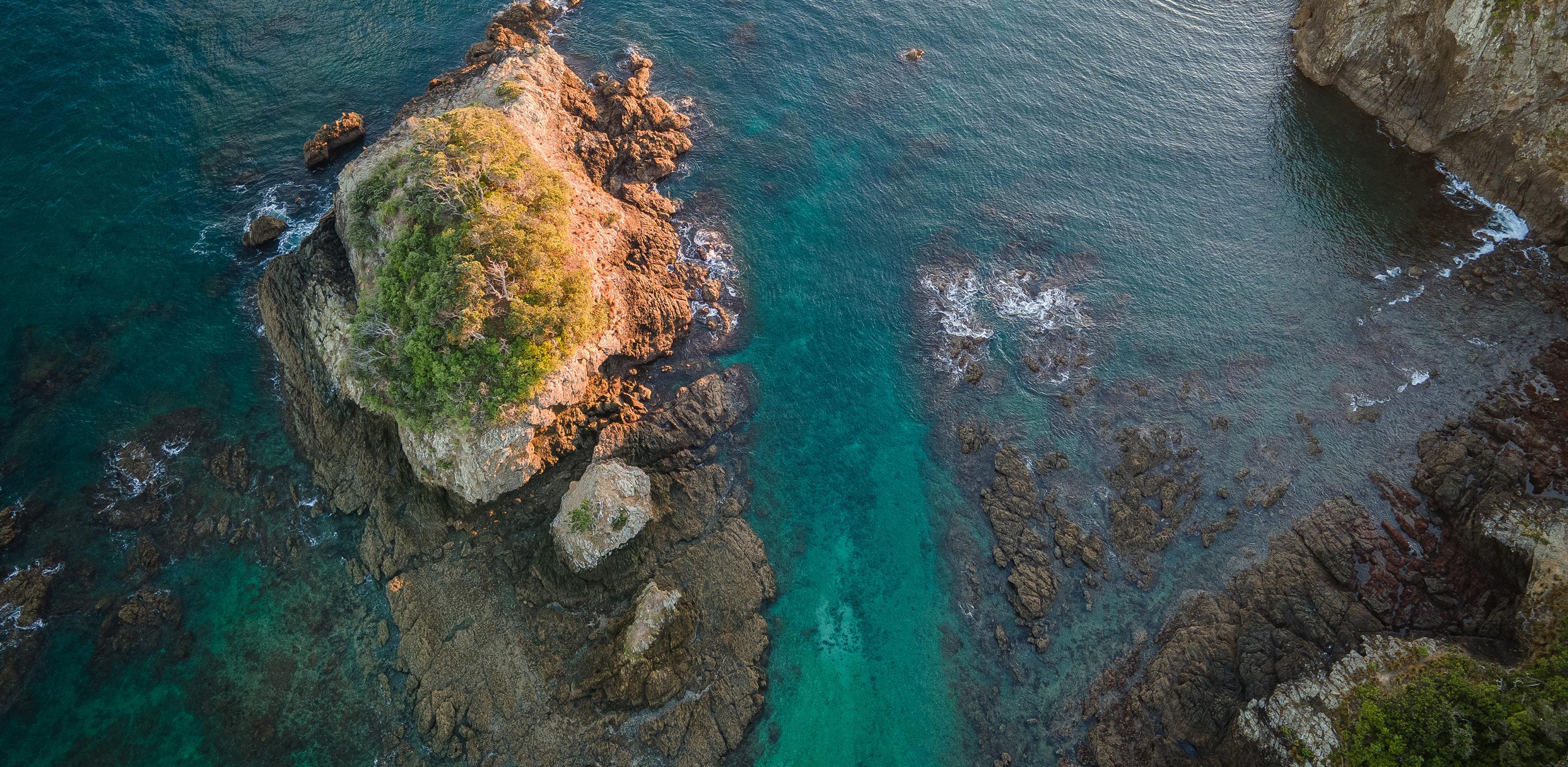
Many countries have pledged 30% protection for their oceans as a climate action and to protect global biodiversity, but so far New Zealand hasn’t joined them.
But there is hope. In September, government Ministers launched a public consultation over plans for 19 new protection zones for the Hauraki Gulf.
These would increase the area under protection in the Gulf from just over 6% to about 18% – and support the recovery of some of its most biodiverse regions.
Forest & Bird made a detailed submission supporting all 19 zones, which would be created using two new marine protection tools established through legislation.
Twelve High Protection Areas would provide for the expression of customary practices by mana whenua in a way that is consistent with the area’s biodiversity objectives.
There would also be five Seafloor Protection Areas prohibiting activities that damage or disturb the seafloor, such as bottom trawling and mining. Fishing, snorkelling, and kayaking would be allowed.
Another goal of Forest & Bird’s Love the Gulf campaign is to reduce the amount of sedimentation and other pollution running off the land into the water, damaging or killing marine life.
MARINE
The waters around Ōtata, the Noises Islands, could be protected by a High Protection Area, one of 12 proposed for the Hauraki Gulf. Gareth Cooke Project Kahurangi
| Forest & Bird Te Reo o te Taiao 28
Bianca Ranson
BAN BOTTOM TRAWLING NOW!
Forest & Bird wants the Minister for Oceans and Fisheries to ban all forms of mobile bottom-contact fishing, including bottom trawling, scallop dredging, and Danish seining within Hauraki Gulf Marine Park.
For decades, commercial fishers have been using these destructive fishing methods to rip up the seafloor. Many seabed species and habitats are being decimated, and whole ecosystems have disappeared from the Hauraki Gulf Marine Park.
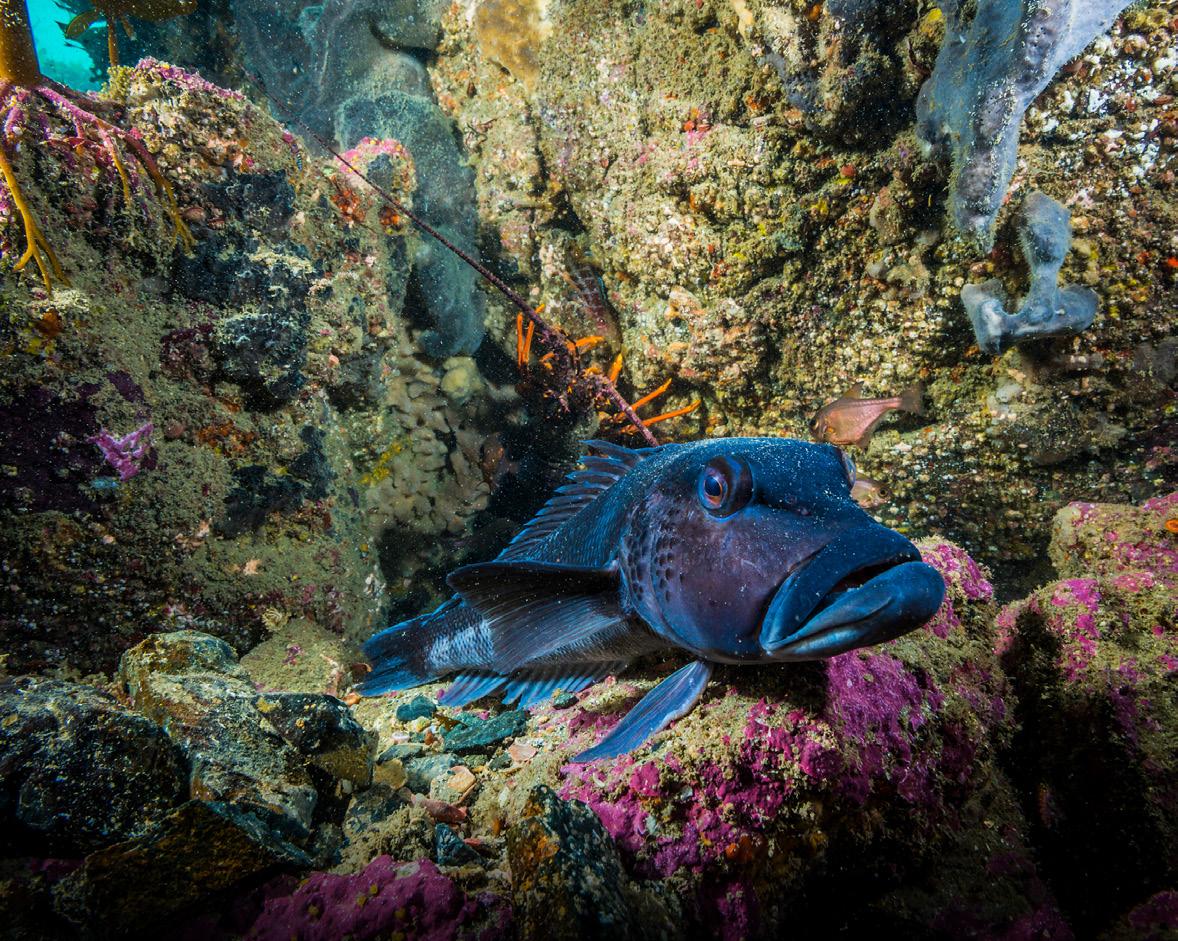
A survey in November 2021 showed 84% of people living in the Gulf area want these fishing methods gone from Hauraki Gulf Marine Park for good, yet, shockingly, they are being allowed to continue.
In August, Forest & Bird joined the Hauraki Gulf Alliance, an unprecedented gathering of organisations that has come together to campaign for the removal of these fishing practices to boost marine life in the Gulf.
Forest & Bird’s marine advocate Geoff Keey is a member of the Hauraki Gulf Fisheries Plan Advisory Group. It is tasked with helping the Minister and MPI implement a move to ecosystem-based fisheries management in the Gulf.
“We need to show the strength of community feeling about this issue to the Minister of Oceans and Fisheries because he has the power to remove trawling and
dredging from the Hauraki Gulf Marine Park,” says Geoff.
“The long overdue move to ecosystem-based fisheries management in the Gulf has the power to be a seachange. We want to see the fisheries plan become a model for how to manage fisheries by ecosystem and roll it out for the whole country.”
Please sign Forest & Bird’s petition at https://www. forestandbird.org.nz/petitions/ban-bottomtrawling-hauraki-gulf. Find out more about the work of the new Hauraki Gulf Alliance at https:// haurakigulfalliance.nz.
12 Day - Wild Coastlines of the South East
Perth to Perth 4 – 15 Feb 2023 – Accommodated Tour
Our coastline is just beautiful - sandy coves, rolling hills leading down to the water's edge, and offshore islands with their abundant sea life - birds, seals, Orcas, and dolphins. We will showcase the natural diversity of the regions between Perth and Esperance, particularly the coastline on either side of Esperance.
10 Day - Wildlife of the Southern Forests
Perth to Perth 25 March – 3 April 2023 – Accommodated Tour
Escape the heat and enjoy the scenic splendour of the South West. Home of magnificent Karri forests, deserted white sandy beaches and rugged coastal beauty. This combined with wildlife, rare marsupials, the spectacular panorama of the National Parks and interesting bird life, makes this a trip not to miss.
12 Day - Pilbara Reef And Ranges
Perth To Newman 29 April – 10 May 2023 – Accommodated Tour
Head north of Perth for sea birding colonies on coral islands, marine life, coral reefs and Karijini’s gorges. Highlights include the Abrolhos Islands, Shark Bay, Ningaloo Reef and Karijini NP.
12 Day -Central Australian Expedition
Alice Springs – Alice Springs 24 May – 4 June 2023 – Camping Tour
Join us and explore the remote deserts, gorges and wilderness areas of the Northern Territory and South Australia. It is isolated, harsh and mostly untouched, yet beautiful in its own right. The varied outback landscapes, unique wildlife and endless horizons never cease to amaze.
10 Day - Lake Eyre Basin and Flinders Ranges Expedition
Adelaide – Alice Springs 27 May – 5 June 2023 – Accommodated Tour
This tour covers some of South Australia’s most historic outback locations in the Lake Eyre Basin and both the Southern Flinders Ranges. Both areas offer vastly different examples of our great country and provide an opportunity for a wide range of arid zone flora and fauna sightings.

www.coateswildlifetours.com.au

29 Summer 2022 |
Banning destructive fishing methods in the Hauraki Gulf would allow marine life to return. Alex Stone
Specialists in Nature Tours Since 1986 For our full 2023 tour program • Web:
• Call: +61 8
6066 • Email:
• Informative naturalist leaders •
groups (6 – 12 Participants) • Private Charters available • Fully accommodated & camping tours
9330
info@coateswildlifetours.com.au
Small
SAVING KIWI
ONE EGG AT A TIME
What’s it like being a kiwi keeper working to prevent our precious longbeaked friends disappearing forever? Erin Reilly
If there was a competition to find the person with the best job in the world, Kelsi Thompson could be a frontrunner.
Kelsi is a kiwi keeper at the Crombie Lockwood Kiwi Burrow, Wairakei, north of Taupō. The facility, which is run by Save the Kiwi and located in the Wairakei Golf + Sanctuary, is at the heart of the country’s kiwi recovery programme.

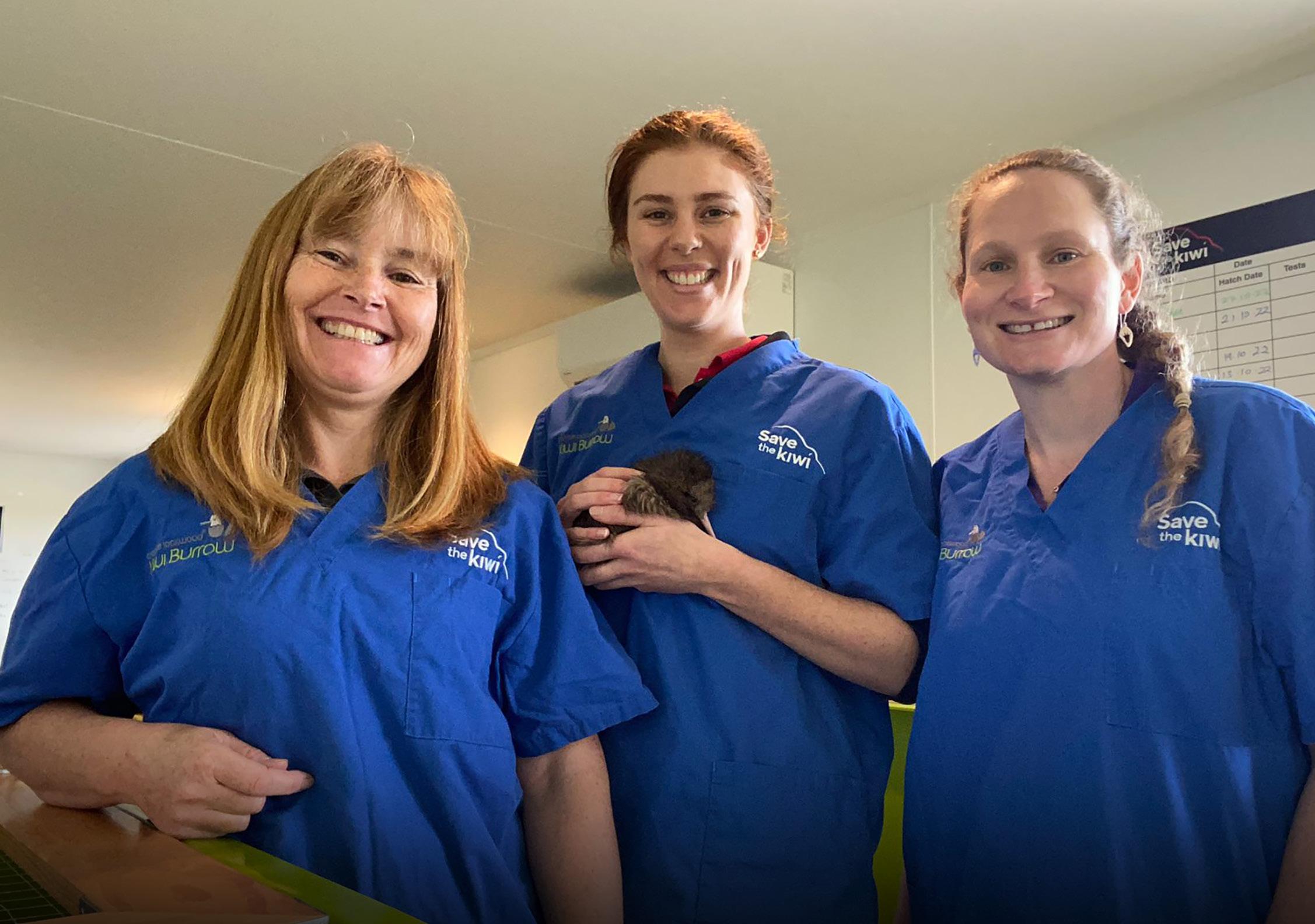
The Burrow’s dedicated incubation, hatching, and brooding facility hatches and releases between 70 and 100 kiwi chicks every year.
“It really isn’t a job at all,” Kelsi laughs. “Every day I get to watch the development of a kiwi chick, from when an egg is delivered to the Burrow to when
it hatches, all the way through to when it gets released. It’s such a rewarding job.”
Kiwi can live for 40–50 years and could lay up to 100 eggs in their lifetime. So what does a kiwi keeper do, and why does this role exist?
“The team at the Burrow is responsible for caring for kiwi eggs that have been lifted from the wild, so they can hatch safely and away from predators,” explains Kelsi.
“A massive 95% of kiwi chicks that hatch in areas that don’t have predator control won’t make it to adulthood, so facilities like ours are really important.
“If organisations like Save the Kiwi didn’t intervene, kiwi could literally disappear from our forests.”
There are five species of kiwi in Aotearoa: the North Island brown kiwi, kiwi pukupuku little spotted kiwi, roroa great spotted kiwi, rowi, and tokoeka. Most of the Burrow’s
focus is on the western North Island brown kiwi.
Kelsi’s role is very hands on. She candles (shines a torch into) the egg to see what’s going on inside. She makes sure incubators are kept at consistent temperatures and eggs that are ready to hatch are in the best position possible.
Throughout the hatching process, she monitors eggs, and when chicks hatch she helps make sure they get the best start to life.
When an egg arrives at the Burrow, keepers “candle” it to help understand how the chick inside is developing.

BIODIVERSITY
Kelsi Thompson
| Forest & Bird Te Reo o te Taiao 30
Husbandry manager Helen McCormick, kiwi keeper Kelsi Thompson, and senior kiwi keeper Kim McGuire at the Crombie Lockwood Kiwi Burrow.
Sometimes, soon-to-hatch chicks might need a little extra help, so Kelsi might have to start the hatching process for them.
“If the chick can’t break through the internal membrane on its own, it will suffocate,” she says. “It’s a bit like putting a plastic bag over your head.
“Being there to assist a chick with hatching if it needs a little extra help is really rewarding, especially if the rest of the hatch goes well and out comes a happy, healthy bird.”

Inside the brooder room, there are sometimes upwards of 14 kiwi chicks ranging from three to 30 days old.
Sanctuary, Coromandel, or Taranaki.
Birds ready to be released are typically transported to Sanctuary Mountain Maungatautari or released into the kiwi crèche located within the Wairakei Golf + Sanctuary.
This season, which unexpectedly started in mid-August, the team hopes to hatch close to 100 birds.
Unusually, Kelsi hopes that in 10 years’ time she doesn’t have a job.
“Self-sufficient kiwi populations are our goal – and when that happens, hopefully these kinds of roles and facilities won’t be required anymore!” she says.
“Until then, I’m so stoked and privileged to be able to work so closely with this unique species and help return kiwi to places where they once lived.”
Despite working with kiwi for three years and in conservation for five, Kelsi is yet to tick a unique experience off her “kiwi bucket list”.
The
After they hatch, chicks stay in the brooder room for the rest of their stay at the Burrow, where they eat, drink, sleep, probe in soil, and put on enough weight to be released into kiwi-safe habitat.
“Release days are exciting because we get to wish our little feathered friends good luck as they start a new adventure,” says Kelsi.
“It’s sad because we get close to the birds during their stay with us, but it’s also rewarding knowing that they’re contributing to the re-establishment of the kiwi population.”
Throughout the kiwi hatching season, which typically starts in October and runs until March, the Crombie Lockwood Kiwi Burrow has an almost endless rotation of eggs arriving, incubating, and hatching, and chicks being released.
Eggs may travel to the Burrow via volunteer drivers from Cape
“Every day I get up close and personal with kiwi, but I’ve never seen kiwi just being kiwi in the wild,” she says.
“I would love to spend some time on Rakiura Stewart Island in the hopes of seeing some out during the day.”
For more information about Save the Kiwi and the Crombie Lockwood Kiwi Burrow, visit www.savethekiwi.nz
When kiwi chicks hatch, they are fully feathered and can essentially look after themselves from day one – this is very uncommon in the bird world.
MILLIONS
Today, approximately
68,000
of kiwi
kiwi remain
2%
every year
That number declines by 95% are killed before they reach adulthood
Around
Of the kiwi that hatch in the wild, 20 kiwi are killed every week
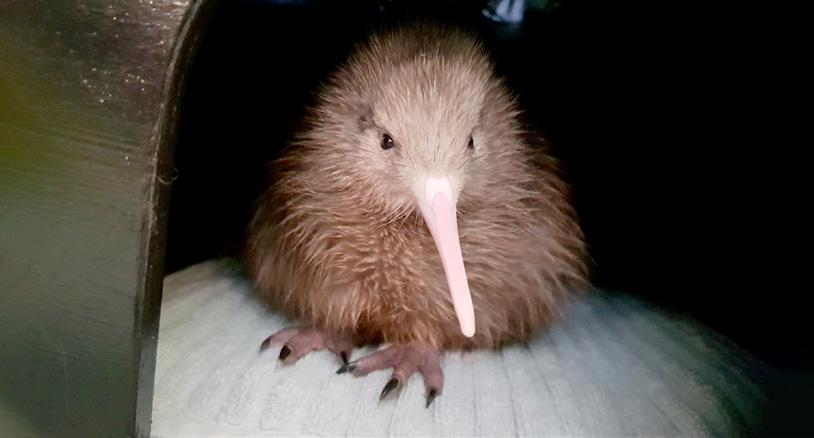

If we were to do nothing,
Aotearoa used to be home to 0 kiwi could be left in the wild in a few generations
BOOK GIVEAWAY
Forest & Bird supporter Cushla Thomson McCaughey is donating two copies of her book Raising our Chicks RRP $39 each.
To be in to win, email your entry to draw@forestandbird.org. nz, put CHICKS in the subject line, and include your name and address in the email. Or write your name and address on the back of an envelope and post to CHICKS draw, Forest & Bird, PO BOX 631, Wellington 6140. Entries close 1 February 2023.
 hatching process takes approximately five days.
hatching process takes approximately five days.
31 Summer 2022 |
Forest & Bird’s
CENTENNIAL CONCERT
Music meets nature in a spectacular premiere concert at Auckland Arts Festival on 17 March 2023. Grab your tickets now – only 400 available!
To mark Forest & Bird’s 100th birthday and highlight current conservation concerns, eight New Zealand composers have come together to create original chamber music inspired by nature.
Together, these works reflect our country’s unique flora and fauna, its ancient forests, wild rivers, and vast oceans. Through the language of music, the composers bring nature alive while highlighting its fragility.
The overall message is one of hope, with many of the works reflecting on the power of humanity to come together to help nature instead of destroying it.
As Forest & Bird’s founder Captain Val Sanderson once said: “Give nature a chance, and she will repair the damage.”
Over the past century, the Society’s conservation volunteers have shown it is possible to work together to restore nature in Aotearoa and leave a legacy for future generations.
Here we profile the New Zealand composers involved in the project and the music they created for this special Force of Nature concert.
Toroa | Albatross
MUSIC: Salina Fisher
MUSICIANS: Amalia Hall – violin, Rob Thorne – taonga pūoro
The Antipodean albatross is New Zealand’s most critically endangered seabird. This piece for taonga pūoro and violin explores the intertwining of two
voices, reflecting the toroa’s lifelong commitment to its breeding partner. These majestic birds fly from their breeding grounds in New Zealand’s sub-Antarctic islands to South America. Sadly, many never return. In recent years, more than half of the female population on Antipodes Island has disappeared at sea, needlessly caught and killed on longline hooks. Without urgent action to mitigate seabird bycatch in New Zealand and international waters, toroa are on track for extinction.
Salina Fisher is a New Zealand composer and violinist currently based in Wellington.
The Falling
MUSIC: Peter Scholes
MUSICIANS: Kathryn Moorhead – flute, Peter Scholes –clarinet, Amalia Hall – violin, Rob Thorne – taonga pūoro, Ashley Brown – cello, Somi Kim – piano, Yoshiko Tsuruta – percussion

It is a still night in the forest, and we can hear the sound of falling twigs, leaves, and berries – part of the selfsustaining cycle of death, decay, and growth. I explore this process from the perspective of the forest floor from initial collisions, build-up of litter, insect activity, and through chemical processes that nourish new life. Our soils are deteriorating due to erosion and intensive farming. Diseases such as kauri dieback and myrtle
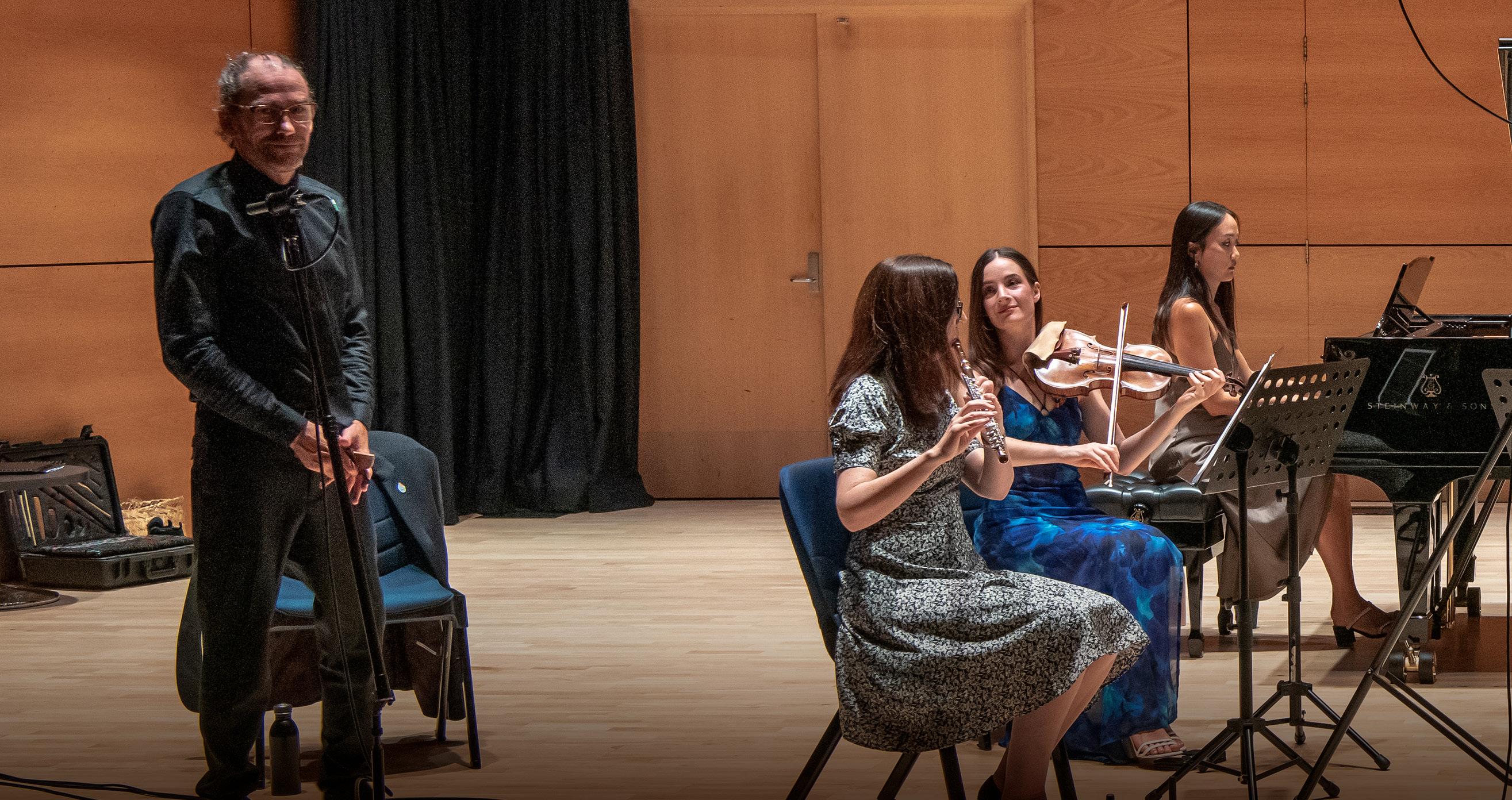
| Forest & Bird Te Reo o te Taiao 32
rust are threatening our magnificent native trees. The burning of forests and tussocks, introduction of pests, draining of wetlands, and loss of habitat through development are some of the factors that have contributed to more than 50 extinctions.
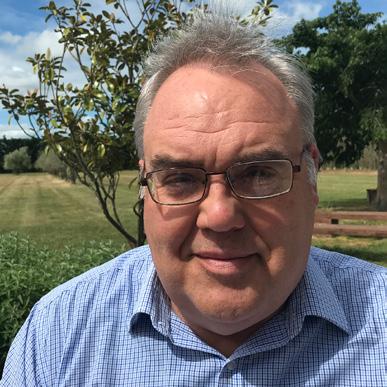
Peter Scholes is a clarinettist, musical director, conductor, and composer from Auckland.

He Awa Whiria | Braided River
MUSIC: Patrick Shepherd
MUSICIANS: Amalia Hall – violin, Ashley Brown – cello, Somi Kim – piano
He Awa Whiria reflects the organic growth of a braided river as it constantly forms, reforms, and morphs during its journey. As it flows down from the Southern Alps, the Waimakariri is typical of a braided river in that small sedimentary particles are picked up, moved, and deposited along the fluctuating route, thus changing the depth and often shape of the river bed. This process is mirrored in the music. The framework is simple, with five sections in a throughcomposed single movement form, all following stages of the river – source, current, sanctuary, torrent, and mouth.
Patrick Shepherd is a composer, conductor, performer, and teacher based in Canterbury.
Urban Lives: Longfin Eels and LongTailed Bats
MUSIC: Janet Jennings
MUSICIANS: Kathryn Moorhead – flute/piccolo/alto flute, Peter Scholes – Bb Clarinet/Eb Clarinet/Bass Clarinet, Amalia Hall – violin, Ashley Brown – cello, Somi Kim –piano, Yoshiko Tsuruta – percussion
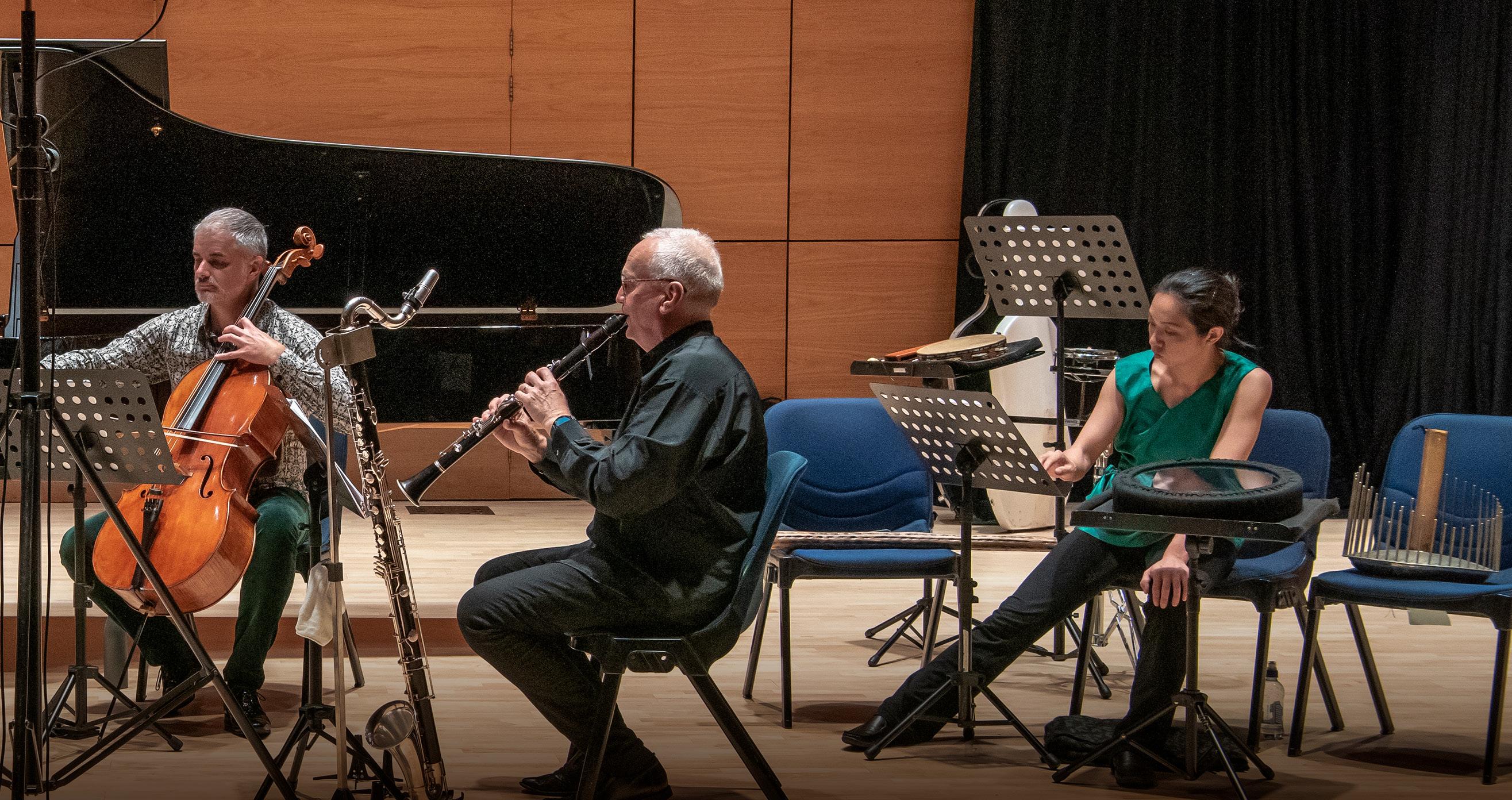
This piece focuses on tuna longfin eels and pekapeka long-tailed bats, who share our urban environments, including Hamilton City, although we may be unaware of them. The music depicts the noise and relentless pace of our own lives before heading into the water where we encounter tuna before emerging at dusk to discover long-tailed bats. The piece finishes by jolting us back into our own relentlessly noisy urban environment. Habitat loss, commercial fishing, and pollution have impacted on eel numbers and size. Critically endangered pekapeka were the surprise winners of Bird of the Year 2021. These heroic little creatures are threatened by habitat loss, predation, and introduced mammals and wasps. Forest & Bird’s Te Hoiere Bat Recovery Project, in Marlborough, is working to protect them.
Hamilton-based Janet Jennings writes for instrumental ensembles, voices, and stage (opera and dance).

→
33 Summer 2022 |
Force of Nature musicians at the rehearsals in Hamilton earlier this year. Kerry Blakeney-Williams
Pūtaringamotu | Place of Echo
MUSIC: Miriama Young, Melbourne
MUSICIANS: Amalia Hall – violin, Ashley Brown – cello, Somi Kim – piano
In a certain part of Pūtaringamotu, the last remnant swamp kahikatea forest in Christchurch, it was once thought that local iwi could put an ear to the ground to hear intruders approaching. This piece recreates an imaginary forest of song, based on imitative bird calls, many imaginary or now extinct. You will hear the huia, a sacred bird that was driven to extinction in the early 20th century. And the sound of a lone kōkako, now thought extinct in the South Island, although a remnant of their song remains in their North Island cousin’s call. The piece also captures in the piano the low, stunted mating call of the kākāpō. In musical terms, imitation is an important function in traditional forms, and it is from this place that echo can resound. What happens when one lone bachelor kākāpō remains, and his call goes unanswered?
Miriama Young is a New Zealand composer and sound artist currently based in Melbourne.
Te Toroa me te Tohorā | The albatross and the whale
MUSIC: Rob Thorne
MUSICIANS: Amalia Hall – violin, Rob Thorne – taonga pūoro, Ashley Brown – cello
Far from land, two solitary friends – albatross and whale – meet to dance and play: Ko te aroha e kōtuitui nei i a tātou. Koia te wāhi o waenganui.
Ko te hau i raro i te parihau o te toroa. Ko te moana e kau nei te tohorā Koia te huarahi me te whīkoi Koia ko te tīmatanga, koia hoki ko te mutunga o te haerenga.
It is love that connects us all. It is the space between. The wind under the wing of the albatross. The ocean in which the whale swims. It is the pathway and it is the walking. It is the beginning and it is the journey’s end.
Rob Thorne (Ngāti Tumutumu) is a composer, performer (taonga pūoro), and anthropologist. He is based in Wellington.

Ngā Manu o te Ngahere | Birds of the Forest
MUSIC: Andrew Perkins, Otago
MUSICIANS: Kathryn Moorhead – flute, Peter Scholes –clarinet, Ashley Brown – cello Ngā Manu o te Ngahere Birds of the Forest captures the resonant quality of New Zealand’s native bush and forest. The opening musical motives, developed throughout the composition, are based on the small note-group that comprises the range of the kōauau traditional Māori flute. A secondary set of longer motives are inspired by bird songs that can be heard in the forests around Dunedin, including kiwi, kākāpō, tūī, korimako bellbird, takahē, pango pango blackbird, and ruru morepork. Dr Andrew Perkins is based in Dunedin. He was Music Director and Cantor of the Auckland Catholic Schola for 13 years, specialising in the performance of early music.
Kaitiaki | Guardians
MUSIC: Alexander Alford
MUSICIANS: Alexa Still – alto flute
This piece for solo flute acknowledges the hardworking Forest & Bird volunteers who have put in a great deal of time and energy to look after and restore biodiversity in Auckland’s Waitākere Ranges. Both Alex’s parents were involved in Forest & Bird’s Ark in the Park project, and rat baiting, replenishing stoat trap lines, and a great deal of sliding in mud were a normal part of Alex’s childhood! In Māori tradition, taniwha are considered kaitiaki guardians of people, places, and resources, and are often a significant part of the natural environment. Force of Nature is a project close to Alex’s heart as a means of expressing collective acknowledgement to Forest & Bird’s contribution as custodians of New Zealand’s environment.
Alex Alford is a composer, teacher, and recording and filming engineer based in Auckland. He won a Forest & Bird scholarship to join the project and have his music recorded.


A special thank you to Jenni MurphyScanlon, of the Performing Arts Community Trust, who has worked tirelessly on the Force of Nature composers’ project over the past two years. She is currently in negotiations with several other arts festivals and hopes the music will be performed in other locations, including the South Island. Watch this space!
This project has been supported by Creative NZ, Hamilton City Council, the Lion Foundation, Trust Waikato, and the WELEnergy Trust.

FORCE OF NATURE → | Forest & Bird Te Reo o te Taiao 34
CELEBRATING NATURE THROUGH MUSIC
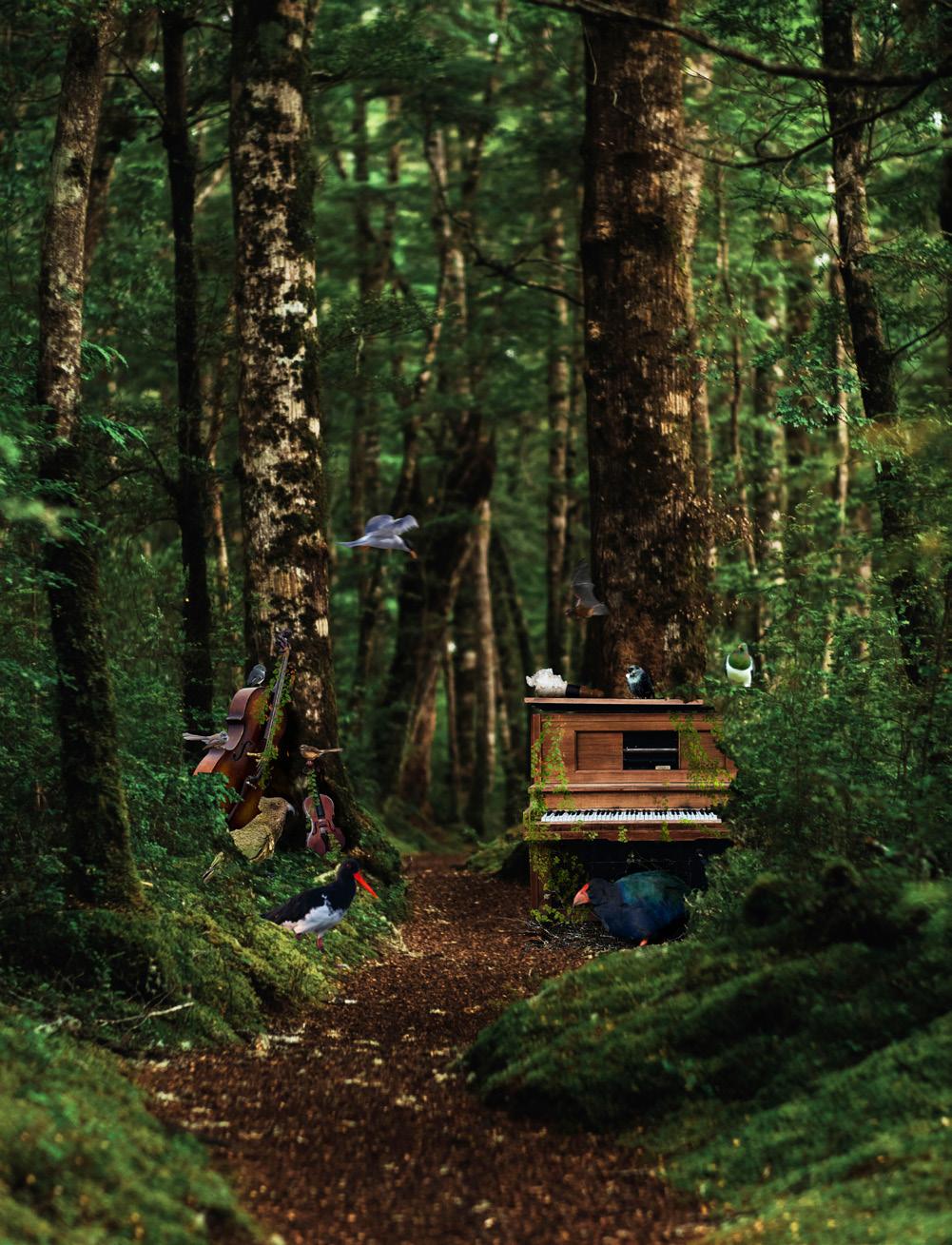
Earlier this year, the composers and musicians came together in Hamilton for a series of rehearsals and live recordings for the Force of Nature CD.
The album, which is being produced by Wayne Laird, of Atoll Records, will be released next March.
A few Forest & Bird supporters attended the live recordings to hear a sneak peek of the music.
“I thoroughly enjoyed being in the audience for the Force of Nature open rehearsal,” said Graeme Chubb. “The musicians were superb and did not hold anything back. This whet my appetite for more, and I plan to take family and friends along next year to the concerts.”
“Forest & Bird faces enormous challenges every day, struggling to hold back a tide of destruction caused by greed,” said Dr Celine Kearney.
“I walked out of the theatre feeling light and thankful for the beauty that surrounds us and the presence of the birds and eels, the whales, the tiny pekapeka bat, and the South Island’s magnificent braided rivers.”
“It was an evening of challenging and innovative music with a strong Māori thread brought to us by some of New Zealand’s finest musicians and composers,” added Christine Munday.
“The pieces emphasised the need for the conservation of our natural world. A very worthwhile project and a very enjoyable occasion.”
Te Ahurei Toi o Tāmaki | Auckland Arts Festival presents Force of Nature: a gorgeous, rejuvenating programme of new music that celebrates the great conservation work of Forest & Bird – and the precious beauty of our whenua, moana, flora, and fauna. Alongside atmospheric visual design capturing the unique environment and native species of Aotearoa, this stirring one-off performance by our own worldclass composers and performers is inspired by –and aspiring to the future of – New Zealand’s way of life.
PERFORMANCE DETAILS
Force of Nature
Friday 17 March, 6.30pm, in the Concert Chamber, Auckland Town Hall
Ticket prices range from $45 to $55 and can be purchased from aaf.co.nz

BUY YOUR TICKETS 35 Summer 2022 | Automasc and Efficient Data Logging of Weed Management Acsvises
GONE BUT NOT FORGOTTEN
The first in an occasional series about our extinct birds. Caroline Wood
Does anyone give a hoot about the long-lost New Zealand coot?
This stocky endemic species with its distinctive neck and long slim legs became extinct in prehistoric times.
This coot used to wander around our coastal wetlands, inland forested bush, and even sub-alpine environments, where it was easy prey for early Māori hunters.
Their bones are commonly found in middens, as well as natural deposits, indicating that it was frequently taken for food. Some bones discovered in two archaeological middens in coastal Marlborough were shaped into tools.
The New Zealand coot’s body proportions were similar to extant coots, so it’s thought it could fly. It was first described from Southland and subsequently found in many sites, both in the South and North Islands.

The slightly bigger Chatham Island coot was about twice the weight of current species and was once the largest coot species in the world. In 1892, Henry Forbes first discovered its bones among dune deposits on Chatham Island. Differences between the Chatham Island and New Zealand coot have been debated over the years. But, in 2002,
A naturalised Australian coot with three of her two-day-old chicks.
Roger Smith
palaeontologists Trevor Worthy and Richard Holdaway reviewed the evidence and recommended that both be considered as full species.
Both endemic species became extinct because of overhunting by humans and possibly predation of eggs and chicks by the introduced Pacific rat.
The loss of the New Zealand coot (Fulica prisca) left the way open for a close relative to move into their habitat. And that’s exactly what happened with the first recorded visit of the Australian coot in 1875, although they didn’t become established until the 20th century.
Australian coots (Fulica atra australis) resemble a paddling pūkeko, but they are smaller, about 38cm, and weigh 550g. They are sooty black with a distinctive white bill and forehead shield. Their heads rock back and forth as they swim.
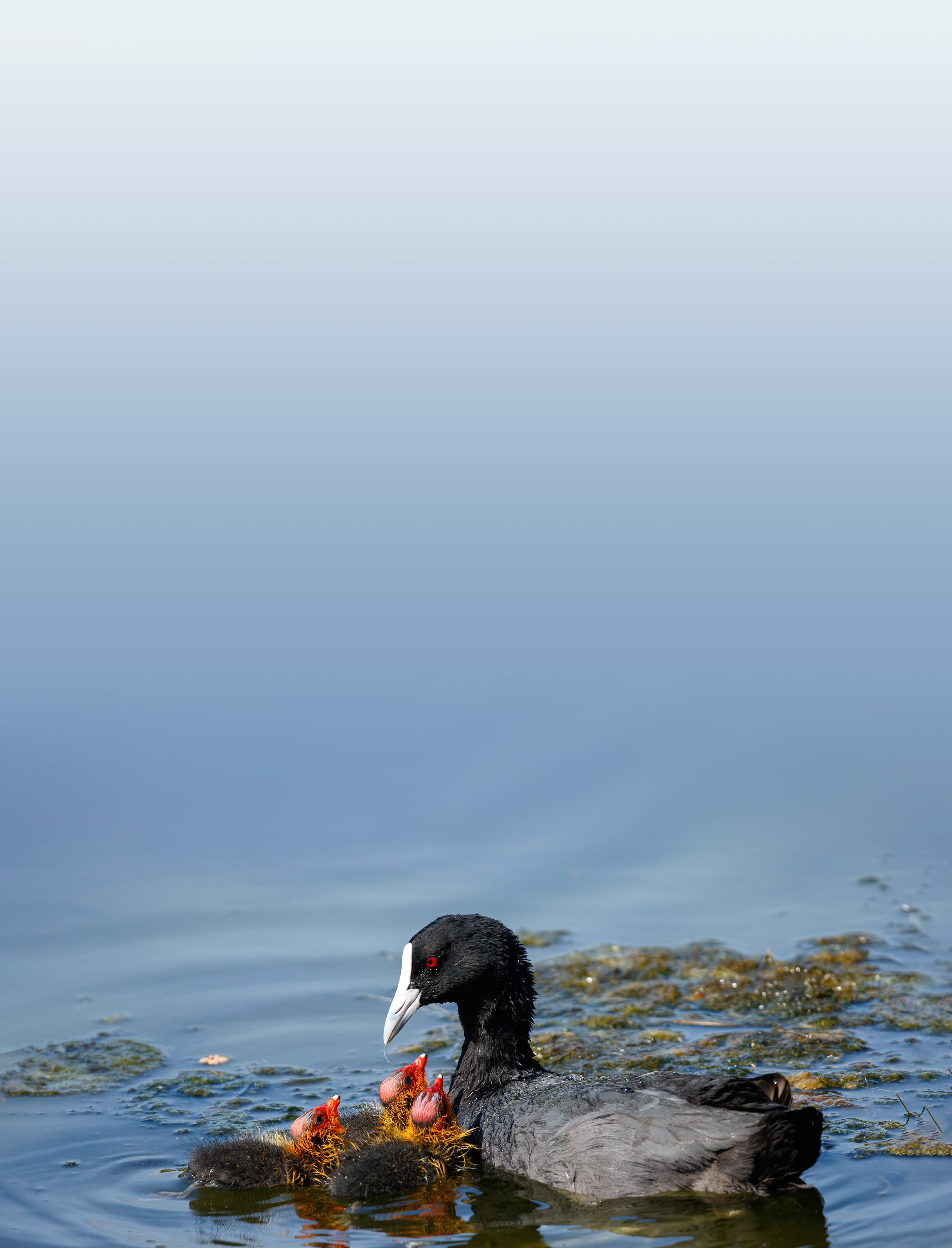
They were first recorded breeding in 1958 on Lake Hayes, in Otago. By 2005, around 2000 were distributed across lakes throughout both main islands, where they make floating nests of twig and raupō.
Today, the self-introduced native is protected in New Zealand under the Wildlife Act. It is one of four sub-species of the Eurasian coot (Fulica atra), which is native to
Europe, northern Africa, Asia, and greater Australasia.
Last December, for the first time in at least 10 years, a pair of Australian coots successfully hatched five chicks at the Waimanu Lagoon, Waikanae Beach. Many thanks to Roger Smith for sending us this wonderful shot of the family and inspiring this article.
What extinct New Zealand species shall we focus on next time? Send your suggestions to editor@forestandbird.org.nz.
BIODIVERSITY
| Forest & Bird Te Reo o te Taiao 36
The New Zealand coot became extinct in prehistoric times. Illustration by Paul Martinson. ©Te Papa
“
ARTIST Te Araroa
Irecently completed Te Araroa, a 3000km walking trail between Cape Reinga and Bluff. During the walk, I created an oil painting of the landscape experienced each day, painted from life.
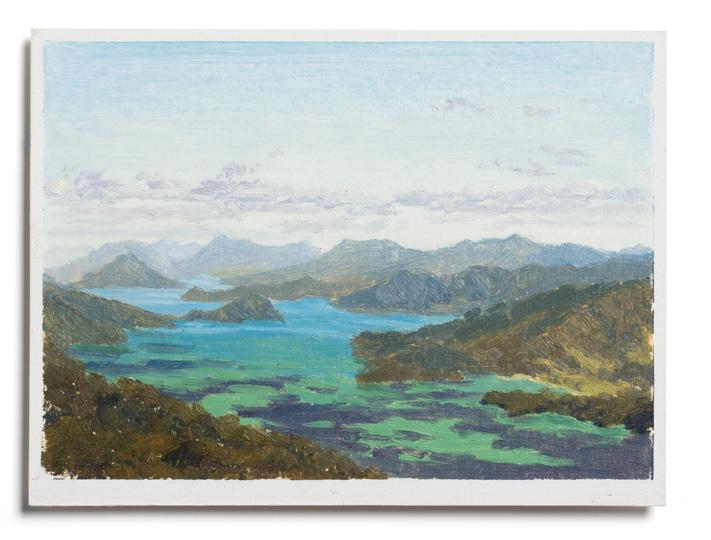
I painted 141 artworks over the five months of walking. In my pack, I carried a specially constructed case that would hold 30 postcardsize paintings at a time.
The paintings focus on the beauty and diversity that remains within our landscapes. They are being exhibited at the Depot Gallery in Devonport, Auckland, from 3 to 21 December 2022.

While tramping, I was
plants in this reserve, which isn’t open to the public.
I’m looking forward to doing plenty more painting there in my spare time!”
particularly struck by our collective human impact on the land, observable even in the remotest places – the lack of native birdsong, inaccessible forests because of kauri dieback, the intensive dairy industry’s “greening” of Canterbury and Otago.

Following my observations on the trail, I decided to support the brilliant work of Forest & Bird by donating 20% of the painting sales.
My journey also motivated me to become active in conservation. I recently obtained a role on the Marotere Hen and Chicken Islands, near Whangārei, for the Department of Conservation removing exotic

There are lots of new Kiwi-made gifts in Forest & Bird’s Christmas Shop. Every dollar raised will go towards our conservation work during 2023.

Sarah’s Te Araroa artworks can be bought from the Depot Gallery from 3-21 December either in person or online at https://www. depotartspace.co.nz. Last orders 9 December 2022 https://shop.forestandbird.org.nz
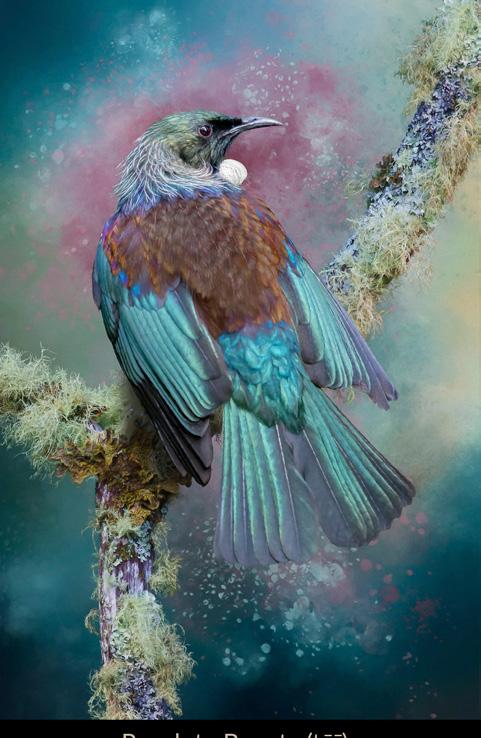
Inspired by the changing landscapes of Te Araroa Trail, Sarah Adam is donating 20% of sales from her artworks to Forest & Bird. She tells her story here.
Sarah Adam creates one of her daily artworks while enjoying the view from her outdoor artist’s studio.
37 Summer 2022 |
Two of Sarah’s Te Araroa Trail artworks: Day 117: Lake Hawea, Otago (top) and Day 74: Keneperu Sound, Marlborough
WALLABY WIPEOUT
A new way of controlling dama wallabies in the central North Island is showing promising results – but only in areas with low rat numbers.
Peter Fergusson
Wallaby are currently in the crosshairs in both islands as they rapidly expand their range and eat their way through the understorey of our forests. Here in the Bay of Plenty, we have been trying an alternative approach that may offer another control option for this voracious introduced pest.


The Manawahe Ecotrust works with private landowners in the Manawahe corridor, which runs from Lake Rotoma to the ocean at Matatā in the Eastern Bay of Plenty. The goal is to protect and enhance the biodiversity in the areas of indigenous vegetation remaining in the corridor.
Along with our sister organisation the Kōkako Trust, Manawahe volunteers have worked hard over decades to get the rat and possum numbers in the key bush areas down to very low levels.
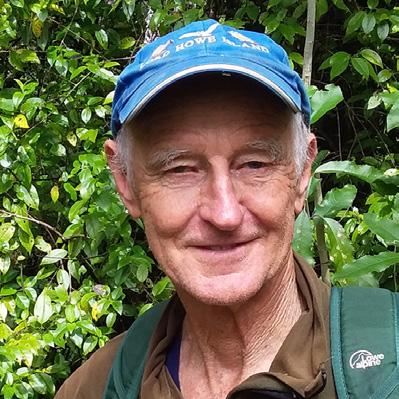
However, increasing wallaby and deer numbers are undermining the potential biodiversity gains. Wallaby have been present in the Tarawera-Rotorua area for more than 50 years but have now spread north right through the corridor to the sea at Matatā.
Unfortunately, under the Bay of Plenty Regional Council’s Pest Management Strategy, the Manawahe corridor is not a priority for intensive control. After the application of some political pressure, a small amount of funding was forthcoming, and we decided to trial
two different approaches to controlling dama wallaby.
As we have very low rat and possum numbers and limited manpower, we undertook a small-scale trial comparing two methods.
In one area of the 200ha Cell Tower block, a contractor laid Feratox encapsulated strikers along existing bait station lines at 75m spacings. In the rest of the block, we tried a different approach.
We wanted to see whether we could set up feeding stations to lure them into specific areas and then kill them with Feratox capsules.
We set up 10 feeding stations about 300m apart. Each station was centred around a Philproof bait station that had been opened up to make it more accessible to wallaby.
At each station, we attached karamu cuttings, the bait stations were filled with maize, and carrots were also scattered around. Each site was monitored with a game camera.
The cameras were checked every week. After three weeks, most of the stations showed wallaby activity. Some had family groups of three or four wallaby regularly visiting.
The sites were then set up with six prefeed strikers, which are a cereal and peanut butter lure without the encapsulated cyanide. They contain a sugar-laced placebo capsule to get them used to crunching the capsule for a sweet reward.
The cameras soon revealed the wallaby pulling off the prefeed strikers and eating them.
PREDATOR-FREE NZ
Wallaby and deer exclosure plots show the damage these browsing mammals do to the bush (left) versus the lush greenery of the pest-free area (right). Biosecurity NZ
Dama wallaby Bay of Plenty Regional Counci
| Forest & Bird Te Reo o te Taiao 38
Peter Fergusson
The final step was to replace the prefeed placebo strikers with six encapsulated cyanide strikers. We placed three cyanide capsules in each striker and put Pindone and encapsulated cyanide in the bait stations as they were readily feeding from these.
The sites were checked for wallaby carcases. Initially we were hoping for 20+ bodies, but in the end we only located eight carcases. However, we kept the cameras running and replaced the Feratox-laced strikers.
It seems the family groups may have been visiting a number of different feeding stations and giving an inflated idea of the population density.
Also some wallaby were seen to eat a striker and then stagger away never to be located. Some may have also succumbed to Pindone and died elsewhere. Corpses may also have been scavenged by pigs.
The alternative method of just placing strikers at 75m intervals along bait station lines (and no feeding stations) produced no kills in our block but did produce four carcases in another trial area.
We allowed a couple of months to pass then resurveyed the block using game cameras set up on automated lure pumps.
The cameras were set up in multiple locations along the bush-pasture border and also at each of our 10 feeding stations. The cameras ran for weeks at each location, but no wallaby were recorded at any site.
We are certainly not claiming to have removed all of the wallaby, but the feeding station method seems to have been an effective way for a volunteer group to reduce wallaby numbers in small bush blocks.
This effort will probably have to be repeated every couple of years to deal with the reinvasions, but we would be able to space the stations further apart.
Our group tried to export this method to another small property that had a wallaby infestation, but the results were very illuminating – the difference being rats!
We set up bait stations and prefeed strikers, and they were quickly consumed, so we then went to the cyanide
encapsulated strikers. These were consumed rapidly, but no wallaby carcases were found.
I installed cameras to see what was going on, and the problem quickly became obvious. This site had an infestation of rats that were gobbling the strikers but not the cyanide, so the wallaby had no access to the bait.
A “rat proof” wallaby feeding station was designed and mounted on a silicon-sprayed metal pipe, and we repeated the exercise, with cameras monitoring the result.
I had clearly underestimated the agility of the ship rat, with the cameras revealing three rats at a time happily sitting on the top of the stands eating around the cyanide capsules. Again no wallaby kills.
There is a lot to learn about controlling wallaby, and the feeding station method is a promising option.
But we have discovered that it is very difficult to use the feeding stations to control wallaby effectively unless the rats and possums have already been knocked back to very low levels.

Peter Fergusson is the biodiversity coordinator for Manawahe Ecotrust and Secretary of Forest & Bird’s Eastern Bay Branch.
FOREST & BIRD SUPPORTS NATIONAL WALLABY STRATEGY
Nicky Snoyink, Forest & Bird’s Canterbury and West Coast conservation advocacy manager, sits on the government’s National Wallaby Programme Governance Group. The group, which is led by Biosecurity New Zealand, is made up of representatives from mana whenua, the Department of Conservation, regional councils, LINZ, Federated Farmers, and Forest & Bird. It has developed the Tipu Mātoro Aotearoa New Zealand National Wallaby Strategy, which sets the broader direction for wallaby-free Aotearoa. It is aligned with Te Mana o te Taiao the New Zealand Biodiversity Strategy and focuses on getting the management system right, working with communities, and empowering people. The governance group, supported by various advisors, also makes key decisions about wallaby management in New Zealand and oversees the allocation of wallaby management funding.
Keturah Bouchard checks the bait station in one of the trial areas.
Manawahe
39 Summer 2022 |
Lake Rotoma Kawerau
BRINGING BACK
BITTERNS
Aotea Great Barrier Island is home to significant natural wetlands that retain much natural character, including the 320ha Kaitoke swamp and the 400ha Whangapoua wetland, mangroves, and estuarine system. Together, they constitute the biggest wetlands in the Auckland region.
This is a dynamic system, potentially susceptible to climate change-driven storm events and sea-level rise.
Since January 2021, a small group of conservation volunteers – mainly Oruawharo Bay residents – have been restoring a rear dune wetland at Oruawharo Medlands Beach on the southeast coast of Aotea.

Oruawharo Bay used to have an extensive wetland, but most of it was drained and converted to pasture last century. A small remnant of this former swamp area, trapped between the main road (the only road!) and homes dotted among the dunes, is the subject of this article.
Since the Oruawharo wetland was drained many years ago, dry years have allowed an influx of rats and weeds, and during wet years feral pigs invade to dig up raupō rhizomes (and everything else).

Aotea has the largest area of possum-free forest in the country and no mustelids, hedgehogs, deer, or goats. Unfortunately, feral pigs, feral cats, ship rats, and kiore are still causing massive amounts of ecological damage.
In late 2018, a small group of residents formed the Oruawharo Medlands Ecovision Group with the goal of restoring the ecological health and biodiversity of their bay. At this point, wetland protection and restoration on the island was almost non-existent.
We applied for funding so we could launch an ambitious wetland restoration programme to remove exotic invasive plants, trap predators, and restore
habitat for rare birds, including matuku hūrepo Australasian bittern and pāteke brown teal, reptiles, and invertebrates. Our work is supported financially by Great Barrier Local Board and the Department of Conservation.
DOC provided funding for rat and feral cat control, pampas (Cortaderia selloana) control, and judicious planting. Auckland Council, always supportive, has the wetland listed as a Biodiversity Focus Site Area. Upstream landowners Aotea Brewing started riparian planting, and the Aotea Great Barrier Environmental Trust offered administrative support.
We sample the water quality quarterly using the Waicare platform. The Oruawharo wetland changes from saline estuary at one end to mostly fresh water at the other. But the overlap between these influences varies almost weekly.
A layer of volcanic ash at about 50cm deep in the sediment indicates most of the area was a shallow saline lagoon before 1300AD. Soon after, local fires and increased erosion caused rapid infilling and the spread of raupō.
FRESHWATER
The highs and lows of restoring a remnant wetland on Aotea Great Barrier Island. John Ogden and Lotte McIntyre
The Oruawharo wetland planting and weeding brigade get to work. From left, Kim Bannister, Raoul Stuart, Jennifer Neads, John Ogden, Frances McClure, and Margaret Jemmett.
| Forest & Bird Te Reo o te Taiao 40
The Oruawharo wetland. Lotte McIntyre
As the surface dried, mānuka invaded, creating a greater fire risk. Human-engineered drainage reduced the area to its present extent and lowered the surface. The dry organic matter oxidised and shrank, rendering it more susceptible to flooding. Sea-level rise may yet recreate the former lagoon!
These changes and variation over time emphasise the importance of having a clear goal for our restoration. What exactly are we aiming to restore?
In our first vegetation survey, we found raupō and jointed twig rush (Baumea articulata) form most of the vegetation, but alien weeds accounted for a whopping 80% of the 30 plant species.
We know certain plants, now abundant, were not present in the system before European times, in particular kikuyu (Pennisetum clandestinum), pampas,
WHAT’S IN THE WETLAND?

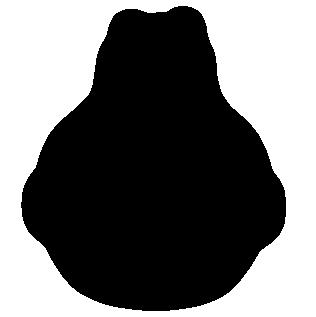




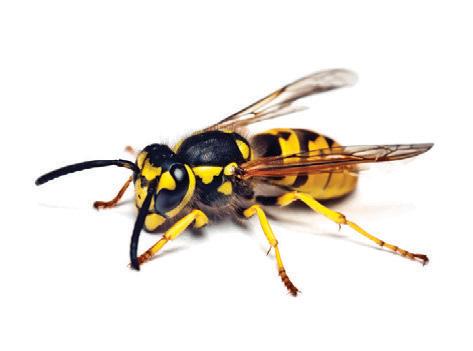
Matuku hūrepu bittern are under threat from habitat loss throughout New Zealand, and the presence of one, sometimes two, bitterns in our wetland is reason alone for protection.
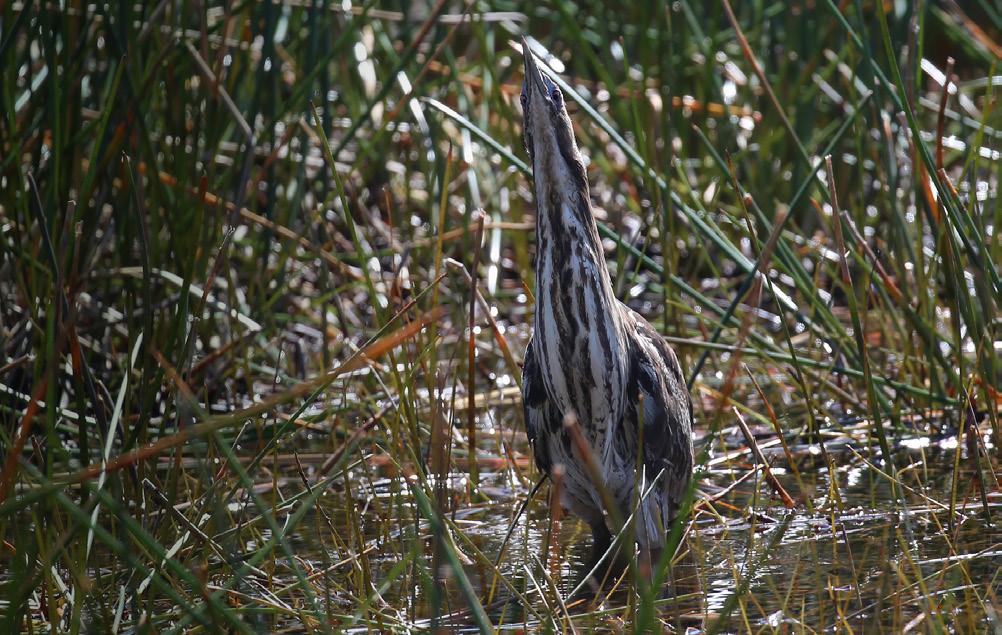
Other birds that visit include matuku moana white-faced herons, kawua tūī little black shag, spur-winged plover, and pūkeko. Mātātā fernbirds have been seen, and spotless crake are present in the Kaitoke wetland, so we are hopeful that soon they will return to Oruawharo. We have little idea what lives in the creeks, except galaxiids, common bullies, and eels, and southern bell frogs in the ponds. There is almost no knowledge of the insect life except for dragonflies and a few moths, but welcome swallows are consistently present, so there must be plenty flying about. There are moko skinks in the wetland and niho taniwha chevron skinks a little further up the creek. Although Aotea is supposed to be a stronghold for pāteke, their numbers are declining, so creating forest wetlands free of predators where these brown teal can successfully breed is vital for their survival as a species. We plan to plant a narrow zone of salt marsh ribbonwood (Plagianthus divaricatus)
and Mexican devil (Ageratina adenophora). Our first, and perhaps hardest, restoration goal is to remove these alien plants and replace them with native species that were formerly present.
We have reduced huge clumps of pampas by judicious use of herbicides and hand-operated weed eaters that can cut down the clumps. These areas are being planted with mānuka, harakeke flax, tī kōuka cabbage trees, and kahikatea, which will hopefully prevent much pampas regrowth or re-invasion. Harekeke will be used to create dams to retain water in summer.
Our aim is to restore a mix of ecosystems each inhabited by their characteristic birds. We plant raupō around shallow pools, twig rush in older areas with deeper sediments, and mānuka on drier areas converting to more varied forest with time. Kahikatea will replace Casuarina she-oak, creating shady habitat for pāteke on the old creek.
Native vegetation cover will create a better habitat for other birds, including pārera grey duck in drains and ponds, bittern in the raupō, pūweto spotless crake
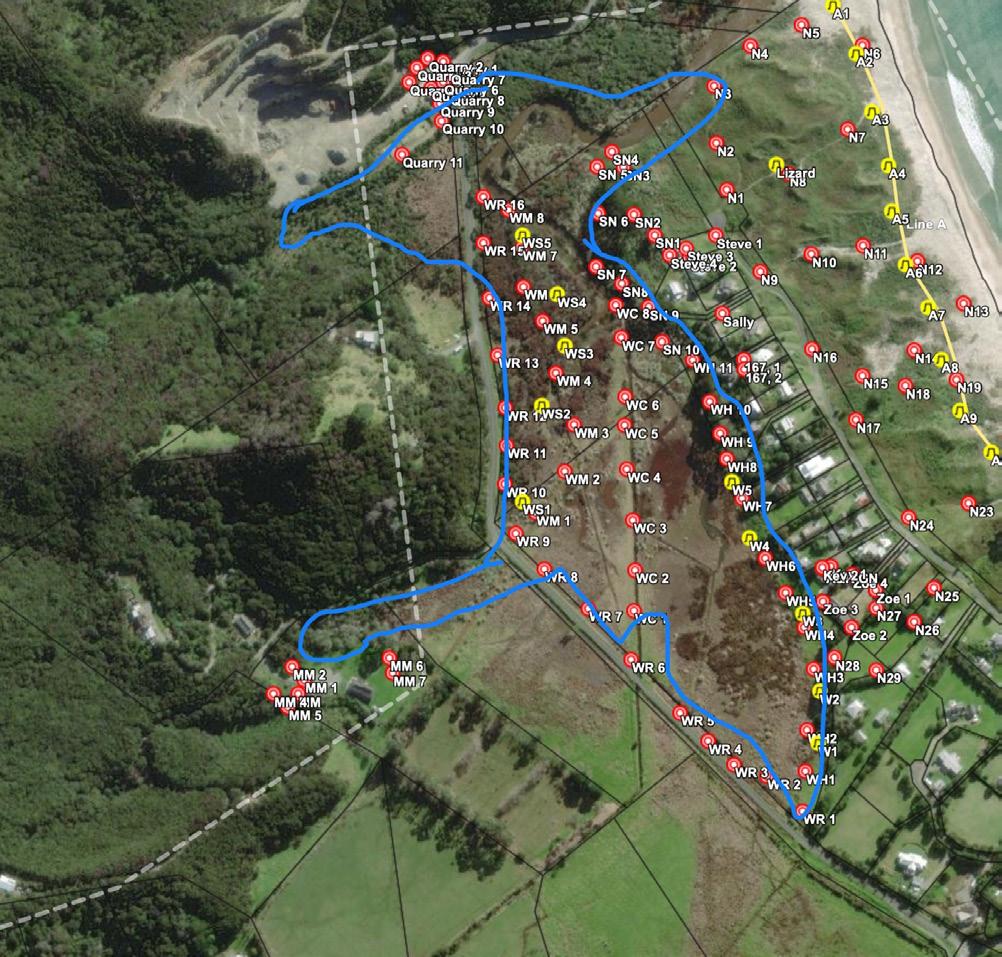
→
along the saline creek section for the pāteke.
Matuku-hūrepo bittern. Matthew Herring
KEY Red dots = traps Yellow dots = tracking tunnels Purple dots = bird count location 2019–2021.
The Oruawharo Medlands Ecovision project area. The blue line shows the wetland boundary.
41 Summer 2022 |
in the twig rush, matātā fernbird in the mānuka and Gleichenia fernland, and shags coming in from the coast to catch eels and other native fish.
Nearly 500 plants from the two nurseries on the island have been planted this year. Most of these went into the raised ground alongside the drains, helping shade out the kikuyu. Around the ponds, we will plant harakeke, cabbage trees, oioi, and Carex secta. Where mānuka is already established, we will try mahoe, red matipo, kawakawa, and karamu.
We have a small group of dedicated volunteers to get all this work done. It is a big restoration project on an island with a small available workforce. It is the same handful of people showing up to clear grapevines and pampas seedlings – but what a difference they have already made in two years!
This important restoration project presents an opportunity to show the public what lives and breathes in this wetland – flora as well as fauna. Knowing that Oruawharo Medlands is a tiny component in the wider wetland web connecting the coastal areas of Aotea – in both space and time – is both sobering and exhilarating.

Making the wetland accessible with pathways, boardwalks, and bridges would be an amazing way for locals and visitors alike to experience a beautiful ecosystem and biodiversity gradient.
Our original vision for the wetland included the installation of picnic benches, informative signs, areas to contemplate and carry out a spot of bird watching, and a relaxing meandering walking track to view the scenery.
But, to date, no funding has been available from the local council or DOC for this sort of infrastructure, so these plans have been put on the backburner for now, though not forgotten.
Our volunteers are brimming with enthusiasm to see the full project, including new visitor amenities, being accepted by the authorities and supported by the local and regional community.
John Ogden is a retired associate professor of Ecology at the University of Auckland. He has been involved in wetland ecology for 50 years.
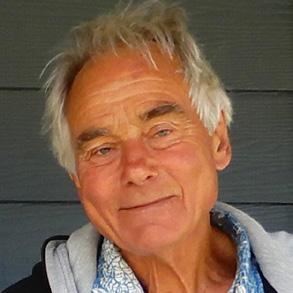
Lotte McIntyre is the project coordinator, an enthusiastic wetland novice who also runs the local Aotea Trap Library.

REVERSING WETLAND LOSS
Wetlands are referred to as nature’s kidneys because of their natural filtration system and their capacity to mitigate flooding and erosion. Coastal wetlands are a vital link between land and sea, shaped by factors such as the underlying geology, soil type, and climate as well as salinity, current velocity, and the permanence or transience of the water.
In the Auckland region, 97% of wetlands have been destroyed because of drainage and development, so protecting and restoring what we have left is widely seen as a priority today – not only in the Auckland region but nationwide.
Wetlands are home to many native species, both plant and animal, some of which are now endangered because of this huge loss of habitat. These areas also act as nurseries for native fish, as well as many birds and plants.
This article was inspired by Forest & Bird’s Every Wetland Counts campaign. To download a copy, go to www.forestandbird.org.nz/everywetlandcounts.
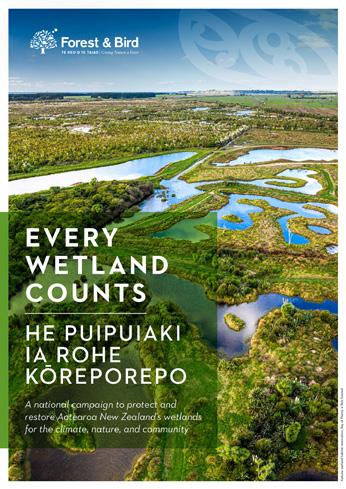
SUTHERLAND RESERVE OPENS TO PUBLIC
When Archibald Sutherland died in 1967, he left 2,700 acres of land to various charities. Two blocks of bush he gave specifically to the Forest & Bird Protection Society with a generous endowment for their future preservation. Since then, members of the Rangitikei Section have worked more than 400 hours building fences to exclude stock, tree planting, spraying ragwort by helicopter, making tracks and a foobridge, tree-labelling, and setting up picnic areas.
Forest and Bird, Issue 186, November 1972
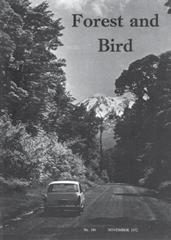
FRESHWATER
→ | Forest & Bird Te Reo o te Taiao 42
Raupō is the main cover of the system in the shallower flooded areas of the wetland.
LEARNING IN NATURE
UCOL Wairarapa students are learning how to protect wildlife in a unique outdoor classroom at Pūkaha National Wildlife Centre Megan Smith
Mature student Tracy-Lee Kawana, 35, is living her dream gaining knowledge to provide a better life for her son and being able to give back to her iwi, Rangitāne and Ngāti Kahungunu.
After spending 15 years living abroad, Tracy-Lee arrived home feeling burned out. Combining her love of the outdoors with a desire to learn more about her country, she signed up to study for a certificate in conservation (Level 4) at UCOL | Te Pūkenga Wairarapa.
But Tracy-Lee doesn’t study inside a grey concrete teaching building. Instead, you will find her walking through the vibrant native forest at Pūkaha National Wildlife Centre, near Masterton, in the company of her mātauranga Māori tutor Warren Chase.

“I grew up with mātauranga Māori – I didn’t know it then, but I did. Part of my childhood was spent around Pūkaha, eeling and fishing. We’d always go home with a cool feed,” says Warren.
“My role is to support students with mātauranga Māori. We challenge them. I encourage them to develop their own beliefs about who they are and then stand up in front of people and share who they are.
“Pūkaha is special – it is the remnant of Te Tapere nui o Whātonga, a great forest that sustained our people.”
This win-win partnership between UCOL Te Pūkenga and Pūkaha National Wildlife Centre is creating work-ready rangers who will help protect flora and fauna across Aotearoa for generations to come.
Tracy-Lee spends two days at UCOL Wairarapa and the rest at Pūkaha, reserves, or local farms.
“Being back in the forest has helped me to release emotional and physical issues because I am free. I’m not living to work, I’m working towards a different living,” she says.
“I absolutely love getting up every day and coming here, getting outside and learning not just about the outdoors but the mātauranga Māori that is part of it all, which is my roots, my heritage.”
Tracy-Lee says she is blessed to be a trustee of Okautete Reserve, a patch of native bush near the coast, which is home to the last remaining stand of kahikatea in the North Island.
“This land was home to my tīpuna Ngā Pine, whose mauri is found here, within reach of Te Maipi Maunga and the Kaiwhata awa. Everything I learn from here will go straight back into local whenua to help in its growth for our future,” she adds.
UCOL’s New Zealand Certificate in Conservation (Operations) Level 4 is unique. Students learn to assess an environment – whether a wetland, forest, or dune area – identify native weeds and pests, and create a plan to remove them.
“This is the second year of the programme,” says Pūkaha General Manager Emily Court. “Nearly everyone from the first group is now employed in the sector.”
From 2023, UCOL | Te Pūkenga students will learn from a new purpose-built education centre with a wharenui and space to hold wānanga and for 90 to 100 people to stay overnight.
For more information, see https://www.ucol.ac.nz.
EDUCATION
Tama Halliwell and Tracy-Lee Kawana, with UCOL’s māturanga Māori tutor Warren Chase and Pūkaha Wildlife Centre’s general manager Emily Court.
43 Summer 2022 |
IS TIME RUNNING OUT FOR OUR MYRTLES?
Five years since myrtle rust arrived on our shores, scientists are closer to finding tools to manage this devastating disease, but it’s a race against time and a deadly pathogen Jenny Leonard
There is a monster roaming Aotearoa New Zealand, a fungal pathogen that weakens some trees and kills others. Wind borne and insidious, the disease it causes – myrtle rust –is seemingly impossible to stop in its tracks.
Myrtle rust, the Covid-19 of the myrtle family, is a serious, deadly global disease. And, like coronavirus, we’ve come a long way in understanding it in the time that it has been in New Zealand.
Researchers are now on the cusp of finding much-needed solutions to manage the disease and help preserve these iconic and culturally important flora.
Myrtle rust is caused by the fungal pathogen Austropuccinia psidii, which only infects plants from the Myrtaceae (myrtle) family.
Our native myrtles include pōhutukawa, mānuka, and kānuka. But, so far, it is our lesser-known species – ramarama (Lophomyrtus bullata), rōhutu (Lophomyrtus obcordata), and maire tawake (swamp maire, Syzygium maire) –that have been hit the hardest.

Ramarama has been devastated in the East Cape, and severe infections have been observed on maire tawake, a tree that is already Threatened–Nationally Critical.
Myrtle rust is not just an ecological crisis – it is a cultural crisis. Our trees are taonga, and they deserve whatever help we can muster.
Luckily, the threat of myrtle rust was well known before it arrived on our shores from Australia, and the research that has been conducted here in Aotearoa in the past five
years is delivering promising results.
Notably, our scientists have contributed to the sequencing of the A. psidii genome. This paved the way to a deeper understanding of how the disease functions.
“We’re understanding more about the genes that are turned on early in the infection process,” explains Mahajabeen (Maj) Padamsee, programme leader for MBIE-funded Beyond Myrtle Rust at Manaaki Whenua Landcare Research.

For example, University of Canterbury researchers in collaboration with Plant & Food Research have been able to express and purify the first ever A. psidii effector protein. Effector proteins are used by the pathogen to manipulate the host plant’s cells.
Once researchers determine which proteins on the plant’s side are being manipulated, they can look for ways to stop that interaction and hopefully prevent myrtle rust from developing.
As much as we are discovering about the disease, we are also learning about the important roles that myrtles play in our diverse ecosystems. A recent study found that Myrtaceae is one of the most ecologically important families in our woody ecosystems in terms of abundance, species richness, and potential for capture and storage of carbon.
Frontline tools, including infection risk maps and pruning protocols, have been developed using preliminary research. These tools can be used to inform when and where to monitor and how to minimise myrtle rust in urban environments.
“We are also supporting mana whenua to develop management plans for their rohe,” says Beccy Ganley, science leader for Ngā
BIOSECURITY
Maj Padamsee
| Forest & Bird Te Reo o te Taiao 44
Myrtle rust on pōhutukawa. Jenny Leonard
Rākau Taketake, a Strategic Science Investment Fund (MBIE) programme within the BioHeritage National Science Challenge. “These management plans incorporate mātauranga Māori as well as these other tools.”
Beccy sees research and operations, including management plans and the application of research, as inextricably linked.
“It’s like a rowboat, where operations and research are two oars. You can kind of keep moving with one oar, but it is slow, inefficient, and not always in a forward direction.”
There are key research and operations areas that stand to deliver significant results in the near future.
For example, New Zealand scientists have started research that parallels ground-breaking RNA interference (RNAi) research in Australia. RNAi, a mechanism where small pieces of RNA shut down protein translation, is a potential chemical-free treatment for myrtle rust.
Using this technology, the Australian team has designed double-stranded RNA (dsRNA) that successfully compromises myrtle rust’s ability to infect its host. RNAi tools are easy to apply, highly specific to the target organism, and easily changed if resistance evolves.
At home, New Zealand researchers have been finding more and more microorganisms that live on, in, or near native myrtles that may help them fight disease by boosting plant immune systems or by interfering with pathogen function.
There is also at least one fungus that parasitises [infests] myrtle rust, and there are larvae from a species of gall midge that feed directly on the spores. These discoveries are promising first steps to developing native biocontrol agents.

High on the list of priorities is seed conservation. The seeds of our three most vulnerable plants cannot be stored with conventional seed banking methods. Organisations across the country are racing to find ways to conserve these seeds to ensure survival of taonga species should the worst happen.
Researchers are hopeful for the growth and expansion of research, the application of this research, and the national coordination of a myrtle rust response in the years to come.
“I’d like to see a national strategy with national coordination,” says Beccy. “Within that, there would be funding for operations and long-term science.
WINDOW TO THE FUTURE
Native to South America, the fungal pathogen that causes myrtle rust arrived in New Zealand in 2017. It is thought to have blown across the Tasman from Australia. Home to about 2000 myrtle species, Australia has been dealing with the disease since 2010, seven years longer than Aotearoa. This gives us a window into the future, and it’s frightening. Things have got so bad that Australia could lose 16 rainforest plants within a generation in a myrtle rustdriven extinction event.
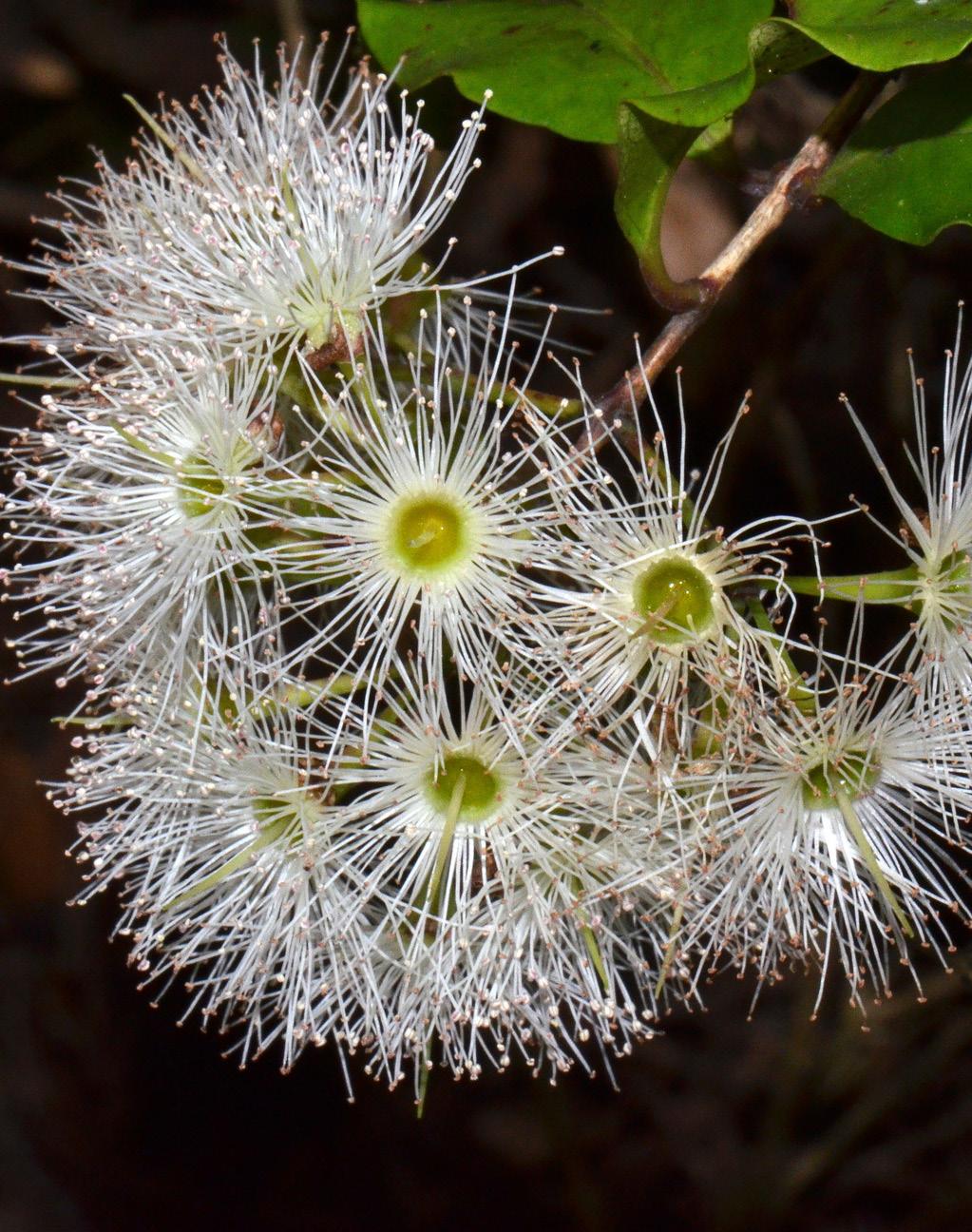
“All of this would be inclusive of mātauranga Māori and led by Māori priorities.”
Stay up to date with the latest myrtle rust research at Beyond Myrtle Rust https://www. landcareresearch.co.nz/ discover-our-research/ biosecurity/ecosystemresilience/beyond-myrtlerust/ and BioHeritage, the parent organisation for Ngā Rākau Taketake – see https:// bioheritage.nz.
 Beccy Ganley
Myrtle rust on a swamp maire leaf. If you see myrtle rust in your garden or while tramping, please report on iNaturalist NZ https://inaturalist.nz
The critically endangered endemic swamp maire is one of three native species most at risk from myrtle rust. Pat Enright/iNaturalist
Beccy Ganley
Myrtle rust on a swamp maire leaf. If you see myrtle rust in your garden or while tramping, please report on iNaturalist NZ https://inaturalist.nz
The critically endangered endemic swamp maire is one of three native species most at risk from myrtle rust. Pat Enright/iNaturalist
45 Summer 2022 |
TIME TO SLEEP
that knits up the raveled sleave of care, The death of each day’s life, sore labor’s bath, Balm of hurt minds, great nature’s second course, Chief nourisher in life’s feast,” Macbeth
Balm of hurt minds, great nature’s second course, Chief nourisher in life’s feast,” William Shakespeare describes sleep in a nutshell. Scientists say the same, though in more technical detail. In laymen’s terms, while we are asleep, our bodies are doing the housework.
The brain is storing information from the waking hours and putting out the clutter, nerve cells are communicating and reorganising, cells are getting repaired, hormones and proteins are being released, and our energy is being restored.
It is similar for all animals. We cannot do without sleep, and, as best can be established, all the vertebrate animals sleep and even invertebrates like insects and spiders have periods of rest.
Sleep comes in stages. First, there is quiet or deep sleep, also known as slow-wave, non-REM (rapid eye movement) sleep. Then there is active or REM sleep. Animals need both kinds of sleep.
A sleeping animal is in a state of unconsciousness. It can wake up, unlike being in a coma, but it is largely motionless and unresponsive.
This makes it vulnerable, which is particularly undesirable if you are a herbivore and potential food for a predator, so herbivores tend to sleep less and for briefer intervals than predators.
Top predators such as lions sleep up to 20 hours during a day, especially after feasting on a gazelle. The gazelles sleep lightly, bunched together in herds for safety, taking turns to sleep and to be awake and on guard.
Diet plays a part in patterns of sleep. A belly full of meat will sustain the lion much longer than a belly full of grass, for which the herbivore must constantly be foraging.
Well-fed humans sleep about eight hours a day, and, from the cave to the warm, dry house, we have created safe and snug places to sleep in. Our pet cats and dogs also sleep long hours, about 15 for cats and even longer for dogs.
Like us, they lie down to sleep and, like us, they dream, with twitching whiskers and clenching paws, as they enter a period of active REM sleep.
Other species sleep in very different ways. The gazelles and
herd animals like sheep, cattle, and deer only sleep in short snatches four or five hours in a day. They need to be able to wake quickly and run if a predator approaches.
They can have quiet sleep while standing up, by locking a set of muscles and tendons into place. They still need active sleep, and, for that, the muscles relax and the animal has to lie down.
Most birds are active by day and sleep at night. Many predators hunt at night so perching in groups, high on a tree branch, gives some security, but birds that sleep on the ground or on water are particularly at risk.

They are helped by a remarkable adaptation. We humans cannot be both awake and asleep, but a bird can do both.

IN THE FIELD
Different animals have evolved ingenious ways to sleep while minimising the risks of grabbing some shut eye, as Ann Graeme discovers.
Whio in unihemispheric sleep. Gavin Klee
“Sleep
“ | Forest & Bird Te Reo o te Taiao 46
Spoonbills roosting. Gavin Klee
When you see a duck with its head under its wing and one eye open watching you, that side of its brain may be asleep. The other side of the brain, hidden under its feathers, is awake and decoding messages from the open eye.

This is called unihemispheric sleep, in which one hemisphere or half of the brain sleeps while the other half stays awake. Natural selection has favoured this ability not only in birds but in dolphins and whales.
Dolphins and whales cannot surrender to a deep sleep, not because they fear predators but because they don’t breathe automatically. They need to decide
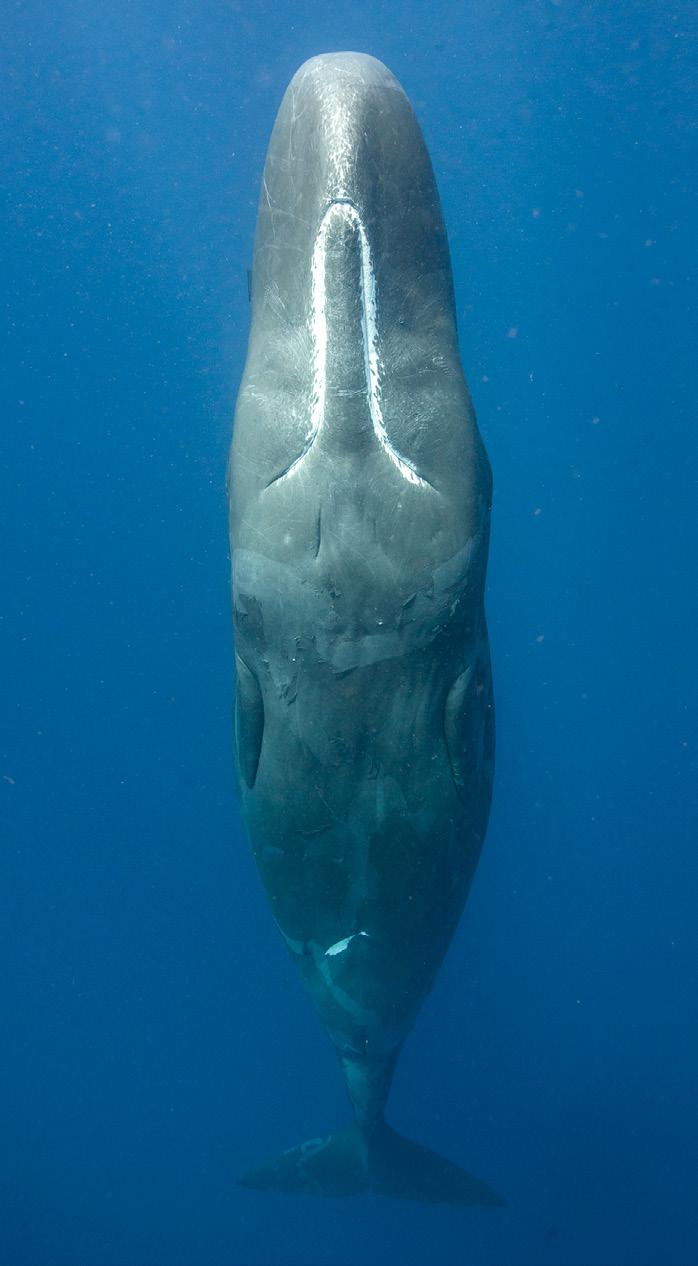
when to breathe, and to do so they must keep one side of the brain awake. If they slept deeply like we do, they would stop breathing and suffocate or drown.
It has long been thought that migratory birds must snatch some rest. How else could E7, the legendary godwit, have flown 10,219km, nonstop, from Alaska to New Zealand?

It was hypothesised that the bird was using unihemispheric sleep, keeping the bird flying on course. In 2016, a team of scientists proved this, making electroencephalogram
recordings of great frigatebirds, birds that fly over the ocean for days at a time.

Sleep is universal among animals, so it must provide real benefits. Otherwise, it would have been eliminated by natural selection.
Different species have evolved ingenious ways to minimise the risks sleep poses. Remember this when next you see ducks sleeping on the pond or a paddock of cows lying down. Some will be awake, chewing their cuds, but others may be having bovine dreams.
LET SLEEPING BIRDS LIE
Water birds and wading birds roost together, for there is safety in numbers. They sleep with their heads under their wings, and, if you look carefully (and preferably with binoculars from a distance), you will see that some have one eye open. The others, with both eyes closed, are relying on these sentinels to wake them if danger approaches. Sea birds must sleep on land during storms for there is no rest to be found at sea. Migratory birds must sleep to husband their strength for the journey ahead. Wading birds must sleep when the tide is high, as they need to feed when the tide goes out. Careless people and dogs can waken and send flocks of birds into flight, wheeling and calling as they seek another place to rest. Their sleep is precious. Let them sleep undisturbed.
CHANGING TIMES
In ancient Aotearoa, danger came from the sky. At night, kiwi used to snuffle and rake the leaf litter, careless of making a noise because avian predators such as the giant eagle were asleep. Now they may meet a night-hunting stoat. Many native birds such as tiēke saddlebacks used to sleep safely near the ground at night. Not anymore.
A sperm whale sleeping vertically. iStock
Resting seagulls. Lins Grant
Bar-tailed godwit in flight. Mike Vincent
47 Summer 2022 |
Oystercatchers have a reflective moment. John Nelson
HIGHLIGHTS AND WINS 2022
As another year draws to a close, we’re looking back at our collective mahi speaking up for nature. Thank you for being part of Te Reo o te Taiao and helping us achieve so much together!
JANUARY
NEW LEADERSHIP
It’s announced that Nicola Toki will become Forest & Bird’s new kaiwhakahaere matua and our first female chief executive when Kevin Hague retires. She starts work in April, saying she is delighted to join a “society of good hearts” and is looking forward to building strong authentic relationships with members, iwi, and all our partners. In June, new Conservation Minister Poto Williams visits Forest & Bird’s Wellington office to officially welcome Nicola to the role and pay tribute to Kevin Hague’s contribution to conservation.
ARK TURNS 20
In 2002, Waitākere Branch volunteers founded Ark in the Park, an ambitious landscapescale restoration project west of Auckland. Located within the Waitākere Ranges Regional Park, this unfenced sanctuary is home to ancient forest giants, pristine waterfalls and streams, and some very special wildlife, including reintroduced kōkako.
FEBRUARY
EVERY WETLAND COUNTS
Forest & Bird calls for a doubling of the number of natural wetlands by 2050 and publishes a special report on the significance of wetlands for New Zealand’s climate, community, and biodiversity. Supported by 10 other environmental NGOs, we set
out five more actions that could reverse the decline in the country’s wetlands. We also launch a petition to support our Every Wetland Counts campaign, which is delivered to Parliament by the Hon Eugenie Sage in July.
NATURE-BASED SOLUTIONS

A major priority for Forest & Bird during 2022 is advocating to ensure the government includes naturebased policy solutions in New Zealand’s Emissions Reduction Plan and its Adaptation Plan. During the year, we raise awareness about how nature-based solutions can be a powerful antidote to climate change. We publish research showing how ramping up predator control, rewetting drained wetlands, restoring coastal dunes, and including agriculture in the Emissions Trading Scheme can help New Zealand meet its climate targets while boosting indigenous biodiversity.
MARCH
SAVE OUR SHARKS
We call for an end to the needless slaughtering of blue sharks caught as bycatch in Aotearoa waters. In a hard-hitting media campaign, Forest & Bird’s marine team reveals some of the cruelty inflicted on these marine creatures after discovering some disturbing observer reports in an Official Information Act request. We want to see a ban on the practice of ripping out the hooks
and throwing injured live animals back into the ocean. In August, we make a detailed submission to the government on its draft National Plan of Action on Sharks. Toothrific shark art is created by KCC members to support our call for stronger shark protection measures.
MARINE MATTERS
In March, Forest & Bird writes to the Minister of Oceans and Fisheries David Parker calling on him to close the Northland and Coromandel scallop fisheries after a NIWA report shows huge declines in scallop beds from Northland to the Coromandel and the top of the South Island. The following month, the Minister announces he is closing nearly all the scallop fisheries to give them time to recover. Meanwhile, our strategic advisor Geoff Keey is appointed to the government’s Hauraki Gulf Fisheries Plan Committee, which is advising on a sustainable fisheries plan for the Gulf. A generous donation allows Forest & Bird to employ Bianca Ranson as our new Hauraki Gulf coordinator.
APRIL
HIGHS AND LOWS
Fifty tiny pōpokotea whitehead return to Forest & Bird’s Bushy Park Tarapuruhi Sanctuary, near Whanganui, following a huge community effort. Translocating this long-lost species to its ancestral
A YEAR IN REVIEW
| Forest & Bird Te Reo o te Taiao 48
home is a highlight for the staff and volunteers working hard to keep this nature sanctuary predator free. Meanwhile a single ferret wipes out almost every tītī sooty shearwater chick at one of our seabird projects at Irahuka Long Point, Otago. Trapping is stepped up, and the ferret is captured. The following month there is good news: 100 tītī fledge from our Bring Back the Seabirds project on the Otago Peninsula. In July, Forest & Bird’s Pest-free Hibiscus Coast project, north of Auckland, reaches a milestone of 100 traplines.
PUBLICITY & MEDIA
Forest & Bird keeps nature at the forefront of the public’s mind during the year with a series of campaigns particularly focused around the government’s response to climate change and marine issues. New chief executive Nicola Toki hits the ground running with a series of high-profile media interviews on a host of different issues. We keep our members, volunteers, and supporters in touch with our work through Forest & Bird magazine (100,000+ copies distributed during 2022) and Wild Things children’s magazine (40,000 copies printed in 2022). We also publish monthly newsletters for 150,000+ supporters and post on our popular social media channels, including Facebook and Twitter.
MAY CLIMATE WIN
New Zealand’s first-ever Emissions Reduction and National Adaptation plans are released, and Forest & Bird is instrumental in ensuring nature-based solutions are included. Alonsgide Budget 2022, Ministers announce significant climaterelated investment. This includes new funding to control browsing mammals, a key Forest & Bird ask. Meanwhile our Central OtagoLakes Branch reveals it is planting a
permanent forest carbon sink, in a partnership with Lake Hāwea Station, in a bid to become the Society’s first carbon-positive branch.
MARINE WIN
The roll-out of high-tech cameras on 300 fishing boats is announced, the culmination of a long-running Forest & Bird Zero Bycatch campaign to prevent the extinction of critically endangered seabirds and marine mammals. This campaign is supported by many generous donors. Cameras on boats are a game changer, as they will provide evidence of illegal activity as well as act as a deterrent.
JUNE CHILDREN’S CONSERVATION
This year’s Be with A Tree theme is “trees as climate warriors”, with lots of family-friendly activities showing the contribution of trees to a healthy world. Our Hakuturi Toa Kiwi Conservation Club (KCC) has been connecting children to nature for more than 30 years.
With 48 dedicated volunteer coordinators, conservation trips, and our popular Wild Things magazine, 5000 members and their whānau are learning, creating, challenging, and advocating for nature in their backyards. Polly Pekapeka, KCC’s long-tailed bat mascot, continues her travels across the country raising awareness of her species. Thanks to everyone who supported KCC during 2022 with gifts of time and money, ka pai rā tēnei mahi!
TE RŌPŪ TIAKI MANU
Forest & Bird’s history project continues to uncover fascinating new stories about the Society’s early nature advocacy and impact. In June, we publish an in-depth report, based on newly discovered letters and archives, that shows the fledgling Society engaged with Māori on shared conservation goals. Founder Captain Val Sanderson launched a campaign in 1923 to educate his members about Māori conservation methods, as he believed they had much to teach Pākehā about nature protection. He also sought Māori members and published a pānuitanga poster in te reo in 1924. It called on all New Zealanders to protect their native birds or risk them going the way of the moa. →

49 Summer 2022 |
FOREST & BIRD AWARDS
Forest & Bird’s Rotorua and Hauraki Islands Branches win awards for their decades-long mahi protecting nature at Lake Tikitapu and Waiheke Island. Youth communications manager Gemma Marnane wins Forest & Bird’s Te Kaiārahi Rangatahi o te Taiao Youth Award.
JULY
LANDMARK LEGAL CASE
In an important case, funded by our supporters, Forest & Bird lawyers try to stop a new coal mine from being built at Nightcaps in Southland. During a two-day hearing in Invercargill High Court in July, they argue that climate change impacts were lacking in Southland District Council’s decision-making process. Also in July, Forest & Bird wins a High Court case that halts Otago Regional Council’s attempt to have its entire Regional Policy Statement considered a freshwater planning instrument. This would have set a national precedent allowing other councils to shoehorn coastal and air protections into an “expedited” (ie, less democratic) freshwater planning process.
WORKING WITH MANA WHENUA
Forest & Bird attends the inaugural Māori Biosecurity Symposium, Te Wānanga Whakamātaki, held over three days in the rohe of Te Ātiawa, Taranaki. Co-hosted by Biosecurity New Zealand, the wānanga showcases the work of local Māori biosecurity practitioners and initiatives led by hapū and iwi. It is part of Forest & Bird’s ongoing work, led by Nicola Toki, to foster deeper connections with Māoriled environmental organisations and work in place with local iwi on conservation projects where we share aspirations. Later in July, Forest & Bird publishes Four Forests for the Climate, proposing four categories of forest carbon sinks to support maximum sequestration while benefiting diverse landholders and nature restoration.
AUGUST
TALKING ABOUT CATS
A national debate about the impact of companion, stray, and feral cats on our wildlife ramps up this month after Forest & Bird uses the power of the media to call on the government to introduce a national Cat Management Act with mandated microchipping, registration, and desexing of pet cats to protect our wildlife. With a series of examples,
we show how fragmented current policy settings are, with some councils regulating cats and others doing nothing. Our advocacy garners massive support from our nature-loving supporters, and later this month our team gives an oral submission to the Environment Committee on the issue.

STEWARDSHIP LAND REVIEW
Forest & Bird welcomes proposals to reclassify millions of hectares of stewardship land. A national panel of experts working with a mana whenua panel make recommendations on 504 land parcels on the West Coast, totalling 644,000ha. The potential opportunity to protect this precious land is significant, but the process is complex and falls short of expectations. After initially refusing Forest & Bird’s calls for an extension to the consultation period, the government does a U-turn, extending it until the end of August. Preparing our detailed submission takes weeks of intensive effort from staff and our West Coast Branch, and more than 6000 people make a submission via Forest & Bird’s website. At the oral hearings in September, we criticise the process and lack of information about the criteria used to allocate the land. We also share our concerns during a meeting with Conservation Minister Poto Williams on the West Coast.
A YEAR IN REVIEW
| Forest & Bird Te Reo o te Taiao 50
SEPTEMBER
FOREST & BIRD YOUTH
Youth’s advocacy team actively engages with our No New Mines campaign, meeting with MPs, generating support on social media, and helping deliver in-person campaign events. Its comms team promotes Vote for Nature messaging during October’s local body elections. The new Nelson Tasman Hub works with Whenua Iti and the Nelson Branch to carry out plantings on Rabbit Island. The Auckland Hub plants 8000 trees in Albany’s Hosking Reserve over winter, while Wellington Youth members are helping restore the Prince of Wales Park. Youth co-directors are working to build strong leadership teams in each Hub after disruptions following the end of Covid-19 lockdowns.
Former Youth co-director Kaya Freeman is named a finalist in the 2022 Kiwibank’s New Zealand Environmental Hero of the Year.
CONSERVATION HEROES
Despite repeated Covid-19 lockdowns, 3400 volunteers donate nearly 125,000 hours of mahi during 2021. This includes checking 24,000 traps and bait stations, helping restore 48,000ha of bush, planting 64,000 plants, and spending 8000 hours removing weeds. Meanwhile, our native plant nursery volunteers grow 37,000 trees and plants to donate to other conservation groups. Our volunteers make a huge difference every year helping with advocacy, trapping, planting, weeding, supporting KCC activities, and volunteering at our national office. Two successful island gatherings are held in Marlborough and the Warkworth area this year, the first in-person gatherings since Covid-19 lockdowns began in March 2020.
OCTOBER NO NEW MINES
After Eugenie Sage’s Bill to end new mining permits on conservation land is drawn from the biscuit tin,
Forest & Bird launches into action to support an end to new mines on conservation land in line with Labour’s 2017 promise. A copy is made of the 2010 banner that Nicola Toki helped march down Auckland’s Queen Street alongside Jacinda Ardern. We take it on a tiki tour of places that are still at risk of mining, including the Denniston Plateau, on the West Coast, and Coromandel Forest Park, where critically endangered Archey’s frogs are at risk from gold mining.
UNDERBIRDS ARE GO!
Bird of the Year 2022 returns to its avian roots, with an all-bird line-up of 71 candidates and no pekapeka in sight. One notable absentee is the two-time winner kākāpō, who is “taking a hiatus to focus on family”. The kākāpō ban causes controversy but also frees up the limelight for other overlooked and underappreciated birds – the underbirds! The underbird theme sees 21 species in need of some love highlighted on the Bird of the Year website. The winner was the pīwauwau rock wren.
NOVEMBER
MAKING ROOM FOR RIVERS
Our freshwater team shines a spotlight on the benefits of a making room for rivers – a naturebased climage solution that has the potential to reduce flooding risk while boosting local biodiversity. We publish an eight-page report called Tukua ngā Awa kia Rere | Making Room for Rivers
NGARURORO WCO
In a win for nature, the Environment Court recommends a Water Conservation Order for the entire Ngaruroro River, Hawke’s Bay. In 2019, a Special Tribunal recommended only the upper section be covered. Forest & Bird appealed this decision seeking the lower river’s braided reaches also be recognised as outstanding.

YOUR GIFT TO NATURE
Our members, donors, and supporters love nature. You are passionate about protecting it and leaving a legacy of a healthy natural world to future generations. We couldn’t do any of our work without your support. Thank you! Forest & Bird is proudly independent of the government, corporations, and political parties. Most of our conservation work is funded by people like you, and this year generous New Zealanders gave Forest & Bird more than $8 million to help protect the wildlife you love.
DECEMBER
LOVE THE GULF
Forest & Bird launches Arohatia Tīkapa Moana | Love the Gulf this month. Working with mana whenua and other conservation partners, we call for 30% marine protection, a plan of action to reduce sedimentation entering the marine environment, and an end to bottom trawling. We celebrate the big blue backyard on Auckland’s doorstep with a fun family event at Piritahi Marae, on Waiheke Island.
CENTENNIAL AHOY!
We can’t wait to share our whakapapa and make new connections during a series of inclusive and fun centennial events next year. Our natural heritage and conservation history is an important part of who we are as New Zealanders. As well as deep-diving into Forest & Bird’s rich history and impact, there will be plenty of opportunities to look to the future of conservation and the work that still needs to be done.
Over the past century, tens of thousands of people like you have been working to protect and restore nature. Together, we’ve achieved many wins – large and small – for our wildlife and wild places. Thank you for your passionate support in whichever way you choose to give it.
51 Summer 2022 |
INTO THE BLUE
Here is our guide to some of the top family-friendly snorkelling and diving spots in Aotearoa. Kathryn Curzon

You are never far from the ocean in New Zealand, and we have some outstanding diving and snorkelling spots, but few people know about them. New Zealand boasts more than 1500km of coastline and around 600 islands, hosting everything from subtropical islands to cold, dramatic fiords. Read on to discover some of the top family-friendly places to get in the water this summer and explore what lies below.
RAINBOW WARRIOR, CAVALLI ISLANDS
Just 10 minutes by boat from Matauri Bay in Northland lies the Greenpeace flagship Rainbow Warrior. This vessel is the most famous wreck in New Zealand and is a vibrant artificial reef. It is covered in pink and orange jewel anemones and surrounded by demoiselles and blue maomao. This stunning wreck sits at around 26m deep in mild currents and is an excellent wreck for advanced divers. Dive trips to Rainbow Warrior with Pahia Dive usually consist of a wreck dive, a beach lunch, and reef snorkelling, making it a perfect trip for the entire family.
CAPE BRETT PENINSULA, BAY OF ISLANDS
While the famous HMNZS Canterbury is the most sought-after dive around the Cape Brett Peninsula, there is plenty for non-divers to enjoy in this fascinating area. The reefs of Deep Water Cove are stunning, having been a marine reserve since 2010, and are full of life. There are healthy kelp beds dotted with sponges and numerous fish species in these sheltered,
calm waters. Around the peninsula, there are also boulder landscapes, an impressive swim-through, and shallow fish nurseries to explore.
POOR KNIGHTS ISLANDS, TUTUKAKA
If you only go diving or snorkelling in New Zealand in one place, make it the Poor Knights Islands. These world-famous islands offer an exciting mix of subtropical and temperate species, and they were rated as one of the world’s best dive spots by Jacques Cousteau. There are numerous landscapes to enjoy, including rocky boulders and sunlit kelp forests. More than 125 fish species are found in these rich waters, plus soft corals, sponges, stingrays, and huge schools of fish. In summer, manta rays, sea turtles, and even orca visit the islands.
GREAT BARRIER ISLAND, AUCKLAND
Further south, Great Barrier Island and its neighbour Little Barrier Island boast hammerhead sharks during the summer months. But even if you don’t see hammerheads, there are shallow reefs busy with fish life and sheltered waters that are ideal for first-time snorkellers.
GOAT ISLAND, LEIGH
If you have time while you’re visiting Auckland, take a detour to Goat Island at Leigh. This was New Zealand’s first marine reserve and is a rich marine ecosystem with some of New Zealand’s best snorkelling. The
GOING PLACES
| Forest & Bird Te Reo o te Taiao 52
Children snorkelling near Cape Brett, in the Bay of Islands. Project Kahurangi
Auckland area is also a great place to get your first dive certification. There are dozens of dive sites close to shore and a handful of excellent dive centres to choose from.
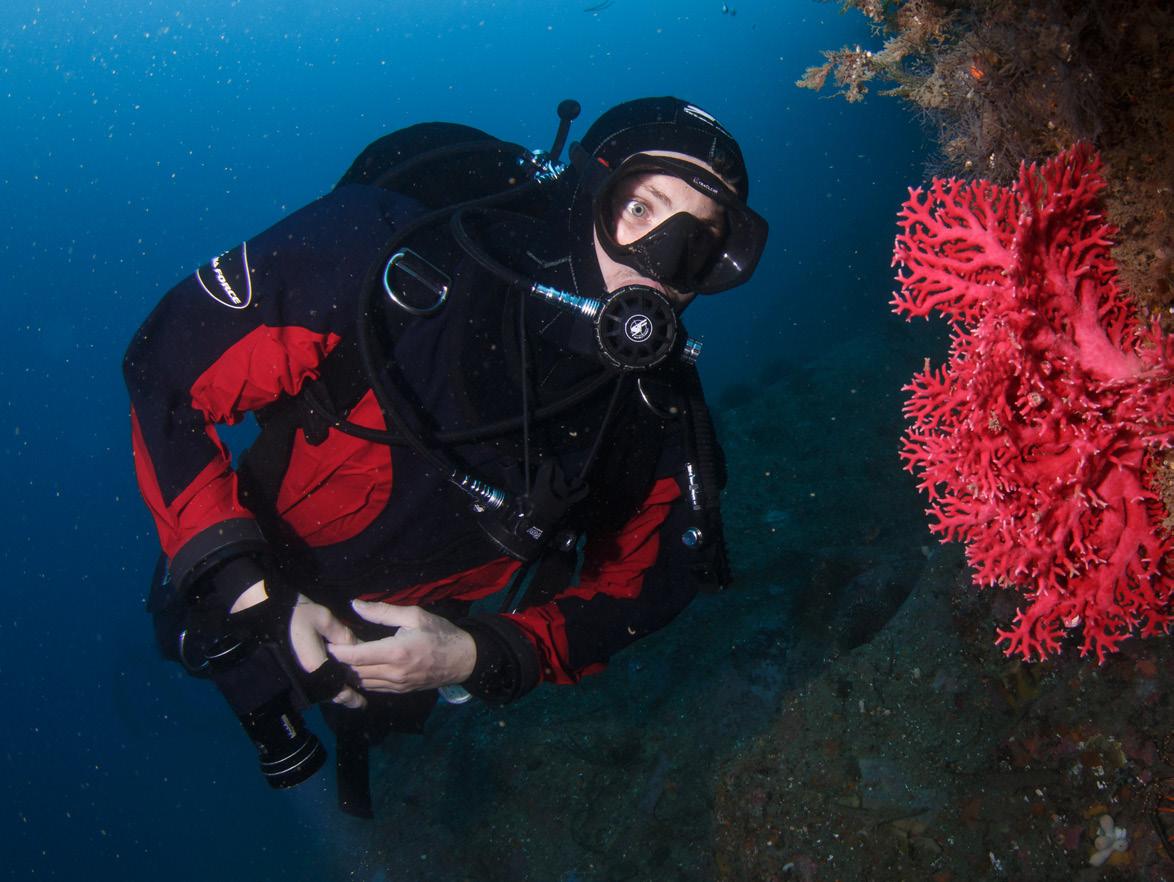
THE MERCURY ISLANDS, COROMANDEL
The Coromandel Peninsula is famed for its islands and soft white sands. Below the water, there are spectacular caves, pinnacles, walls, and drop-offs. The Mercury Islands, northeast of Opito Bay, have dive sites for all experience levels and host numerous fish species in the shallows and at depth. They also host an array of seasonal visitors, including whales, bronze whaler sharks, makos, stingrays, marlin, and other subtropical species. This is a great dive spot if you want to encounter marine life large and small, then spend your non-diving days lazing on glorious beaches.
THE ALDERMEN ISLANDS, COROMANDEL
Further south, east of Tairua on the Coromandel Peninsula, the Aldermen Islands’ underwater scenery rivals that of the Poor Knights Islands and includes deep walls, honeycomb-like caves, grassy beds, kelp forests, and striking pinnacles. This is a great dive spot for experienced divers, with deep walls dropping to over 35m. There are also some shallower dive sites to enjoy.
LAKE TAUPŌ, WAIKATO
Lake Taupō is unlikely to be the first place you think about for diving, but don’t let that deter you. There are cliff faces and rocky structures that host freshwater crayfish, rainbow and brown trout, and smaller bottom-

dwelling fish. With great visibility, easy access from the lakeside and BBQ facilities at the shoreline, Lake Taupo is a fun dive and snorkelling spot during the Kiwi summer. Don’t forget your wetsuit – it can be a bit chilly!
TAPUTERANGA MARINE RESERVE, WELLINGTON
One of the best things about New Zealand is that you can dive or snorkel in the middle of nowhere or right next to our gorgeous cities. Wellington’s rugged coastline and protected harbours host a wealth of life, meaning there is somewhere to go diving no matter the weather. The Taputeranga Marine Reserve is one of the most popular dive and snorkel spots around Wellington and is a must for families. It has an excellent snorkelling trail and easy shallow shore dives among anemone-covered rocks and kelp beds. Look closely for octopuses and conger eels, and don’t be surprised if you are followed around by curious blue cod.
MILFORD SOUND, FIORDLAND
Last but by no means least, the very bottom of New Zealand has some bracing but unmissable dives. Because of the high rainfall and tannin-stained runoff in Fiordland, there is a layer of dark freshwater on the surface of these moody-looking fiords. This has allowed light-sensitive species, normally only found at much greater depths, to flourish in the shallows. Milford Sound is the most accessible place to go diving in Fiordland and has dramatic cliffs that plunge into the dark waters. There are numerous black corals in the shallows, plus red corals, crayfish, diverse fish life, eagle rays, stingrays, and – occasionally – passing great white sharks. At the end of your dive, you will surface among the most magical scenery imaginable. If you are an adventurous water lover, this is New Zealand diving at its finest.
Red coral in Piopiotahi Milford Sound Marine Reserve. Grant Thomas, Descend Diving
53 Summer 2022 |
The Gemstone Bay snorkel trail is easily accessed from the shore at Cathedral Cove, Coromandel. Matt Crawford
the skills needed to properly prepare specimens were as rare as hen’s teeth.
Thomas Cheeseman, the renowned New Zealand botanist, was the curator (director) of Auckland Museum at the time. He needed to fill his new exhibition galleries with objects that would educate and delight the visiting public.
His staffing priority, besides the caretaker-janitor, was for a taxidermistpreparator, who could transform dead birds and fish into stable specimens for public display.
After a benefactor donated £25, and two evening fundraisers garnered more than £60, the museum was in a position to employ a young Austrian naturalist and collector called Andreas Reischek as its first resident taxidermist.
Reischek, who arrived in New Zealand in 1877, spent 12 years studying New Zealand’s flora and fauna, amassing a vast collection of 14,000 specimens. He financed his collecting expeditions by periods of work as a taxidermist and by supplying specimens to private collectors. His work was always highly praised.

Reischek only stayed at Auckland Museum for part of 1880–81, forcing Cheeseman to seek a replacement. He asked Henry Ward, an American “naturalist,
NO BONES ABOUT IT
Auckland Museum’s early attempts to display mounted birds for public education and enjoyment had a shaky start beset by poor funding and personal tragedy. Brian Gill
In conservation, we try to ensure long lives for our native animals and healthy populations. But when animals die, museums can salvage the bodies and pursue a parallel “mission” – to conserve specimens as a permanent and verifiable record of our biodiversity.
Research on museum specimens then yields important information to support conservation, making natural history museums allies in the national conservation effort.
Preserving feathered birds for museums requires the specialised skill of taxidermy, while extracting bones and articulating skeletons requires a skilled “preparator”.
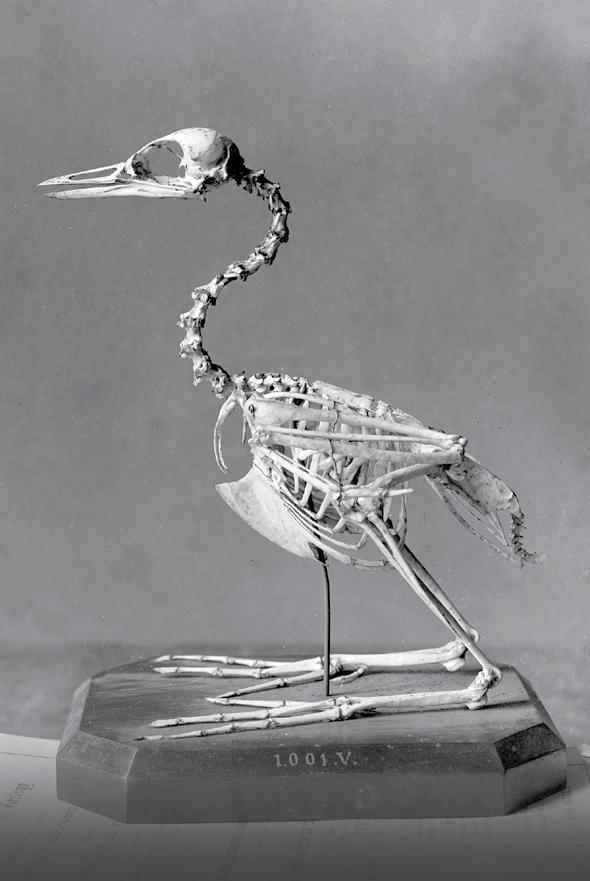
In 1876, when Auckland’s first purpose-built museum opened in Princes Street, near Emily Place, people with
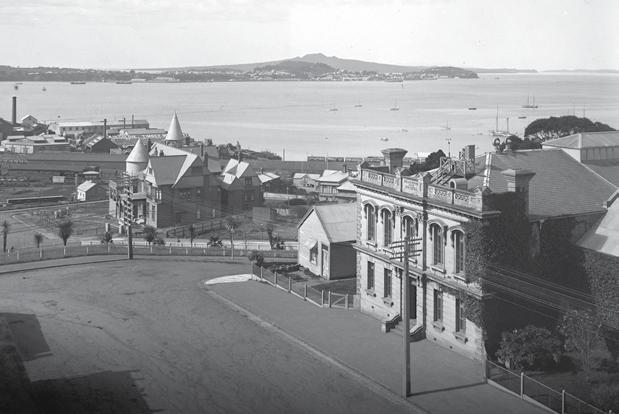
collector, and purveyor of curiosities”, who was visiting Auckland in 1881, for help.
The American had established Ward’s Natural Science Establishment in Rochester, New York, in 1862 to house his stock so he could trade natural history specimens to museums and universities around the world.
The company was so big it trained its own specialists, and Ward could put Cheeseman in touch with young trained preparators keen to work in farflung places such as New Zealand.
HISTORY
Thomas Cheeseman circa 1910. Photographer unknown. Alexander Turnbull Library
Skeleton of a New Zealand dabchick Poliocephalus rufopectus (circa 1900), probably prepared by Charles Adams. Auckland Museum
Auckland Museum, in Princes Street, 1902. Devonport and Rangitoto Island are in the far distance. H. Winkelmann, Grey Special Collections, Auckland Libraries
| Forest & Bird Te Reo o te Taiao 54
Correspondence between Ward and Cheeseman shows the first preparator sent by Ward was the Belgian Charles De Kempeneer, who had seven years’ work experience at Ward’s establishment.
De Kempeneer started at Auckland Museum in July 1882, but the museum could only afford to pay him for three months. He then moved on to new employment in Sydney.

The birds he prepared are unknown, but the New Zealand Herald reported he mounted for display the skeleton of a spectacular large African python the museum had obtained from a French museum. He also prepared a Northland swordfish nearly 4m long.
In April 1883, a successful Auckland businessman called Edward Costley died, and his considerable wealth – about $20m in today’s money – was donated equally among seven public and charitable institutions, including Auckland Museum.
The £12,150 Costley bequest changed Auckland Museum’s financial position, allowing Cheeseman to woo De Kempeneer back from Australia.
The Belgian felt Auckland was more expensive than Sydney and lacked “amusements”. But, finding the Australian city too hot, he accepted a position back in New Zealand with a starting date of 1 May 1884.
However, De Kempeneer’s last letter to Cheeseman, in February 1884, was short and ominous. He reported that he had felt poorly over the past few weeks, but “I think that a change of air will do me good.”
De Kempeneer left Sydney to see something of other Australasian cities. His ship eventually reached Dunedin, where he was taken ill. He continued his passage to Auckland but got rapidly worse, and when the steamer arrived he was nearly comatose.
The steward took him up to Auckland Hospital, and a message was sent to Cheeseman. Unfortunately, by the time he received it, Charles De Kempeneer had died overnight on 8 April 1884 from acute nephritis. He was only 32 years old.
Cheeseman wrote to Ward: “Poor fellow – I have felt very sorry for him, dying alone and among strangers.” He later corresponded with De Kempeneer’s father, an attaché in the Belgian Interior Ministry, who thanked him “… for the effort that you have given us in attending to the funeral of our missed Charles, in making sure that all went properly”.
Ward recommended another taxidermist for Auckland Museum, this time the American Charles Francis Adams. He left Illinois by train for San
Francisco in December 1884 and crossed to Auckland on the ship Zealandia, a journey in which he was “taken miserably sick” with seasickness.
Adams set up a workshop in the museum’s basement and began preparing birds, fish, reptiles, and marine invertebrates for the museum collection. He travelled around the Auckland area and made field trips to Cuvier Island, where he saw tīeke saddlebacks, before visiting Karewa Island for its tuatara.
There were foreign birds to mount that the museum had received on exchange as roughed-out skins. Adams obtained New Zealand birds in various ways, including ducks that he bought in the market during the shooting season and a kiwi that was killed by a dog.
His specimens of New Zealand birds were widely dispersed because Cheeseman used many of Adams’ study-skins in exchanges with museums abroad.
Adams’ abilities enabled Auckland Museum to go beyond displaying individual stuffed animals in rows on shelves and create its first “habitat groups” or dioramas in 1886.
These displayed animals in naturalistic modelled surroundings and were achieved within 10 years of the first such exhibits in the world-leading British and US museums.
One case showed kea at the carcass of a dead lamb, a second featured tuatara at the entrances of shearwater burrows. These small exhibits dealt with unusual biological interactions that fascinated the public.
Adams worked at Auckland Museum until February 1887, when he left to collect mammals and birds in southeast Asia. He returned to the United States in 1888 but died five years later of meningitis or encephalitis, aged 36.

Knowledge of De Kempeneer and Adams and their contribution to New Zealand natural history had been lost until 2000–15, when I discovered letters and other documents archived in libraries in New Zealand and the United States. This enabled their stories to be recovered and shared with nature lovers across Aotearoa today, more than 140 years later.
Brian Gill is a former Curator of Land Vertebrates at Auckland War Memorial Museum. For more of his natural science stories, see The Owl that Fell from the Sky: Stories of a Museum Curator and The Unburnt Egg: More Stories of a Museum Curator at www. awapress.com.
Charles Adams (early 1880s). University of Illinois Archives
Charles De Kempeneer around 1880.
Rush Rhees Library, University of Rochester
55 Summer 2022 |
CRITICALS COLLECTION
New Zealand artists have partnered with BirdLife International to help prevent avian extinctions around the world.
Our friends at Metalbird recently created the Criticals Collection, five new artworks depicting globally endangered birds, to help raise money for BirdLife International.
Thoughtfully designed and personalised by their artists, 30% of proceeds from the limited-edition artworks is being donated to BirdLife’s global conservation work.
At the time of writing, two of the five species featured had sold out, including New Zealand’s very own kakī black stilt, which has a population of just 170 adult birds.

In the 1980s, Forest & Bird’s South Canterbury Branch helped save the species by funding research and controlling introduced predators in the Mackenzie Basin, where the last wild birds live.

“We are delighted to support BirdLife’s conservation work,” said Metalbird founder Phil
Walters. “For these five species, the line between endangerment and extinction is paper thin, and funding is urgently needed.
“Some of these birds have chillingly small populations of between 80 and 250 worldwide, so our Criticals Collection will release only 300 of each bird, making them rare and unique objects.”
The Criticals Collection also includes India’s lesser florican, total population 500, which has extraordinary black ribbon-like feathers on its head that twirl and bounce during its strutting courtship dance.
The Balearic shearwater is a small brown seabird that glides along the water surface, skimming the peaks and troughs of the waves. This species is in danger of imminent extinction from cats, rats, and being accidentally caught on fishing lines.
The ivory-billed woodpecker lives in the dense hardwood forests of Southern USA and Cuba. Some believed it extinct, as a result of hunting and habitat destruction. But there is mounting evidence suggesting it remains alive somewhere deep in the forest.

The fifth bird in the series, the Philippine eagle, also proved popular, selling out soon after its release.
Metalbird also supports Forest & Bird’s conservation efforts and has generously donated more than $30,000 to help fund our work. Check out its fabulous New Zealand bird collection, which is available from our online shop at https://shop.forestandbird.org. nz. Last orders for Christmas is coming up soon – 9 December 2022.
BIRDLIFE TURNS 100
BirdLife International is a global voice for nature, working with 117 partners around the globe, including Forest & Bird. We are proud to be part of the BirdLife International family and congratulate the team for their 100-year legacy of protecting the natural world. While climate change, habitat destruction, and other human activities are devastating the diversity of life on our planet, there is still hope. Humans may create huge challenges – but with enough support, dedication, and resources, we can also reverse the decline. For more about BirdLife’s work, see https://www.birdlife. org/birdlife10. To see the Criticals Collection, go to https://www.metalbird.co.nz/ pages/birdlife
BIRDLIFE INTERNATIONAL
Kakī black stilt. Metalbird
| Forest & Bird Te Reo o te Taiao 56
The ivory-billed woodpecker is one of five critically endangered birds featured in the BirdLife campaign.
RESTORING THE GREAT SWAMP
A restored urban wetland in Christchurch is doing a great job protecting homes from flooding Jim Brock Trish Brock
Christchurch City Council has been developing several new wetlands to improve water quality and provide flood protection in the southwest of the city.
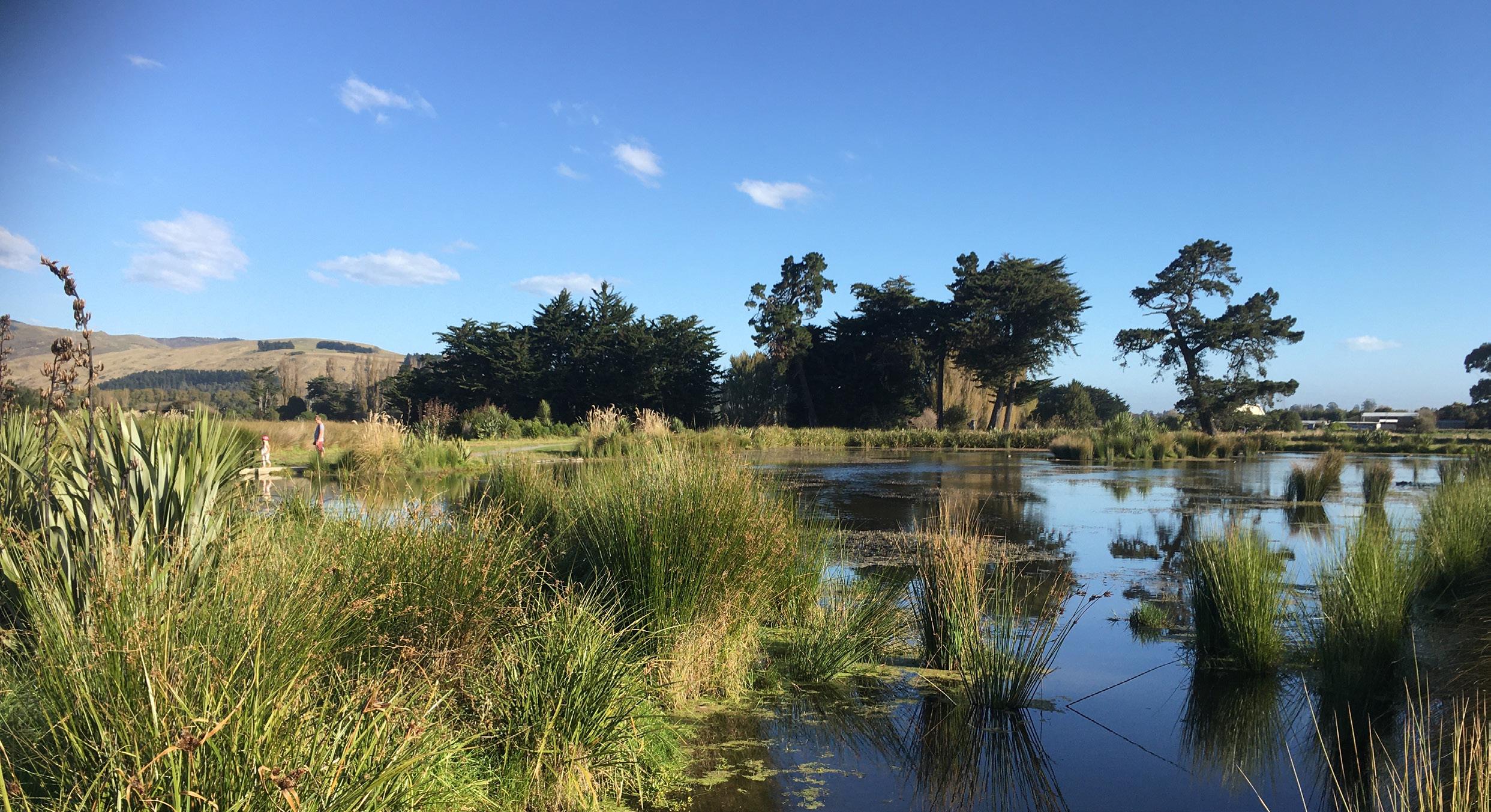
In some cases, including our local Sparks Road wetland, this involves restoring and improving old ones.
Christchurch was once known as “The Great Swamp”, but over the years many wetlands were drained and converted to farmland.
One downside of this was much of the city and its outskirts became prone to flooding in times of heavy rain.
The Sparks Road wetland can be accessed at 270 Sparks Road, Hoon Hay, and it has been designed to act as a giant filter for stormwater draining from new subdivisions across the road.
The idea is to remove as much sediment as possible from the water before it flows via Hendersons Drain into Cashmere Stream and, eventually, the Heathcote River. The wetlands also provide an area where excess water can pool in times of heavy rain to avoid flooding in the local area.
The water first drains into two interconnected ponds near the carpark. It then passes through flow-control weirs before seeping through two low-level wet areas planted in sedges and rushes.
Finally, it reaches a third pond at the lower end of the wetlands. This flows into the Henderson Drain, which eventually meets the Cashmere Stream, the main tributary of the Heathcote River.
The council has laid a light gravel path that encircles the wetland. This is very popular with local people who walk their dogs there or cycle around it. When you drive past, there are often several vehicles in the carpark.
The new wetlands attract a wide variety of birds, including pūkeko, mallard, grey and paradise ducks, Canada geese, shags, welcome swallows, goldfinches, skylarks, and a lone harrier hawk.
In March, my wife Trish was able to photograph a kōtuku wading in the pond nearest to the carpark. We were the only people there on this occasion, and by the time we had completed our walking circuit it was gone.
The ponds have been colonised by large numbers of eels that have entered from the Henderson Drain and swum back up the system.
In a recent survey by the council, 814 eels were netted in one pond using five unbaited nets left overnight. The eels were classified, measured, and returned.
More than 100,000 wetland plants have been planted in the Sparks Road wetland. Since it was opened to the public about two years ago, the flaxes, sedges, and other plants have experienced very healthy growth.
The project appears to have been very successful in a number of ways, and the Council is now working on establishing several other wetlands in the Henderson Basin.
Jim Brock is a Forest & Bird member and retired radio journalist and teacher. He was inspired to write this article after reading our special feature about wetlands in the Autumn issue.
URBAN CONSERVATION
57 Summer 2022 |
Christmas
READS
Kick back and catch up with some of the best nature writing in Aotearoa this summer. Forest & Bird members receive a 20% discount on all of these books, courtesy of our friends at Potton & Burton.
Vanishing Ice
 by Lynley Hargreaves
by Lynley Hargreaves
Enormous rivers of ice once flowed out onto the Canterbury Plains, stretched beyond the current west coast shore of Te Waipounamu South Island, and spread down the slopes of the volcanoes in central Te Ika-a-Māui North Island. These glaciers of past Ice Ages built plains and vast rocky moraines, sculpted fiords and valleys, and carved out deep lakes. This book tells the stories of our glaciers though the lens of human interaction, from the first Māori discoverers to colonial explorers, mountaineers, and modern glaciologists. It also provides a fascinating insight into the way New Zealand’s glaciers work and why they are disappearing. ($59.99, Potton & Burton)
Seeking the Light by Gavin Lang

This is the story of climbing New Zealand’s 24 highest mountains, those peaks in the Kā Tiritiri o te Moana Southern Alps that rise above 3000m. Written by Wānakabased mountain guide and adventure photographer Gavin Lang, the account of each climb is illustrated with his breathtaking imagery. Inspiring and exhilarating, each story captures the tension and drama of mountaineering in Aotearoa and is vividly brought to life with Gavin’s outstanding photography. Seeking the Light is a beautiful and original contribution to our mountain literature, a must-read for anyone with a love for wild high places. ($89.99, Potton & Burton)
Bushline: A memoir by Robbie Burton

In his long career at the helm of Potton & Burton, one of New Zealand’s largest independent publishers, Robbie Burton has published many significant books about the outdoors and our natural history. Bushline is a blend of reflection about the backcountry and the people who inhabit it, the authors who write about it, and the books they have produced, as well as an inside view into independent publishing in Aotearoa. Ultimately, though, it is a book about belonging, and how a life has been shaped by the power and beauty of the New Zealand landscape. ($39.99, Potton & Burton)
Rakiura by Rob Brown

An exquisite photographic book that celebrates the wild landscapes of Rakiura Stewart Island, a wilderness that has been increasingly cherished by New Zealanders in recent years. This inspired the revising of Rakiura, the work of leading photographer Rob Brown, which was first published in 2006. Critically acclaimed at the time, his original large-format photographs remain as powerful as ever, while more recent photographs have also been added. These include images of the remote granite peaks around the southern harbour of Port Pegasus, the huge sweep of sand dunes behind Mason Bay, the cliffs and islands of the rugged coast, and interior vistas of the island’s primeval podocarp and windswept mānuka forest. ($64.99, Potton & Burton)

GRAB YOUR 20% DISCOUNT
You can buy any of the books featured here with a generous discount just for Forest & Bird members. To receive a 20% discount from the $RRP, hop onto www.pottonandburton.co.nz and use the code FOREST23 at checkout. Offer closes 28 February 2023.
20% READER DISCOUNT
| Forest & Bird Te Reo o te Taiao 58
The New Zealand Seashore Guide by Sally Carson and Rod Morris
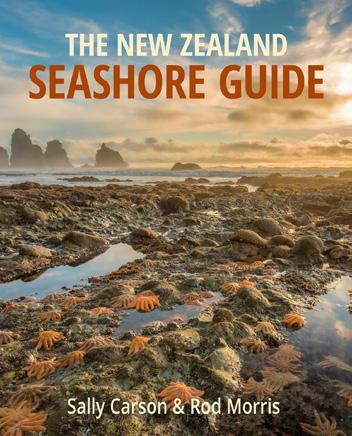

This is the ultimate guide to the diversity and stunning beauty of seashore life in Aotearoa. Originally published in a smaller format in 2017, this new edition has increased in size to show off Rod Morris’s superb photography, and to make identification easier. Sally Carson’s text is packed with information on endemic and introduced species, including sponges, anemones, sea stars, shrimps and crabs, barnacles, pāua, mussels, oysters, fish, and seaweed. This is the most up-to-date and comprehensive guide available to this country’s seashore, an essential purchase for any New Zealander who appreciates our unique coastal environment. ($49.99, Potton & Burton)
Home is an Island by Neville Peat
Join award-winning author Neville Peat on a unique journey through the islands that contribute to the character of Aotearoa New Zealand. This book includes Rakiura Stewart Island, Anchor Island in Tamatea Dusky Sound, Kāpiti Island, and Tiritiri Matangi in the Hauraki Gulf. Further afield, it also covers Ross Island in Antarctica, Enderby Island in the sub-Antarctic Auckland Islands, the Chatham Islands, and the New Zealand dependency of Tokelau. Part memoir, part adventure travel, history, and nature conservation, Home is an Island invites us to view the global challenges of our age in new ways, with new insights. ($39.99, Potton & Burton)
Double Take

by Craig Potton
The latest book from leading New Zealand landscape photographer and Forest & Bird ambassador Craig Potton. Since he started taking photographs, Craig has often been inspired to take two images of the same scene with only a slight shift in the camera. These end up being very similar in composition, often presenting him with the question of what is the better photo. Double Take addresses this dilemma by presenting these near identical twins side by side. Mostly middle-distant forest interiors, these complex, immersive photographs invite the viewer to look again to find subtle visual echoes and appreciate the natural world unfolding in a new light. ($79.99, Potton & Burton)
FOR YOUNG ’UNS
Tiaki by Jean Donaldson

This book is a beautiful tribute to New Zealand’s lesser-known endangered species. They don’t regularly make the news but are just as important as “stars” like kākāpō, for they are the foundation of our biodiversity. Some of the weird and wonderful creatures featured include the Smeagol gravel maggot, moko kākāriki, a gecko with a bright blue mouth, the kōwaro Canterbury mudfish, which can survive out of water for up to several months, and the tiny, critically endangered pekapeka tou roa longtailed bat. Written and illustrated by Jean Donaldson, this highly original and inspiring book is aimed at intermediate-age children and teenagers. ($29.99, Potton & Burton)
Where is it in Town?
By Ned Barraud
Take your children on a wildlife hunt this summer with this fascinating “look and find” book by an award-winning writer and illustrator. Focusing on creatures that Kiwi kids might encounter in town, each page illustrates a different urban environment. We visit a day and night-time garden, botanic gardens, a creek, and the ocean under a wharf. What might you find on the long grass or in the trees, in a nature reserve, in a garden shed, or on the edge of town? This is a wonderfully interactive way to teach younger children about New Zealand’s natural world, with stunning illustrations to enhance their learning. ($21.99, Potton & Burton)

Wild Coasts by Ned Barraud
A fascinating exploration of some of Aotearoa’s 44 marine reserves. Our country is renowned for its big blue backyard, but, after decades of overfishing, many ocean ecosystems are under threat. This book explores six spectacular marine reserves: Goat Island and the Poor Knights Islands, in Northland, Taputeranga on the south coast of Wellington, Hikurangi, at Kaikōura, Piopiotahi Milford Sound, in Fiordland, and Ulva Island, at Rakiura Stewart Island. Full of fascinating information and wonderful illustrations, Wild Coasts is an inspiring tribute to all of our marine reserves. It will be treasured by all young people who are interested in the beach and ocean. ($21.99, Potton & Burton)

59 Summer 2022 |
CHEERS TO CONSERVATION!
Spy Valley Wines is restoring a local wetland as part of its sustainable winemaking mission. Gretchen Carroll
Afamily-run Marlborough winery is restoring a wetland on one of its five vineyards, returning native birds and plants to the area.

Spy Valley Winery bought the 3ha wetland next to the Wairau River, in the Waihopai Valley, 10 years ago. The previous owners had started restoring this Significant Natural Area, but it had been taken over by weeds.
Viticulturist Adam McCone, who manages the vineyards, has also been overseeing the wetland project, starting by cutting the weeds away and discovering rare kahikatea and other native plants.

“Restoring this wetland is something we are passionate about and something we can contribute to in our little corner of the world,” he said.
“It took two years to get it under control, then the native plants started to grow, which was fantastic.”
The Spy Valley team planted kahikatea, tōtara, coprosmas, karamū, pittosporums, ribbonwoods, harakeke flax, kānuka, and mānuka. They also dug in carex around the water edges and laid pest traps. Birdlife has boomed.
“Tūī have come back when the flax is flowering, we have lots of pūkeko, and occasionally we’re seeing kererū and weka,” added Adam.
Last summer, the team created a walking track for family and friends to enjoy the wetlands and hope to eventually open it to the public.
Spy Valley was one of Marlborough’s first wineries to be certified “Sustainable” under the New Zealand Winegrowers Sustainability Programme.
Since 1999, it has been accredited under the New Zealand Sustainable Winegrowing scheme, which promotes economically and environmentally sustainable vineyard management.
Adam has been with the company for more than 20
years. In that time, he says it has dramatically reduced herbicide and water use, and successfully built up organic matter on the soil.
“We’ve done a lot of work on getting the vine roots down deeper, so they’re not competing with weeds, and allowing grasses and other voluntary species to grow under the vines,” he said.
The weeds and grass are now left to act as a mulch, becoming a buffer following heavy rain, absorbing some of the water and preventing fruit splitting. Sheep graze around the vines in winter, keeping the grass short and the soil fertilised.
Adam says the vineyard doesn’t feel as sterile and dusty as it used to in summer, and the vines have become more resilient to stressful climate situations.
Spy Valley has moved to lighter, recycled glass bottles as they use less energy to ship. It installed solar panels to power their refrigeration unit, LED sensor lights in low foot traffic areas, and a nitrogen generator to remove the need to truck in the bottled nitrogen needed for winemaking.
After restoring its spring-fed wetland, Spy Valley is on a mission to help nature thrive beyond its backyard. Since partnering with Forest & Bird in 2020, they’ve released more than 30,000 bottles featuring a special edition label on both Satellite Sauvignon Blanc and Satellite Pinot Noir, using the bottles as a platform to raise awareness for Forest & Bird within New Zealand. Spy Valley also supports Forest & Bird’s conservation work by contributing $12,000 annually to the organisation, to help to give nature a voice.
For more information, see https://spyvalleywine.co.nz.
OUR PARTNERS
Adam McCone
| Forest & Bird Te Reo o te Taiao 60
The restored wetland is located in Spy Valley’s “H” vineyard next to the Wairau River. Supplied
KARAMEA CALLING
Forest & Bird’s Top of the South regional conservation manager Scott Burnett recently visited Karamea, the northernmost community on the West Coast, and learned of the challenges facing the local community following the closure of the Heaphy Track.
The 147m Heaphy River Bridge was destroyed by storms in February 2022 and has to be re-sited. This may not be completed till the second half of 2023.
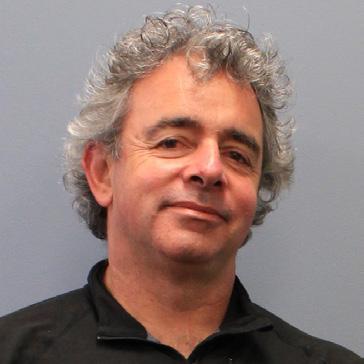
The closure of the Heaphy track has led to a 90% drop in accommodation bookings, but Scott says there has never been a better time to visit this stunning part of the country.

Visitor numbers are low, and travelling there will benefit this special community’s struggling local economy.
There are good tramping options at either end of the
Heaphy Track, including an overnight tramp to Heaphy Hut. It is situated on the coast at the Heaphy River mouth, five hours tramping along the spectacular coastal section of the track.
Another natural highlight close to Karamea is the incredible Ōpārara Arches, which has had some recent upgrades to improve visitor access, including new hand-built walking tracks.

Whio numbers in the Oparara Basin have increased by 300% thanks to intensive predator control, and you should easily be able to see these shy birds while visiting.
For more info on the status of the Heaphy Track, go to https://www.doc.govt.nz/our-work/heaphytrack-recovery-work/. Find out more about Oparara at https://www.doc.govt.nz/our-work/opararainvestment/
COMMUNITY
Scott Burnett
Ōpārara Arches.
Neil Silverwood
5 DAY TOUR 28th Nov 2022 • 13th Mar 2023

Pelagic bird tour QEII covenant visits Māori history CONTACT 0800 708 844 Think Carbon, Support Local Pick your tour www.driftwoodecotours.co.nz

• Heaphy Track
• Abel Tasman
• Old Ghost Road
‘Carry less, enjoy more’
Come explore with us! www.kahurangiwalks.co.nz Phone:

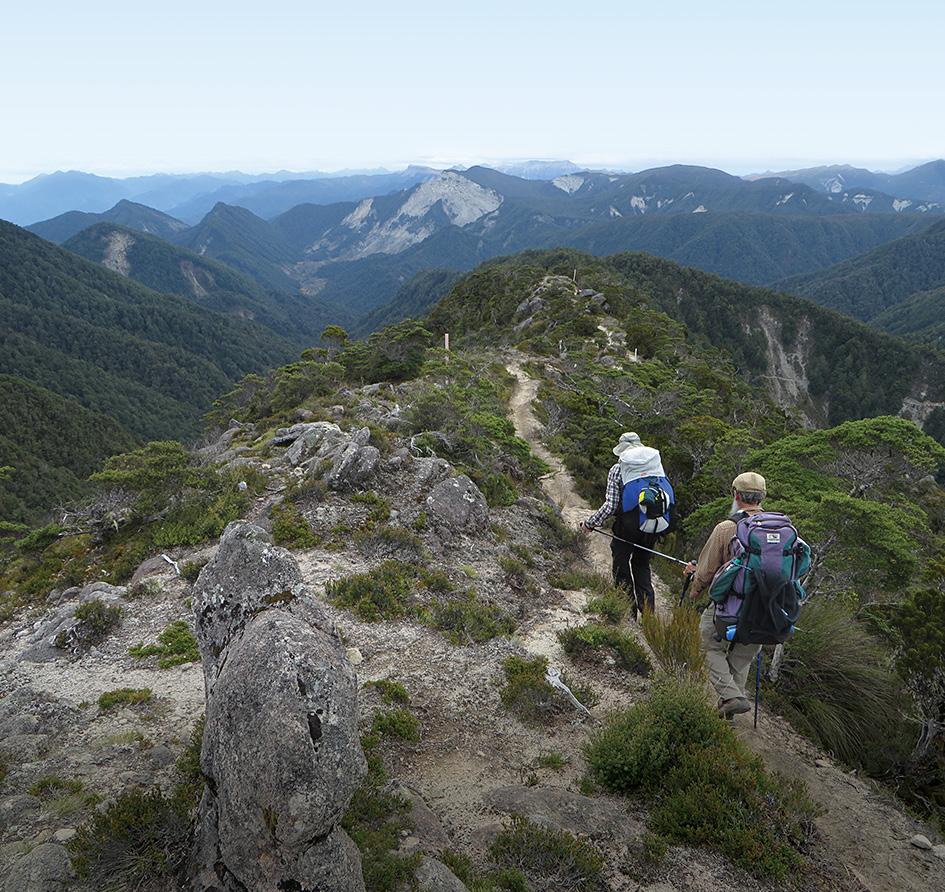
PHONE 07 859 2943 MOBILE 021 270 5896 PO Box 4385 Hamilton 3247 WEB: www.philproof.co.nz EMAIL: philproof@gmail.com
FOREST & BIRD’S WILDLIFE LODGES
Arethusa Lodge

Near Pukenui, Northland Sleeps 6 herbit@xtra.co.nz 03 219 1337
Ruapehu Lodge Whakapapa Village, Tongariro National Park Sleeps 32 office@forestandbird.org.nz 04 385 7374
Mangarākau Swamp Lodge North-west Nelson Sleeps 10 mangarakauswamp@gmail.com 03 524 8266 http://www.mangarakauswamp.com
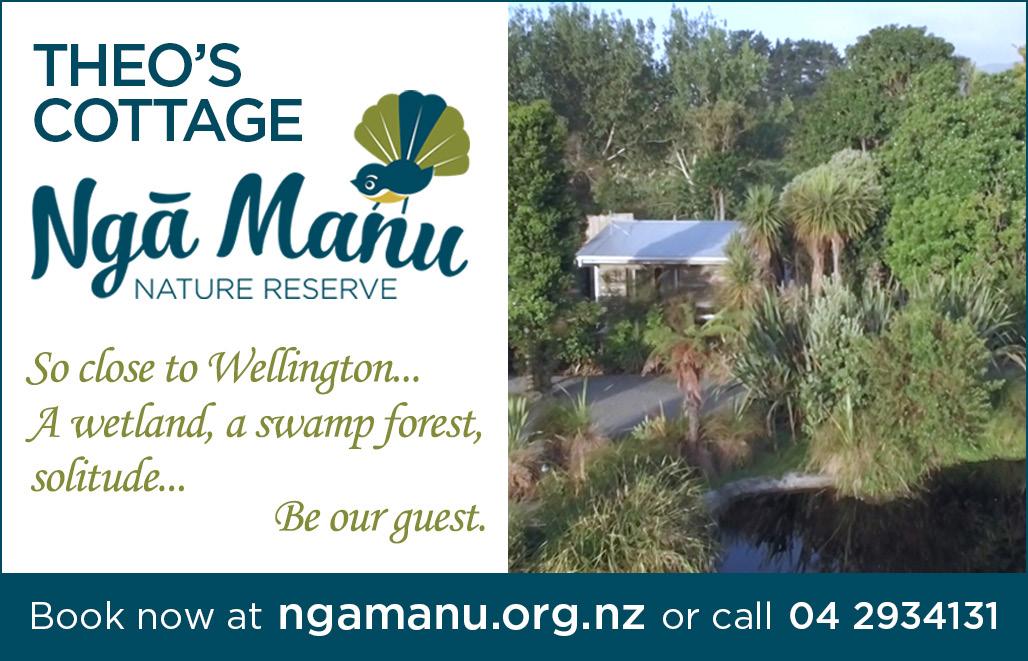
Forest & Bird members can book all of these lodges at reasonable rates. Join today and feel good knowing you are making a difference for New Zealand’s nature. See www.forestandbird.org.nz/joinus
Tai Haruru Lodge
Piha, West Auckland Sleeps 5+4 hop0018@slingshot.co.nz 09 812 8064
Tautuku Forest Cabins Owaka, Otago Sleeps 16 tautukucabins@gmail.com 0273764120
PEST CONTROL PRODUCTS
OUT: Possums, Rodents, Mustelids, Rabbits
PHILPROOF
WIPE
Standard & Mini Possum Bait Stations & Timms Traps • Rodent Bait Stations and Block Baits • Rodent Snap Traps • Fenn Traps (MK4 & 6) • Trap Covers • DOC 200 trap and lightweight cover. Also available: Monitoring Tunnels, Flagging Tape, Rabbit Bait Stations.
MARKET PLACE
• Cobb Valley | Forest & Bird Te Reo o te Taiao 62
03 3914120
KAIKŌURA
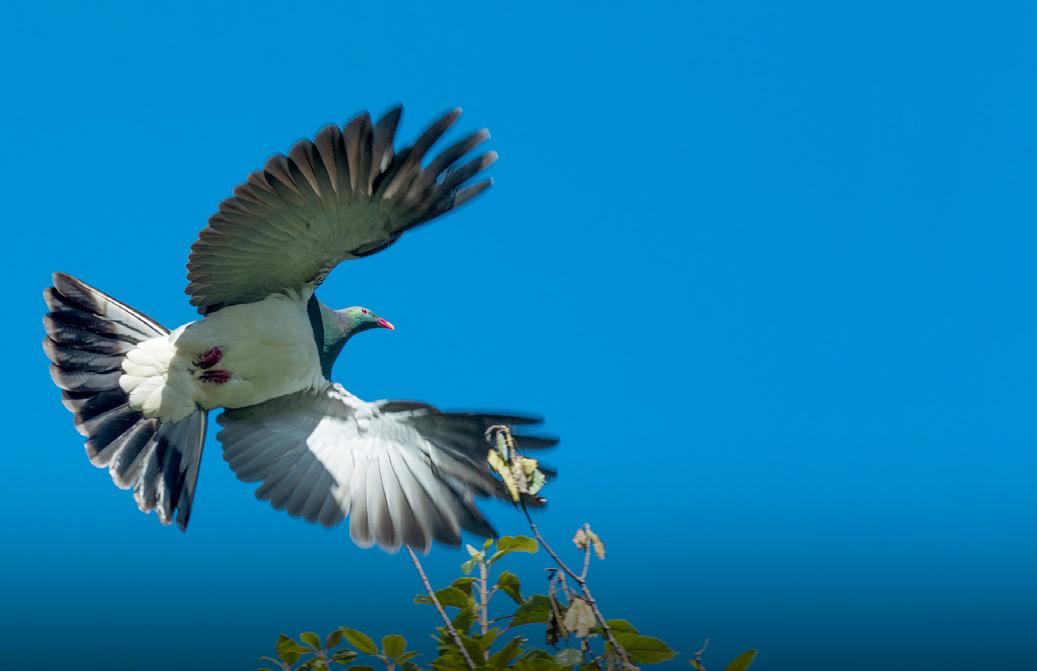











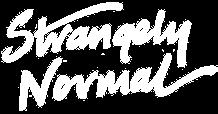



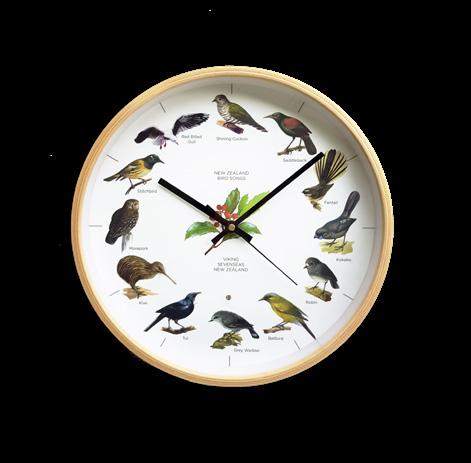



Advertise to Forest & Bird readers here Please contact Karen Condon PHONE 0275 420 338 EMAIL karen.condon@xtra.co.nz and reach 80,000 people who are passionate about nature and the outdoors. 63 Summer 2022 | 0800 925 586 www.glaciervalley.co.nz Join our knowledgeable local guides on walking tours in the stunning Glacier Country region. Learn about glaciology, flora & fauna, geomorphology, geology & history of this world renowned landscape. We cater for all ages & abilities, with 2 hr, half day & full day tours in our small groups, at your pace. Phone Steve to organise your tour +64 27 419 1080 auldwood@outlook.com https://www.facebook.com/Freerange.B1rding www.auldwoodbirds.kiwi Canterbury’s Free-Range Bird Guide Explore with us at Okarito Boat EcoTours and discover the magic of the superb birdlife and untouched serenity of New Zealand’s largest unmodified wetland, over 3000 hectares of lagoons and wildlife-rich waterways. 03-753 4223 OkaritoBoatTours@gmail.com www.okaritoboattours.co.nz BIRDLIFE RANGE MADE IN NZ MENSWEAR 19 O’Connell St, Ak CBD ph: 64 9 309 0600 strangelynormal.com A different birdsong every hour vikingsevenseas.co.nz New Zealand Birdsong Clock $149.95 ONLY Stunning new design Paheke Historic Bed & Breakfast Ohaeawai, Bay of Islands Experience a restful stay in luxury accommodation with historic charm, surrounded by peaceful gardens. Promo code for Forest & Bird members FrstBrd_SMR22 Only available via our website www.paheke.co.nz | 09 405 9623
COUNTING THE LOCALS
Bach owners, a bank trust, and a conservation charity are working together to protect flora and fauna in Canterbury’s Cass Valley. Tony Field
Over the last four years, New Zealand Conservation Trust volunteers have been laying predator traps in the Cass Valley, at the northern end of the Craigieburn Range.
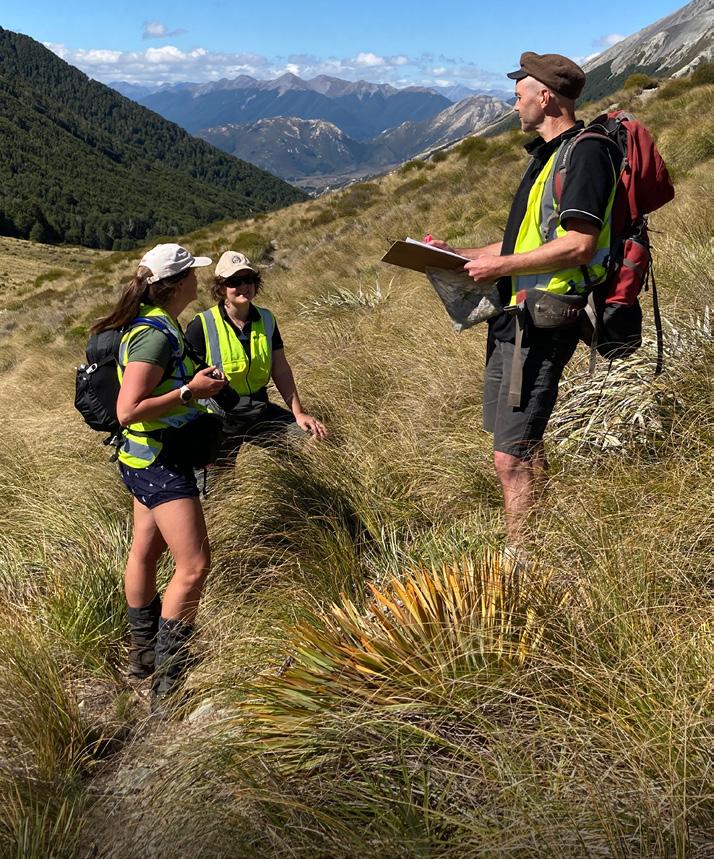
The valley is home to a wide range of native birds, lizards, invertebrates (including dragonflies and butterflies), and indigenous plant species.

The traps are monitored by local volunteers, including people who own baches next to Grasmere Lodge.
Checking the traps can take five to six hours walking, although there are trap lines around Castle Hill Village that can be done in an hour or two.
is more birdlife, including kererū, in the Cass Valley than there was a few years ago, especially around the lodge.
The Wildlands survey results will be used as a comparison for future counts, to give an indication of the effects the trapping programme is having.
“We’re hopefully picking off the pests and predators, including rats, mice, stoats, and weasels, and helping native fauna do well,” says John Forrester, a trust volunteer.
“It’s incredibly rewarding. I love being outdoors, it’s a great day out, and you do feel like you are contributing.”
The New Zealand Conservation Trust’s mission is to protect and advocate for native species through conservation, education, and collaboration.
“We spread the word about conservation, the importance of protecting our native species, and the importance of predator control,” says Janet Hellyer, the Trust’s Resource and Education Coordinator.
in Christchurch.
More than 500 chicks have been cared for here, and schools and community groups can visit to learn about our nation’s most famous bird.
David Bricklebank, chair of the ANZ Staff Foundation Advisory Board, says: “The Trust and the volunteers are working hard to increase biodiversity and control predators.
“The survey will provide an invaluable guide to where they are now and where they are going.”
The Trust hopes its work will also inspire people to take action in their own backyards.
“Everybody can play a part, no matter how small or how large, in protecting our environment,” adds Janet.
“You can make a rock garden for skinks or put a bell on your cat so it doesn’t catch those skinks.”

The project received a recent boost from the ANZ Staff Foundation, which donated nearly $15,000 for a nature survey to be carried out by Wildland Consultants.
They found a large number of birds in the valley, including kea, which prompted the volunteers to add more traps.
Anecdotal reports suggest there
“Our goal is to contribute towards New Zealand becoming predator free by 2050.”
The Trust also has trapping programmes in Carlyle Valley, in Craigieburn Forest Park, and along the Styx River. Recently, their volunteers have been catching more than 500 pests each year.
The Trust is a member of the Kiwi Recovery Programme, with its purpose-built kiwi breeding centre at Willowbank Wildlife Reserve,
LAST WORD
Wildlands ecologists in the Cass Valley. Des Smith
Canterbury grass skink.
Samantha King
| Forest & Bird Te Reo o te Taiao 64
Copper butterfly in the Cass Valley. Wildlands Consultants
Parting shot
The pūweto or spotless crake is very secretive and rarely seen. About half the size of a European blackbird, this dark-coloured rail with bright red eyes lives in freshwater wetlands throughout the North Island and much of South Island. Anna Sephton managed to grab this wonderful shot at an urban park, the Waiatarua Reserve, in Auckland. It was the first time she had spotted this cryptic crake, and she manged to get just one clear shot before it disappeared back into the bushes. Waiatarua Reserve is also home to pāteke brown teal, pārera grey duck, and weweia dabchicks.
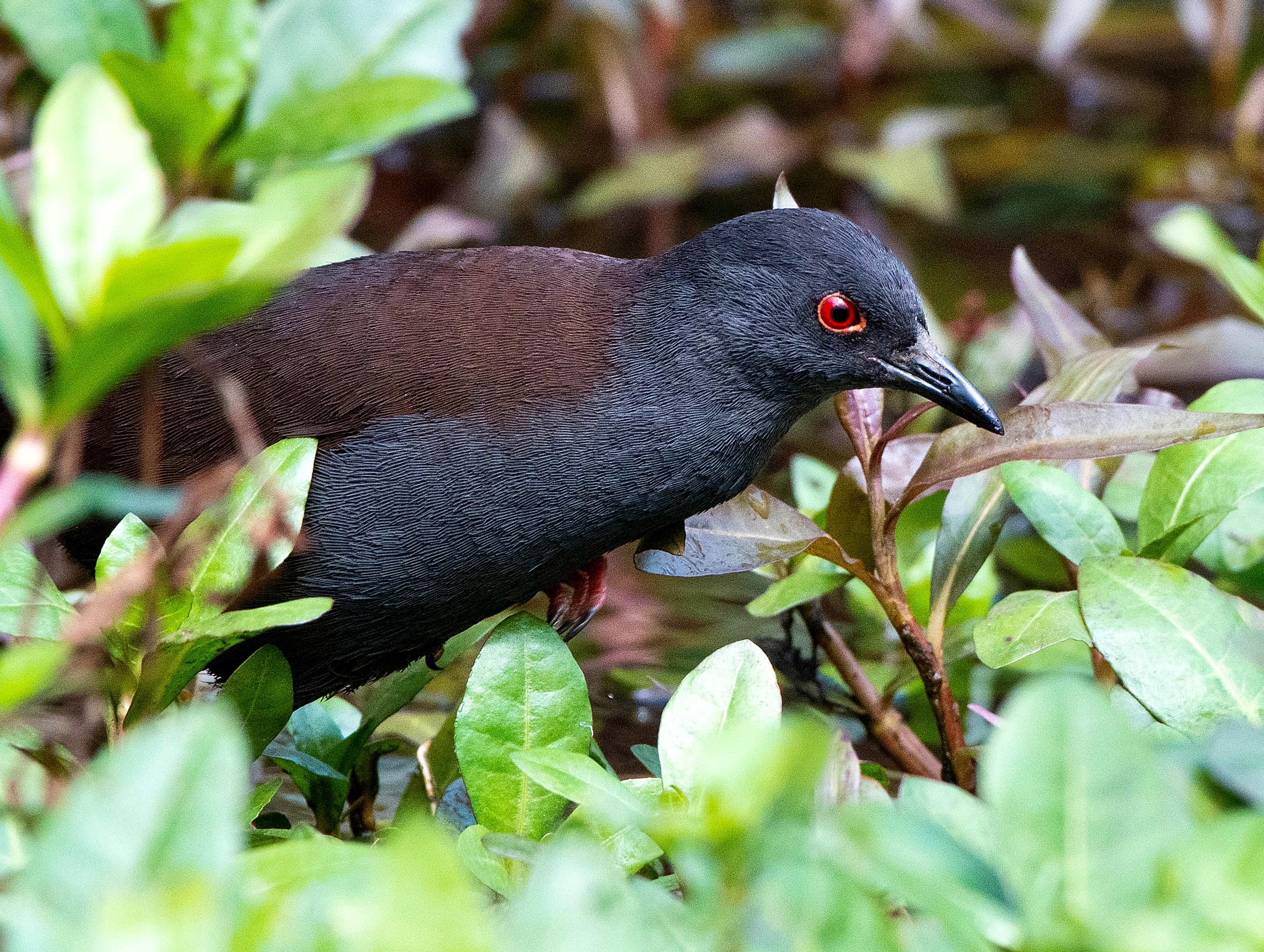
WILD ABOUT NATURE | PHOTO COMPETITION

How to enter: Share your images of native birds, trees, flowers, insects, lizards, marine animals, or natural landscapes, and be in to win. Send your high-res digital file and brief details about your photo to Caroline Wood at editor@forestandbird. org.nz. The best entry will be published in the next issue of Forest & Bird magazine.
The prize: The next winner will receive this limited edition Hannah Shand fine art print Inquisitive Robin (A3, size RRP $220). Hannah’s new artwork features a friendly little kakaruwai South Island robin that will follow trampers along a track chasing the insects they kick up along the way. Each of Hannah’s meticulous pen-andink artworks takes four to 16 weeks to create. The reference photo for this curious robin was taken at Piano Flat, Waikaia Forest, in Southland.
Inquisitive Robin by Hannah Shand. For more of Hannah’s artworks, see www.hannahshandart.com.
 Anna Sephton
Anna Sephton
Whether it’s a day trip with the family or a multi-day adventure deep into the wilderness, Bivouac has the best gear, from the top brands, to keep you safe, comfortable, warm and dry. Our friendly staff are happy to provide expert advice, ensuring you get the right equipment and the right fit. If you need it for tramping, we have it, because at Bivouac Outdoor we ARE tramping.

we ARE tramping
Adelaide Tarn
Kahurangi National Park
STORES
Photo: Mark Watson
www.bivouac.co.nz
NATIONWIDE
Supporting Aotearoa's Backcountry Heritage




































 TOP OF THE ROCKS: Bird of the Year 2022 winner pīwauwau rock wren is king of the Southern Alps.
Craig McKenzie
TOP OF THE ROCKS: Bird of the Year 2022 winner pīwauwau rock wren is king of the Southern Alps.
Craig McKenzie































 Brad Windust
Brad Windust























 Roger Hall
Roger Hall












 hatching process takes approximately five days.
hatching process takes approximately five days.













































 Beccy Ganley
Myrtle rust on a swamp maire leaf. If you see myrtle rust in your garden or while tramping, please report on iNaturalist NZ https://inaturalist.nz
The critically endangered endemic swamp maire is one of three native species most at risk from myrtle rust. Pat Enright/iNaturalist
Beccy Ganley
Myrtle rust on a swamp maire leaf. If you see myrtle rust in your garden or while tramping, please report on iNaturalist NZ https://inaturalist.nz
The critically endangered endemic swamp maire is one of three native species most at risk from myrtle rust. Pat Enright/iNaturalist






















 by Lynley Hargreaves
by Lynley Hargreaves










































 Anna Sephton
Anna Sephton
